- Analiza
- Novosti i instrumenti
- Vesti sa tržišta
Forex-novosti i prognoze od 26-05-2023
Reuters reported that the US Treasury Secretary Janet Yellen spoke on Friday and extended the deadline for raising the federal debt limit, saying the government could default on its debt as early as June 5 without increasing the country's $31.4 trillion debt ceiling.
Yellen had previously put that date as in early June, or potentially as early as June 1.
Meanwhile, the US Dollar was set for a third straight weekly gain on Friday. The US Dollar index DXY, which tracks the currency against six major counterparts, was last at 104.23%.
- NZD/USD bears eye a continuation below structure.
- Bulls could be lurking at a key area of potential support.
NZD/USD remains on the backfoot following the Reserve Bank of New Zealand confirming it would ease mortgage loan-to-value ratio (LVR) restrictions from June 1. The technical outlook is bearish for the meanwhile, but there could be prospects of a bullish correction for the week ahead as the following illustrates.
NZD/USD weekly chart
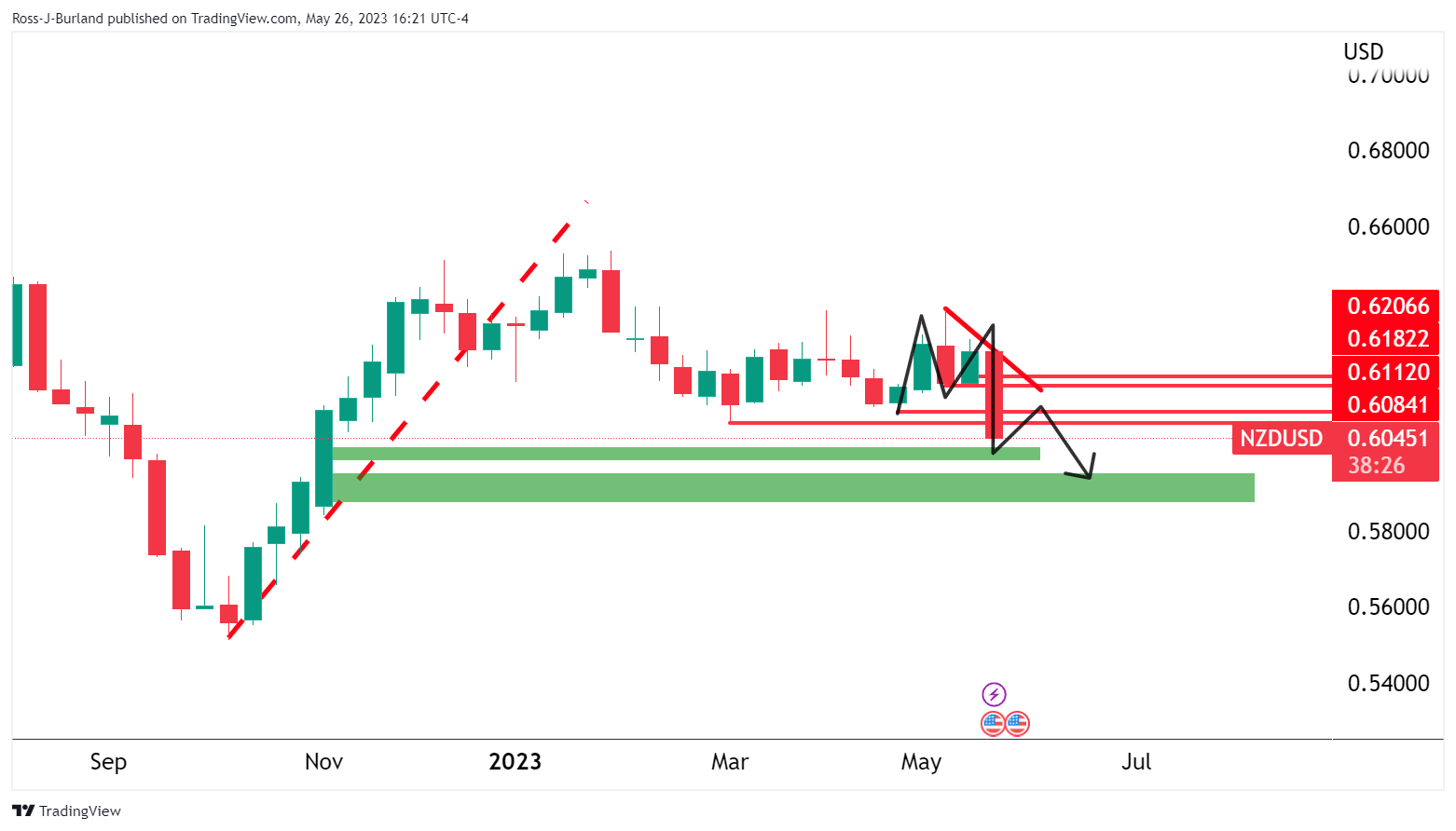
The weekly chart shows the M-formation´s last leg penetrating prior lows that might be regarded as stucture and such a move signifies a market that is breaking down. However, in the meanwhile, a correction could be coming up.
NZD/USD daily chart
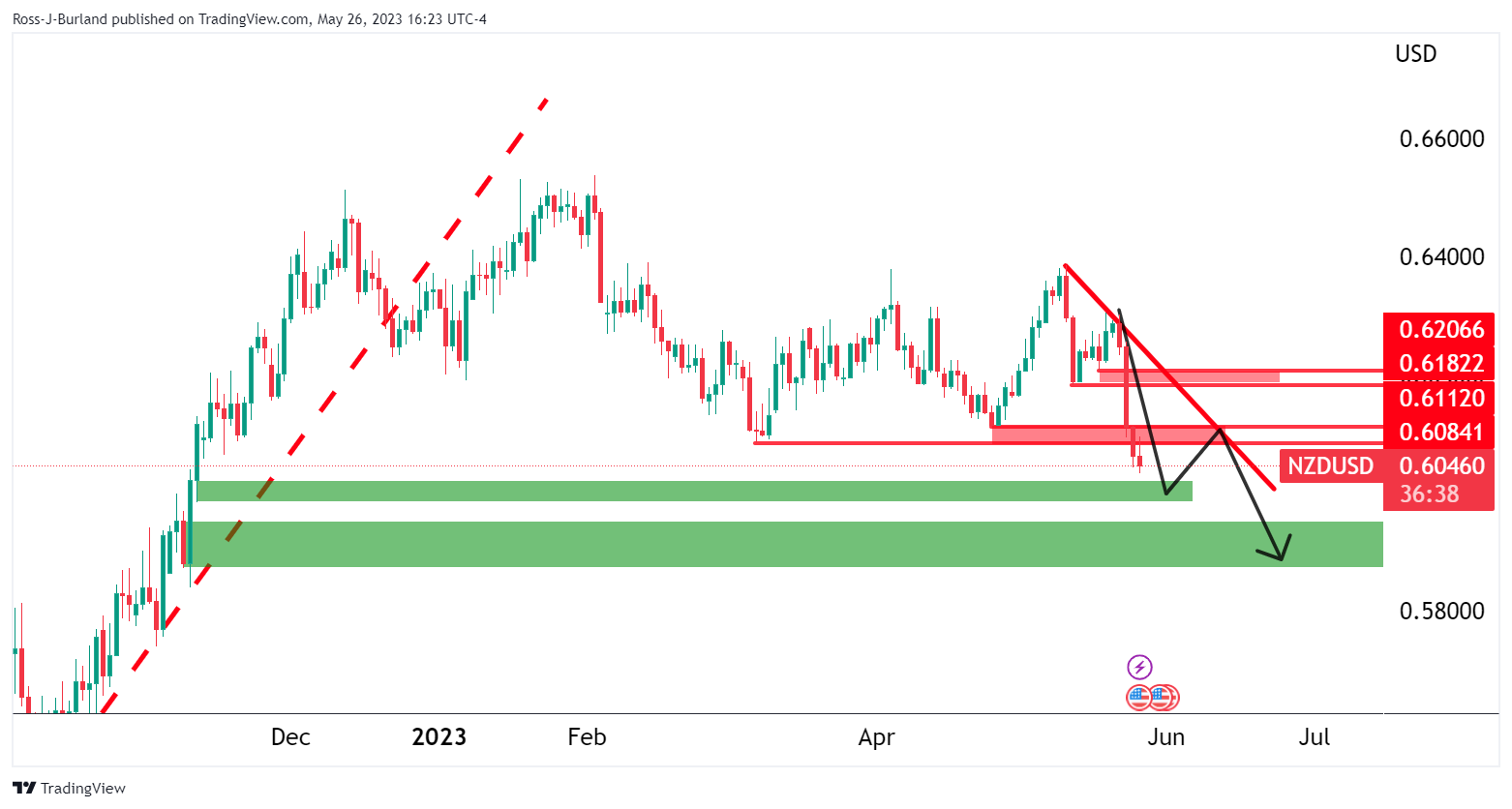
The market is headed toward a support structure but should the bulls turn up, a correction towards 0.6080-0.6112 could be on the cards.
- WTI crude oil closes higher, settling at US$72.67 per barrel, driven by mixed signals from OPEC+ regarding production cuts.
- Ongoing talks between the Biden Administration and House Republicans bring relief as a deal to raise the US debt ceiling nears completion.
- US inflation surges as consumer spending exceeds expectations, with the personal consumption expenditures index rising by 4.4% annually.
Western Texas Intermediate (WTI), the US crude oil benchmark, recovered some lost ground during the week, driven by factors like mixed signals from OPEC+ regarding potential output cuts, ongoing discussions between US politicians about the debt ceiling, and higher-than-expected US inflation.
Mixed signals from OPEC+, progress in US debt-ceiling talks, and higher inflation are impacting the rise of WTI crude oil prices
WTI crude oil trades with gains of $0.99 or 1.35% after hitting a daily low of $71.54, exchanging hands at $72.75 per barrel.
The rise in oil prices comes as conflicting statements emerged from OPEC+'s significant producers. Russia expressed its expectation that there would be no alteration to production quotas during the cartel's meeting, citing the voluntary cuts of over one million barrels per day implemented at the beginning of May. Conversely, Saudi Arabia's oil minister cautioned short sellers to remain vigilant.
The upward trajectory of oil prices also corresponds with reports of progress in negotiations between the Biden Administration and House Republicans concerning a deal to raise the US debt ceiling for two years. This development alleviates concerns that the country would face an unprecedented default on its debt payments.
However, recent data from the US reveals stronger-than-expected consumer spending in the previous month, which increased by 0.5% following a stagnant performance in March. Additionally, the Personal Consumption Expenditures (PCE) index, the Federal Reserve's preferred inflation gauge, rose by 4.4% annually, surpassing the 4.2% growth reported in March.
WTI Technical Levels
- EUR/JPY maintains a bullish outlook, on its weekly high around 150.80.
- Tokyo Consumer Price Index (May) came in below consensus as well as previous values.
- Gross Domestic Product figures from Q1 from Germany came in surprisingly weaker than expected.
The EUR/JPY pair maintains its gains, continuing its upward trajectory for the third consecutive day. Currently, it is oscillating above the significant 150.00 level, signaling a strong bullish sentiment. Despite the recent weakness in Germany's Q1 Gross Domestic Product figures, the pair maintains a positive outlook, even reaching its weekly high around 150.80. However, it is essential to consider the impact of the Tokyo Consumer Price Index (May), which has recently disappointed, falling below both consensus expectations and previous values. Consequently, bond yields have declined, on expectations the Bank of Japan (BoJ) will maintain its age-old ultra-loose stance on interest rates.
Declining German and Japanese yields
German yields have weakened across the curve. The 10-year bond yield experienced a decline to 2.52%, resulting in losses of 0.72% for the day. Similarly, the 2-year yield stands at 2.96% with losses of 0.6%, while the 5-year yield is at 2.54%, showing losses of 0.72%.
In addition, the Japanese yields have also weakened across the curve. The 10-year bond yield dropped to 0.41%, resulting in significant losses of 1.66% for the day. Furthermore, the 2-year yield stands at -0.07% with losses of 3.91%, and the 5-year yield is at 0.10%, showing substantial losses of 8.02% respectively.
Levels to watch
The EUR/JPY has a bullish outlook for the short term, as per the daily chart. The Relative Strength Index (RSI) and Moving Average Convergence Divergence (MACD) are both in positive territory and the pair trades above its main moving averages, indicating that the buyers are in charge.
In case the EUR/JPY exchange rate continues to gain traction, the following resistance levels line up at the psychological mark of 151.00, followed by the monthly high at 151.60 and the 152.00 zone. On the other hand, immediate support for EUR/JPY is seen at the 150.00 level, followed by the 149.20 zone and the 20-day Simple Moving Average at 148.97.
-638207290495151122.png)
- USD/CAD bulls run into a wall of resistance.
- USD/CAD bears are moving in with 1.3570 eyed.
USD/CAD is on track to post a weekly gain as the recent rise in US bond yields helped underpin the greenback. However, a correction is taking place as the following will illustrate.

The price has come up to test a resistance zone but is starting to correct:
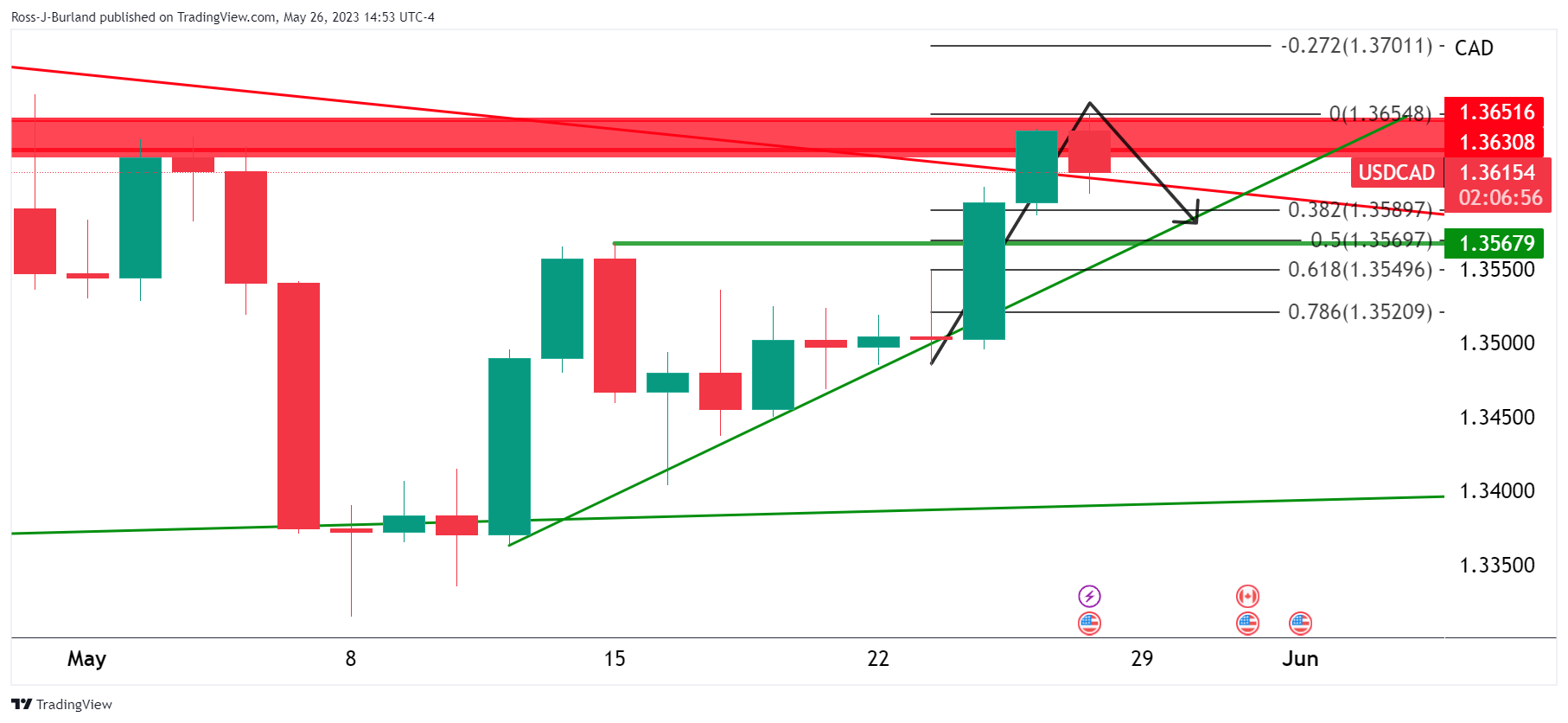
A 50% mean reversion comes in near prior resistance near 1.3570.

On the hourly chart above, we can see that the price is capped in resistance and is making lower highs as the rally decelerates. The market is breaking down on the backside of the prior bullish rally with 1.3570 eyed.
- USD/JPY leaps past the 140.00 mark, despite US economic data suggesting a potential Fed rate hike.
- Japanese Finance Minister Shunichi Suzuki encourages market-determined currency rates, stating that he’s closely monitoring exchange-rate movements.
- USD/JPY, poised to challenge 142.00 once it clears 141.00, finds support at 139.89/140.00, with a deeper fallback to 137.26.
USD/JPY rallied sharply past the 140.00 figure on Friday late in the New York session, after traveling towards its daily low of 139.49, before making a U-turn. Solid economic data from the United States (US) bolstered the odds for another rate hike by the Federal Reserve (Fed), as shown by the market reaction. US Treasury bond yields rose before reversing their course, while the US Dollar weakened. At the time of writing, the USD/JPY is trading at 140.60.
USD/JPY Price Analysis: Technical outlook
After hitting a new year-to-date (YTD) high of 140.72, the USD/JPY retraced somewhat but remains upward biased. Once the USD/JPY cracked the November 30 swing high of 139.89, buyers piled in to break the 140.00 figure despite Japanese Finance Minister Shunichi Suzuki saying that markets should set currency rates based on economic fundamentals. He stated that he’s watching exchange-rate moves closely.
During Friday’s session, USD/JPY continued and extended its gains, but the pair lost momentum as the New York session began to wind down. However, if USD/JPY extends its gains past 141.00, the next resistance would be the 142.00 figure, ahead of testing the November 22 High at 142.24.
Conversely, the USD/JPY first support would be the 140.00 mark, ahead of falling to November 30 previous resistance turned support at 139.89. A dip below could clear the way for the pair to fall toward December 15 daily high at 138.17 before reaching the 20-day Exponential Moving Average (EMA) At 137.26.
USD/JPY Price Action – Daily chart
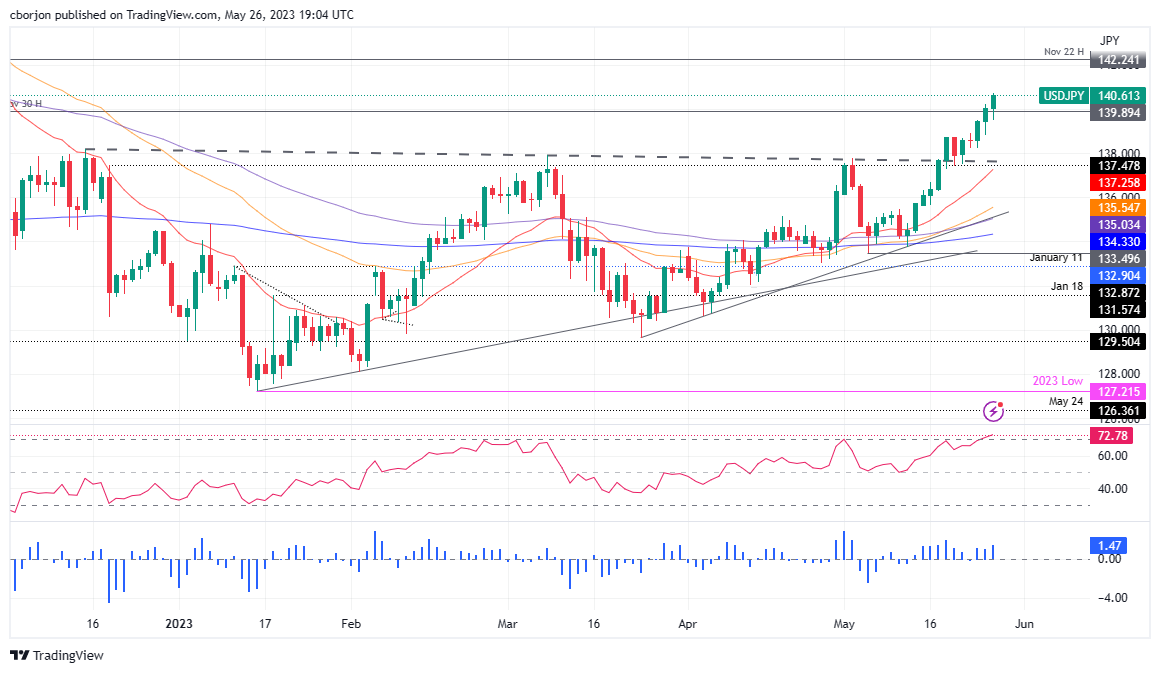
- EUR/USD is on the front side of the bearish trend, submerged in the low 1.07s.
- Bears eye a downside extension for the coming days while below 1.0800.
EUR/USD hit a 9-week low of 1.0701 on the US Dollar´s strength as expectations increased that the US Federal Reserve will deliver another rate hike. The market is penetrating into a key area of potential support as the following will illustrate:
EUR/USD daily charts


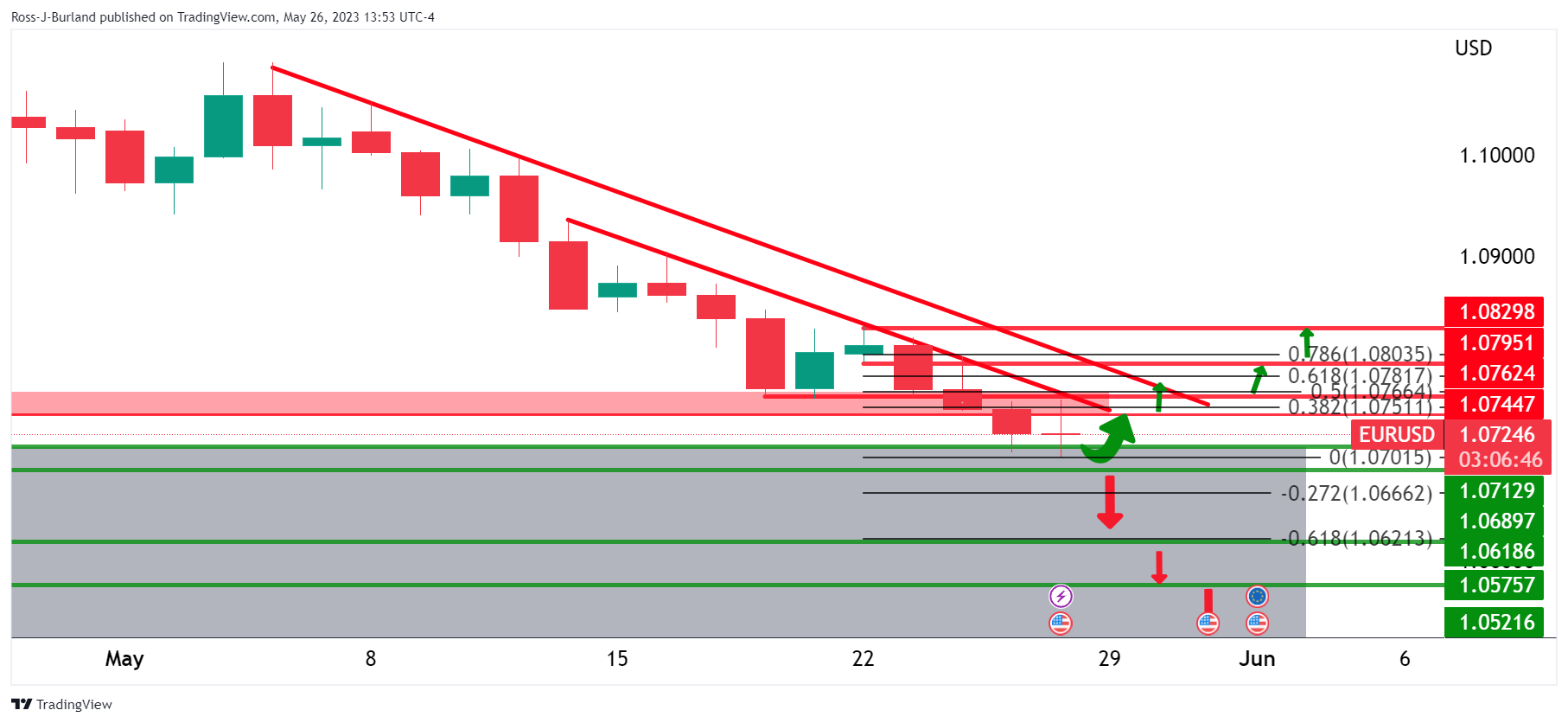

As illustrated in the above daily charts, the price is submerged below the trendline resistance and touching into a space that could give way to a move even lower in the coming days.
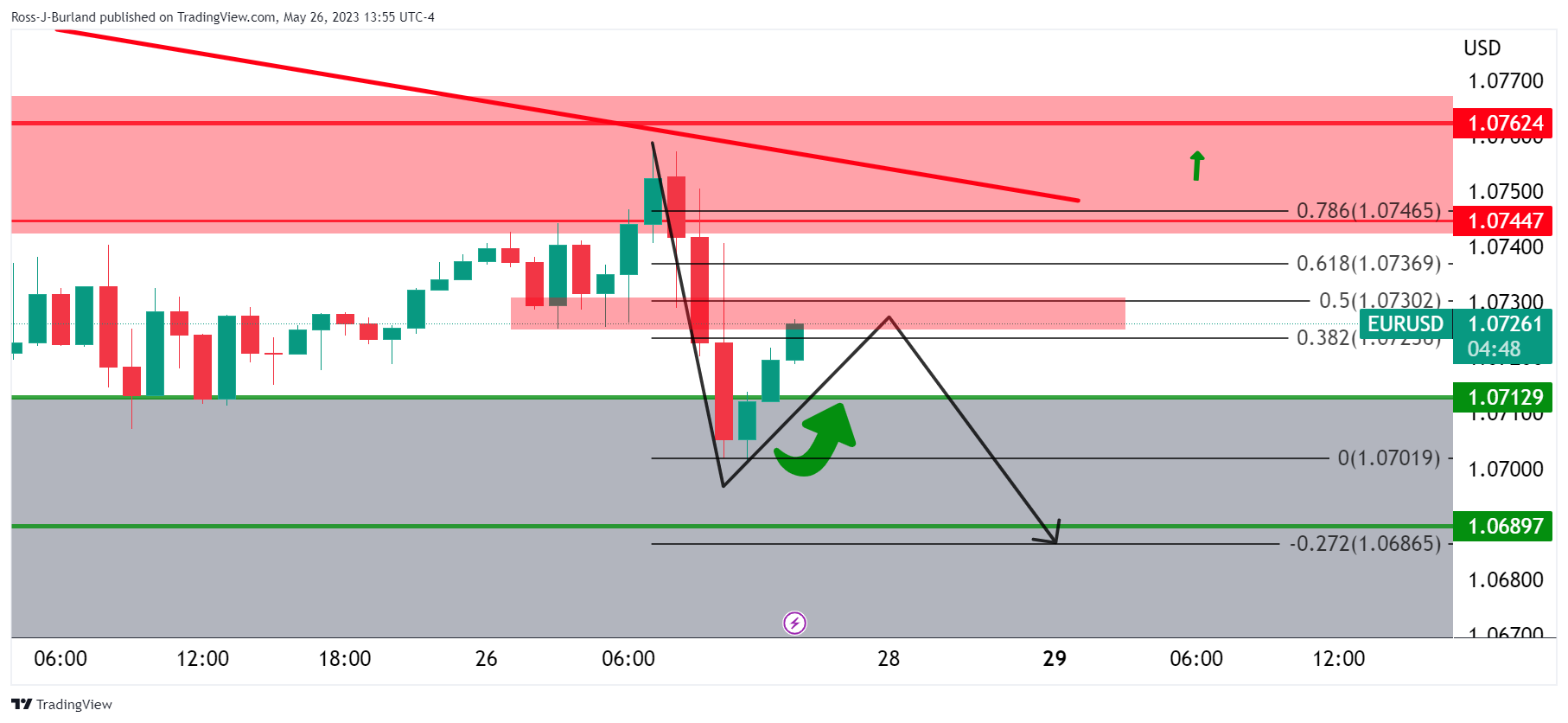
On the hourly chart, the price has broken structure on the left and has found demand around 1.0700. However, if resistance holds, we could see the start of the downside extension.
- GBP/USD recovered from weekly lows, maintaining a position above the 1.2300 figure, while US Treasury bond yields reached their highest since March.
- The Core PCE, Fed’s preferred inflation measure, climbed to 4.7% YoY in April, pushing the odds of a 25 bps rate increase in June to 65.4%.
- Retail sales in the UK skyrocket, reaching their fastest pace in nearly two years, fueling market expectations of a significant bank rate increase, potentially up to 5.50%.
GBP/USD regained some composture past the mid-North American session and bounced off the weekly lows, clinging above the 1.2300 figure amidst a week that witnessed solid US and UK data. Therefore, the GBP/USD stays positive in the day, gains 0.19%, and trades around 1.2340s.
Solid economic data set the stage for possible Fed’s June rate hike, UK Retail Sales at its fastest pace in almost two years
US equities continue to run the Artificial Intelligence (AI) frenzy underpinned by NVIDIA and Maxwell Technologies. The latest tranche of US economic data, with the Fed’s preferred gauge for inflation, the Core PCE rising to 4.7% YoY in April, and headline PCE hitting 4.4% YoY, has increased the odds for additional tightening by the Federal Reserve, with both figures exceeding estimates and previous data. Odds for a 25 bps increase at the June meeting stand at 65.4%, higher than the 17.4% a week before solid data from the US derailed the Fed’s plan to keep rates unchanged.
At the same time, Durable Good Orders printed a positive reading of 1.1% MoM in March, exceeding estimates but showing signs of slowing down, as trailed by March’s 3.3%. Later, the University of Michigan (UoM) Consumer Sentiment exceeded estimates of 57.7 at 59.2 but trailed the 63.5 previous data. Americans inflation expectations cooled down for a one-year horizon is expected at 4.1%, less than the 4.5% revealed in the last report, while for the 5-year horizon, it came at 3.1%, above April’s 3.0%.
Given the backdrop, US Treasury bond yields advance, with the 10-year benchmark note rate at 3.851%, its highest level since March 10, a headwind for the GBP/USD exchange rate. The greenback strengthened, as shown by the US Dollar Index (DXY), up 0.04%, at 104.255. If the DXY achieves a daily close above the 103.752 area, that would confirm the buck’s bullish bias.
Recently, the Cleveland Fed President Loretta Mester stood to her hawkish stance and confirmed that inflation is too high in an interview on CNBC. She said that she would revise her forecast for inflation and that more data would help her to decide on the June meeting while emphasizing that “everything is on the table” for the next FOMC decision.
Aside from this, US debt ceiling talks continued and will resume over the weekend, with both sides confident of achieving a deal before the US Treasury runs out of cash by June 1.
On the UK front, Retail Sales rose to its highest pace in almost two years. That, alongside high inflation data revealed during the week, spurred a reaction in the swaps markets, with most traders expecting at least 100 bps of increase to the bank rate, which would reach 5.50%.
GBP/USD Technical Levels
- USD/CHF surpasses the 0.9050 zone, marking a breakthrough in this resistance.
- The RSI remains in positive territory, approaching the 58.20 level, sustaining a bullish momentum.
- The currency pair is making efforts to reach the 0.9100 level, following three days of gains.
The USD/CHF pair has maintained a neutral stance on Friday but with a positive outlook as it recently surpassed the resistance at the 0.9050 zone and maintains its bullish momentum for the short term. On the daily chart, the Relative Strength Index (RSI) remains in positive territory and is approaching the 58.20 level, while the Moving Average Convergence Divergence (MACD) continues to print green bars. Over the past four days, the pair has shown consistent gains and is striving to reach the 0.9135 level (100-day Simple Moving Average). In that sense, the USD/CHF holds a neutral to bullish bias outlook for the short term.
Levels to watch
If the pair continues to gain momentum, the following resistance levels come into play: first, at the 0.9080 zone, followed by the 0.9100 level, and at the mentioned 0.9135 level. Conversely, immediate support for USD/CHF can be found at the 0.9050 zone level, followed by the 0.9000 level and the 20-day Simple Moving Average (SMA) at 0.8950.
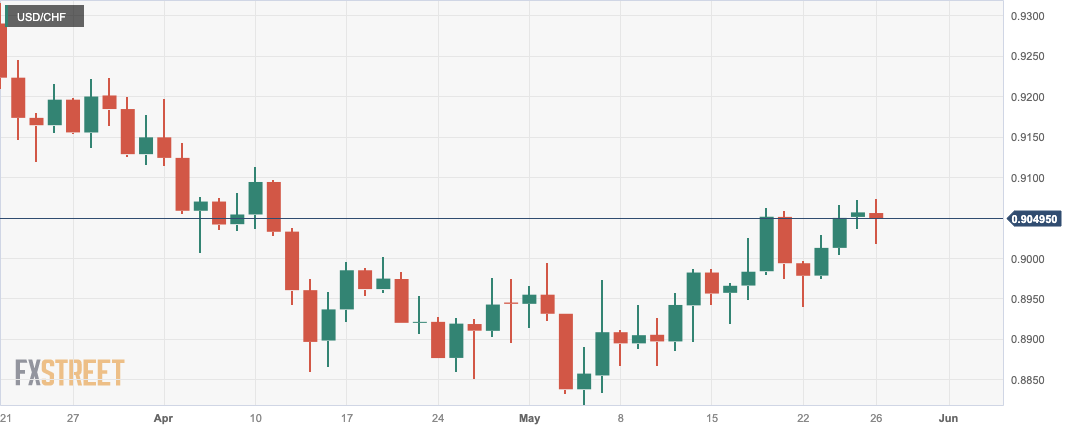
Kristalina Georgieva, Managing Director of the International Monetary Fund, has crossed the wires with the following comments:
- US economy has proven resilient in face of significan fiscal and monetary tightening -article iv review statement.
- Expects US growth to be around 1.2% in 2023, picking up momentum later in 2024.
- US unemployment to rise slowly to close to 4.5% by end-2024.
- Strength in US demand and labor market means a persisten inflation problem.
- Core US inflation will continue to fall during 2023, but remain 'materially above' 2% fed target throughout 2023 and 2024.
- Will be essential for fed to communicate carefully on policy path.
- US interest rates will need to be higher for longer.
- US needs to do more to lower the public debt.
- We are very keen to see a u.s. debt ceiling resolution as soon as possible
- Silver price returns from two-month lows, crosses the 200-day EMA and $23 threshold and ends the week with a 2.89% loss.
- Despite US data supporting another Fed rate hike and subsequent rise in Treasury bond yields, silver price sustains an upward trajectory, targeting the 100-day EMA.
- With the Relative Strength Index indicating potential silver weakness, downside risk remains.
Silver price bounces off two-month-lows hit at $22.68, rallies sharply, and claims the 200-day Exponential Moving Average (EMA) at $22.82 and the $23.00 psychological figure on Friday’s mid-North American session. Although the white metal is gaining more than 1.90%, it is set to finish the week with losses of 2.89%. At the time of writing, XAG/USD is trading at $23.15.
Silver Price Analysis: XAG/USD technical outlook
Even though economic data from the United States (US) justifies another rate hike by the US Federal Reserve (Fed). Therefore, US Treasury bond yields are rising, underpinning the greenback. However, the XAG/USD ignored most factors that could drag the price low and rip higher, eyeing the 100-day Exponential Moving Average (EMA) at $23.47.
Nevertheless, the Relative Strength Index (RSI) is in bearish territory, warranting further Silver weakness, while the 3-day Rate of Change (RoC) has yet to reach neutral levels. Therefore, additional downside could be expected.
However, if XAG/USD clears the 100-day EMA, it would face sold resistance at the confluence of the 20 and 50-day EMAs at around $23.97-24.00. Once broken, the next supply zone would be the $25.00 mark.
On the flip side, and the path of least resistance in the near term, the XAG/USD first support would be $23.00, followed by $22.68, the current week’s low. A beach of the latter will expose the March 21 swing low of $22.14.
Silver Price Action – Daily chart

- AUD/USD sustains bearish momentum, hovers near the psychological level of 0.6500.
- Core PCE from the US rose to 4.7% in April.
- Australia’s Retail Sales rose 0.0% in April, falling short of expectations.
The AUD/USD continues its downward trend, currently trading at its year-low. However, this decline occurs amidst positive economic developments and hot Core PCE inflation from the US which made the market’s discount a higher likelihood of the Federal Reserve (Fed) hiking in the next meeting in June. On the other hand, the Australian Retail Sales from April data indicated no variation in sales levels compared to the previous period. Hence, the current data reported a stagnation.
Australia Retail Sales fall below expectations and markets price in a higher likelihood of a Fed rate hike
In April, the growth of Australian Retail Sales failed to meet expectations, remaining unchanged from March. This lackluster performance reflects the challenges faced by consumers due to the impact of rising interest rates and persistent inflation. With retail turnover falling short of the anticipated 0.2% increase, it indicates a period of stagnation in consumer spending over the past six months. Furthermore, the ongoing rise in the cost of living adds additional strain to consumers' budgets.
Adding to these challenges, the strength of the US Dollar has further contributed to the decline in the AUD/USD currency pair. Core PCE inflation from the US, an important gauge of inflation for the Federal Reserve (Fed), from April came in at 4.7% (YoY) vs the 4.6% expected and from its previous figure of 4.6%.
In that sense, following yesterday’s strong economic data and the hot inflation figures, the CME FedWatch Tool currently indicates a greater likelihood of the Federal Reserve raising interest rates by 0.25% on June 14 giving further support to the US Dollar.
Levels to watch
According to the daily chart, the AUD/USD maintains a bearish outlook in the short term, as indicated by the Relative Strength Index (RSI) and Moving Average Convergence Divergence (MACD), both suggesting that sellers are in control while the pair trades below its main moving averages.
In the event of a decline in the Aussie, immediate support levels are identified at the psychological level of 0.6500, followed by the zone around 0.6545 and the 0.6400 level. Conversely, if the AUD/USD manages to climb higher, the next resistance levels to monitor are at the 0.6540 zone, followed by the psychological level of 0.6600 and the 20-day Simple Moving Average at 0.6650.
-638207164541137858.png)
- US economic strength shown by the latest round of data raises prospects of a June Fed rate hike, boosting the US Dollar.
- Wall Street climbs despite a rise in Fed’s gauge for inflation, with Core PCE hitting 4.7% YoY.
- Rising US Treasury bond yields and Fed hawkish commentary could hurt Gold’s recovery.
Gold price recovers some ground but remains shy of reclaiming the $1950 figure after solid economic data in the United States (US) suggests the Federal Reserve (Fed) could opt to hike again in June. Consequently, US Treasury bond yields are rising, while the US Dollar (USD) hits new two-month highs vs. a basket of peers. The XAU/USD is trading at $1940.21, still up by a minuscule 0.03%.
Wall Street rides high despite inflationary concerns; consumer and business spending showcase resilience
Wall Street registered solid gains, even though the Federal Reserve’s (Fed) preferred gauge for inflation, the Core Personal Consumption Expenditure (PCE), which strips volatile items like food and energy, exceeded estimates of 4.6% and rose by 4.7% YoY in April. Following suit, headline inflation climbed from 4.2% to 4.4% YoY after the Fed released its May meeting minutes, which showed the US central bank’s openness to pause its tightening cycle.
In another data, the final reading of the University of Michigan Consumer Sentiment for May, beat estimates of 57.7 at 59.2 but trailed the 63.5 prior’s reading. The same poll revealed that American citizens’ inflation expectations for one year eased from 4.5% to 4.1% by year’s end, while for a 5-year horizon, they came at 3.1% above April’s 3.0%.
Earlier, Durable Good Orders in April rose by 1.1% MoM, above estimates of a 1% plunge but trailed the staggering March’s 3.3%, indicating that consumer and business spending remains resilient, another reason that justifies Jerome Powell and Co. to continue to lift rates, as the economy opposes resistance to higher interest rates.
Consequently, US Treasury bond yields continued to rise, with the 10-year benchmark note rate at 3.851%, its highest level since March 10, putting a lid on Gold recovery. Another factor that could dent appetite for XAU/USD is US real yields, which stand at 1.60%, higher than Thursday’s close of 1.57%.
Recently, the Cleveland Fed President Loretta Mester stood to her hawkish stance and confirmed that inflation is too high in an interview on CNBC. She said that she would revise up her forecast for inflation and that more data would help her to decide on the June meeting while emphasizing that “everything is on the table” for the next FOMC.
XAU/USD Price Analysis: Technical outlook
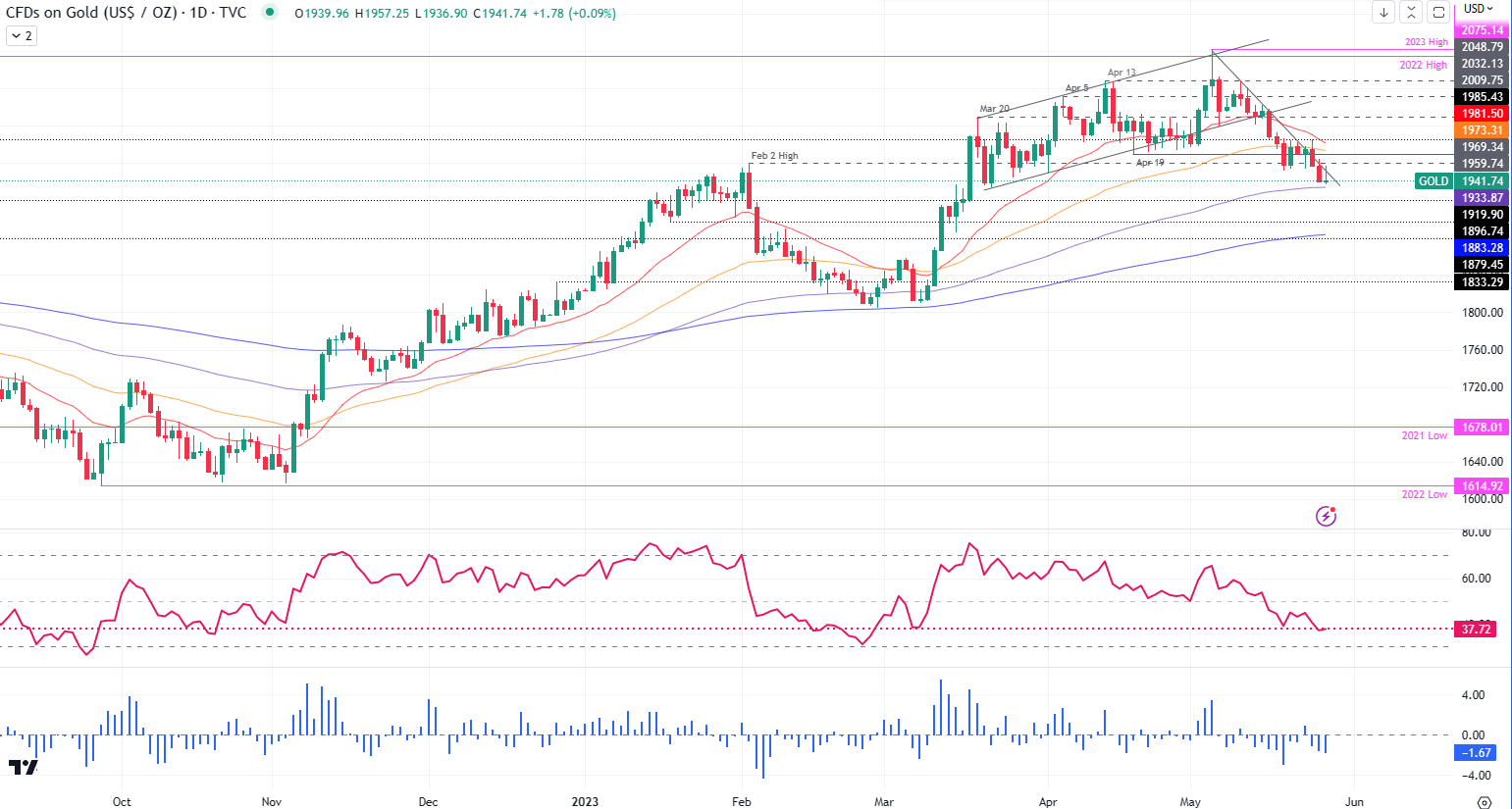
XAU/USD is neutral to downward biased, though it remains trading within the boundaries of important support and resistance levels. As support, the 100-day Exponential Moving Average (EMA) at $1933.85 keeps cushioning God’s fall while the psychological price level of $1950 keeps price action restricted in a $17 range. If XAU/USD sellers claim the former, that could open the door to test the $1900 figure before threatening the 200-day EMA at $1883.27. On the other hand, if XAU/USD buyers conquer the $1950 figure, the yellow metal could be on its way to challenge the $1973.32 area, where the 50-day EMA rests.
In an interview with CNBC on Friday, Federal Reserve Bank of Cleveland President Loretta Mester said that the Personal Consumption Expenditures (PCE) Price Index released on Friday underscored the slow progress on inflation.
Breaking: US Core PCE inflation increases to 4.7% vs. 4.6% anticipated.
“It’s probably not wise to sort of pre-guess what the meeting outcome will be,” Mester said when asked whether another rate increase is warranted at the upcoming FOMC meeting.
Key takeaways
"Tighter monetary policy is still feeding into the economy."
"I may have to revise up my inflation forecast."
"Everything is on the table for the June FOMC meeting."
"Fed is very committed to lowering inflation in timely way."
"Fed still has more data to see ahead of the June FOMC meeting."
"Have not sees much sign of banking stress affecting credit conditions."
"Economy has slowed quite a bit relative to last year."
"Important for the Fed not to under tighten monetary policy."
"Right now is the hard part for monetary policy decisions."
Market reaction
The US Dollar Index stays in positive territory above 104.30 following these comments.
Gold price is under pressure amid dwindling rate cut expectations. Nonetheless, economists at Commerzbank see only limited further downside potential.
Development of physical demand in Asia is hardly likely to influence prices
“Hopes of any rate cuts in the US in the near future have been dampened this week, thereby weighing on the Gold price. A new US labour market report will be published at the end of next week. If it shows a further cooling, as many observers anticipate, this would likely reduce rate expectations, especially if a compromise were to be reached in the US debt dispute, allowing economic indicators to determine the interest rate trajectory again.”
“By contrast, the development of physical demand in Asia, as evidenced by Swiss Gold exports and Chinese Gold imports from Hong Kong, is hardly likely to influence prices, especially as exports and imports will probably turn out to be somewhat weaker given the high price level.”
Economists at ING expect the USD/CAD to move below the 1.30 level by the end of the year.
Short-term headwinds for CAD remain non-negligible
“Short-term headwinds for CAD remain non-negligible, starting from the US banking troubles (Canada is quite exposed), Oil’s uncertain performance and risk instability.”
“In line with our call for USD accelerating its decline in the second half of the year and oil prices to be supported, we think USD/CAD can move sustainably below 1.30 by the end of 2023.”
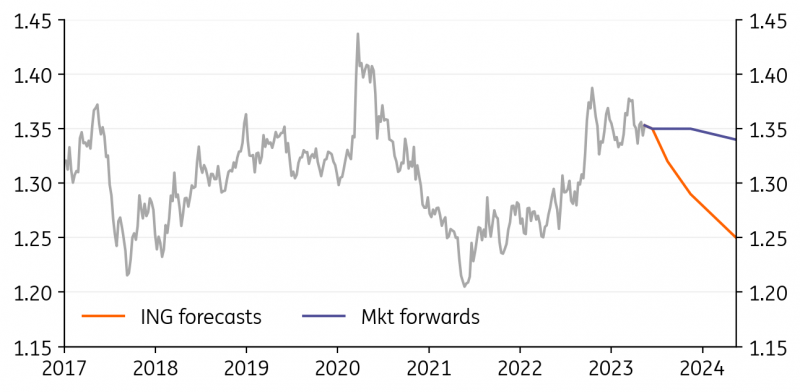
Source: Refinitiv, Macrobond, ING
Economists at Commerzbank discuss EUR/USD outlook.
Upside potential for EUR/USD in the coming months
“In the coming months, EUR/USD is likely to strengthen because the ECB's monetary policy is likely to be more hawkish in the near future and therefore more attractive from a currency market perspective than that of the Fed. Initially, this apparent advantage will come from the fact that the ECB is likely to continue raising interest rates while the Fed is not, and later from the fact that the ECB is sticking to its maximum interest rate level while the Fed is likely to start cutting rates.”
“In the medium term, however, the ECB is probably not really more hawkish than the Fed. On the contrary, the EUR strength we expect in the short term is therefore unlikely to be sustainable. We suspect that the turnaround in the EUR/USD exchange rate could come around the turn of the year.”
Source: Commerzbank Research
- Silver stages a solid rebound from over a two-month low touched this Friday.
- The setup warrants some caution before positioning for any further recovery.
- A sustained move beyond the $24.00 mark could negate the bearish outlook.
Silver gains strong positive traction on Friday and snaps a four-day losing streak to the $22.70-$22.65 area, or over a two-month low touched earlier today. The white metal maintains its bid tone through the early North American session and currently trades around the $23.20-$23.25 zone, up over 2% for the day.
A slightly oversold Relative Strength Index (RSI) on the daily chart turns out to be a key factor that prompts aggressive short-covering around the XAG/USD. That said, this week's convincing break through the 100-day Simple Moving Average (SMA) support and the overnight slide below the 50% Fibonacci retracement level of the March-May rally favour bearish traders. This, in turn, suggests that any subsequent move up might still be seen as a selling opportunity and runs the risk of fizzling out rather quickly.
The 100-day SMA support breakpoint, currently pegged around the $23.35 region, is likely to act as an immediate hurdle. This is followed by 38.2% Fibo. level, near the $23.75 zone, above which the XAG/USD could climb to the $24.00 mark. The latter should act as a pivotal point, which if cleared decisively might trigger a fresh wave of a short-covering move and lift the commodity further beyond the $24.20-$24.25 hurdle. The recovery momentum could get extended towards the $24.50-$24.60 strong support breakpoint.
On the flip side, the monthly low, around the $22.70-$22.65 region, now seems to protect the immediate downside ahead of the 61.8% Fibo. level, near the $22.25 area. Some follow-through selling, leading to a subsequent slide below the $22.00 mark should pave the way for an extension of the recent downfall from over a one-year top touched earlier this month. The XAG/USD might then accelerate the fall towards the $21.55-$21.50 intermediate support before eventually dropping to the $21.00 round-figure mark.
Silver daily chart
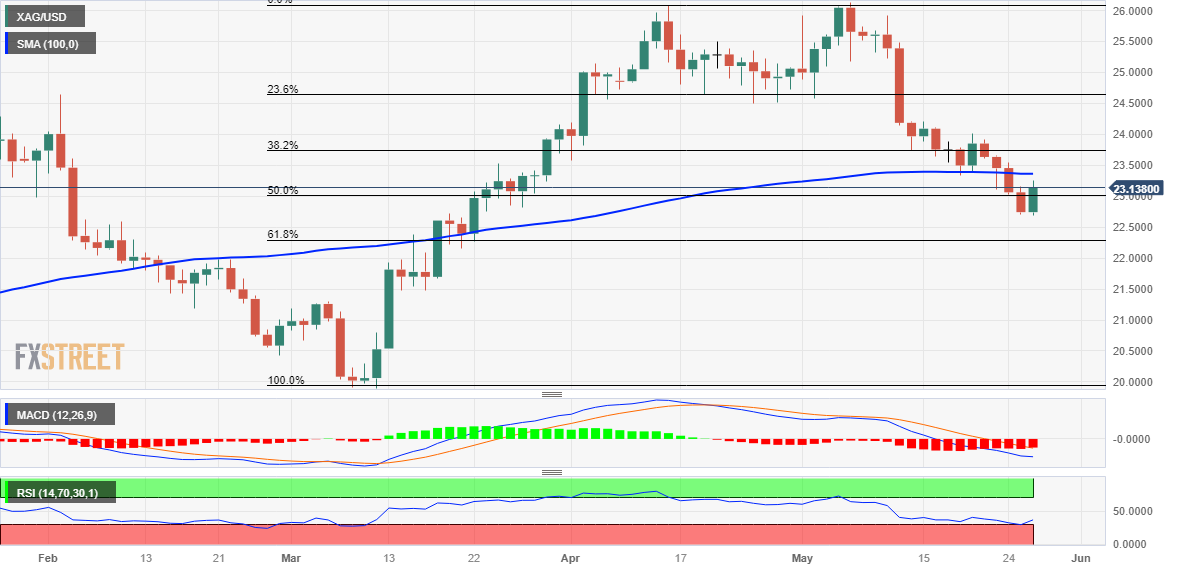
Key levels to watch
- GBP/USD bounces off lows near 1.2300 the figure on Friday.
- The greenback regains composure following US data releases.
- UK Retail Sales surprised to the upside in April.
The British pound regains poise and motivates GBP/USD to reclaim ground lost and advance to the vicinity of the 1.2400 mark at the end of the week.
GBP/USD appears supported near 1.2300
Following an earlier uptick to the boundaries of 1.2400 the figure, GBP/USD now comes under some selling pressure on the back of the rebound in the greenback, which was particularly exacerbated higher US inflation figures tracked by the PCE.
Indeed, further resilience from key US fundamentals motivates the resurgence of the buying interest in the greenback, prompting at the same time the USD Index (DXY) to trim initial losses.
In the meantime, better-than-expected UK Retail Sales for the month of April lent initial legs to the quid and accompanied the move higher in Cable, all in line with rising speculation of further tightening by the BoE at the June 22 event.
GBP/USD levels to consider
As of writing, the pair is gaining 0.19% at 1.2345 and the surpass of 1.2668 (2023 high May 8) would open the door to 1.2864 (200-week SMA) and then 1.3000 (psychological level). On the downside, the next support emerges at 1.2308 (monthly low May 25) seconded by 1.2274 (monthly low April 3) and finally 1.2010 (weekly low March 15).
In the recent period there has been a completely counterintuitive mechanism: the Dollar is a safe haven currency and appreciates, even when difficulties arise in the United States, analysts at Natixis report.
In the spring of 2023, all ingredients are normally in place for the USD to weaken
“In the spring of 2023, all the ingredients are normally in place for the Dollar to weaken: Very weak growth prospects in the United States; Risk of default on US public debt due to the debt ceiling; Banking crisis affecting more and more regional banks; Consumer confidence indices down in April.”
“However, the Dollar is not depreciating but, on the contrary, appreciating against all currencies: the USD is a safe haven even when the United States is in trouble, which is paradoxical.”
GBP/USD has found firm support in the low 1.23 zone over the past 24 hours. Economists at Scotiabank analyze the pair’s technical outlook.
Intraday performance looks solid
“Steady gains so far today suggest a mild improvement in its technical tone at least.”
“Short-term trend momentum is positive but that is overshadowed by bearish-leaning signals on the longer run studies. Still, the intraday performance looks solid and regaining the mid-1.23 area (formerly support) gives the technical tone a further (short-term, at least) lift.”
“Resistance is 1.2395/00 and (stronger) at 1.2425. Gains through the latter point would be more generally constructive.”
- USD/JPY attracts some dip-buying on Friday and climbs to a fresh YTD top in the last hour.
- The USD pares modest intraday losses after stronger US PCE data and acts as a tailwind.
- The Fed-BoJ policy divergence favours bulls and supports prospects for additional gains.
The USD/JPY pair reverses an intraday dip to the 139.50 area and climbs to a fresh YTD peak in reaction to the stronger US PCE Price Index. The pair is currently placed just above the 140.00 psychological mark and seems poised to prolong its recent upward trajectory witnessed over the past two weeks or so.
The US Dollar (USD) reverses a part of its modest intraday profit-taking slide after the US Bureau of Economic Analysis (BEA) reported that the headline PCE Price Index rose 0.4% in April as compared to 0.1% in the previous month. Adding to this, the yearly rate accelerated to 4.4% against expectations for a fall to 3.9% from 4.2% in March. Additional details revealed that the Core PCE Price Index - the Fed's preferred inflation gauge - edged higher to 4.7% from 4.6%, beating consensus estimates.
The data reaffirmed market expectations that the Federal Reserve (Fed) will keep interest rates higher for longer, which, in turn, lends some support to the Greenback and acts as a tailwind for the USD/JPY pair. In fact, the markets are now pricing in over a 50% chance of another 25 bps lift-off at the June FOMC meeting. This is reinforced by a fresh leg up in the US Treasury bond yields, widening the US-Japan rate differential and contributing to driving flows away from the Japanese Yen (JPY).
Apart from this, a more dovish stance adopted by the Bank of Japan (BoJ) might continue to undermine the JPY and suggests that the path of least resistance for the USD/JPY pair is to the upside. Even from a technical perspective, the emergence of some dip-buying on Friday and acceptance above the 140.00 mark add credence to the constructive setup. Hence, some follow-through strength towards the next relevant hurdle, around the 140.45-140.50 region, looks like a distinct possibility.
Technical levels to watch
- Durable Goods Orders in the US rose unexpectedly in April.
- US Dollar Index stays in daily range at around 104.00.
Durable Goods Orders in the US increased by 1.1%, or $3.1 billion, in April to $283 billion, the US Census Bureau announced on Friday. This reading followed the 3.3% increase recorded in March and came in better than the market expectation for a decrease of 1%.
"Excluding transportation, new orders decreased 0.2%," the publication further read. "Excluding defense, new orders decreased 0.6%. Transportation equipment, also up two consecutive months, drove the increase, $3.5 billion or 3.7% to $97.6 billion."
Market reaction
This report failed to trigger a noticeable reaction in the US Dollar Index, which was last seen losing 0.15% on the day at 104.05.
EUR/USD gains modestly as support in the low 1.07 area holds. Economists at Scotiabank analyze the pair’s technical outlook.
Not out of the woods just yet
“Gains are marginal and are not – yet– indicative of a firm technical base in place.”
“Price could be consolidating ahead of another push lower. Still, if the 1.0726 point can hold on a weekly close basis, the EUR may have the technical chops to push a little higher still next week.”
“Gains through 1.0755/65 would be technically positive. A clear push under the low 1.07s would, on the other hand, pave the way for a drop to 1.05.”
Economist at UOB Group Lee Sue Ann comments on the upcoming monetary policy meeting by the BoE.
Key Takeaways
“Headline CPI inflation eased to 8.7% y/y in Apr, from 10.1% y/y in Mar. The reading was above estimates of 8.2% y/y. Core CPI inflation, however, surprised on the upside, climbing 6.8% y/y from 6.2% y/y in Mar.”
“While the unemployment rate unexpectedly rose to 3.9% in the three months to Mar, as more people sought to get back into the jobs market; pay growth, which is at the heart of the Bank of England (BOE)’s debate about whether to raise rates further, remained strong by historical standards.”
“Taking into account the BOE’s guidance and the latest slew of economic data releases, we now look for a 25bps rate hike at the next BOE monetary policy meeting on 22 Jun.”
- AUD/USD trims a part of its intraday recovery gains from a fresh YTD low touched on Friday.
- The USD bounces off the daily low in reaction to the stronger US PCE data and caps the pair.
- The fundamental backdrop favours bearish traders and supports prospects for further losses.
The AUD/USD pair stages a goodish rebound from sub-0.6500 levels, or the lowest level since November 2022 and maintains its bid tone through the early North American session on Friday. Spot prices, however, remain below mid-0.6500s and retreat a few pips from the daily peak following the release of the US macro data.
The US Dollar (USD) trims a part of its intraday losses in reaction to the stronger Personal Consumption Expenditure (PCE) Price Index data and acts as a headwind for the AUD/USD pair. The US Bureau of Economic Analysis (BEA) reported that the headline PCE Price Index rose 0.4% in April as compared to 0.1% in the previous month and the yearly rate accelerated to 4.4% against expectations for a fall to 3.9% from 4.2% in March. Furthermore, the Core PCE Price Index - the Fed's preferred inflation gauge - also came in higher than consensus estimates and reaffirms speculations that the Federal Reserve (Fed) will keep interest rates higher for longer, which, in turn, lends some support to the Greenback.
Hawkish Fed expectations, meanwhile, trigger a fresh leg up in the US Treasury bond yields, which, along with the caution mood, further benefits the safe-haven buck and contributes to capping the risk-sensitive Aussie. This, to a larger extent, helps offset the disappointing release of US Durable Goods Orders data, which fell by 0.6% in April vs. a modest 0.1% rise estimated and the 3.2% (revised down from 3.5%) strong growth recorded in the previous month. With the USD bulls looking to seize back control, speculations that the Reserve Bank of Australia (RBA) might refrain from hiking interest rates in June suggest that the path of least resistance for the AUD/USD pair is to the downside.
Bearish traders, however, might prefer to wait for a sustained break and acceptance below the 0.6500 psychological mark before placing fresh bets. Nevertheless, spot prices remain on track to register heavy weekly losses and record the lowest weekly close since October 2022.
Technical levels to watch
- EUR/USD attempts a bounce to the 1.0750 region on Friday.
- The resumption of the selling bias could challenge 1.0700 once again.
EUR/USD remains under pressure despite the ongoing bounce off recent multi-week lows in the proximity of the 1.0700 neighbourhood.
The loss of the so far decent contention area around 1.0700 could force the pair to extend the bearish move to the March low of 1.0516 (March 15), just ahead of the 2023 low of 1.0481 (January 6).
Looking at the longer run, the constructive view remains unchanged while above the 200-day SMA, today at 1.0481.
EUR/USD daily chart
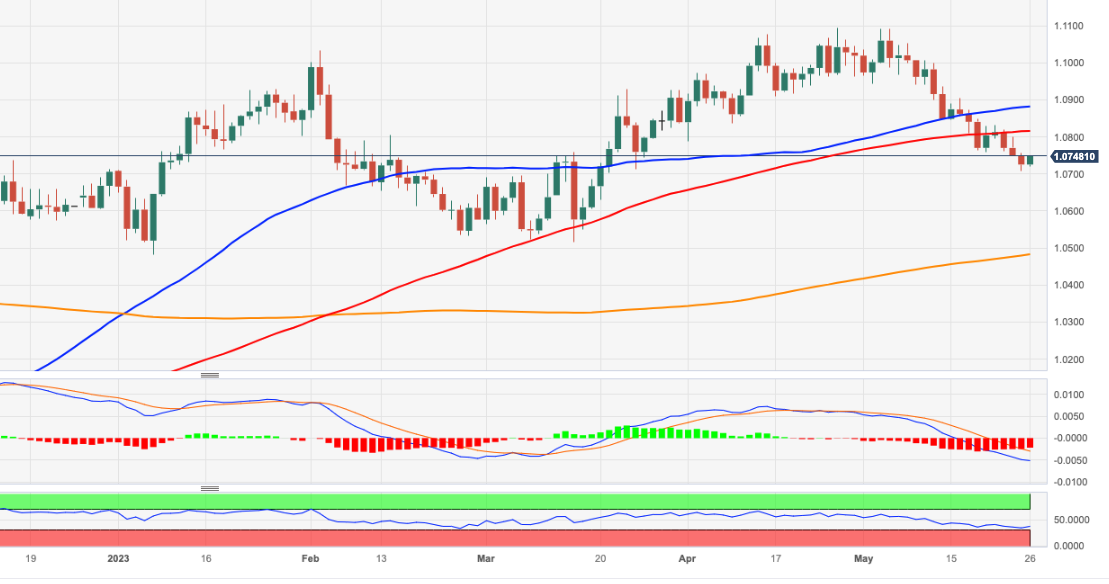
- Oil price recovers after the steep sell-off on Thursday due to mixed messaging from OPEC+ members.
- Russia’s Novak says production cuts are unlikely whilst Saudi Oil Minister seems to imply the opposite.
- US Dollar corrects after strong rally, giving Oil a backdraught.
Oil price steadies on Friday after the previous day’s tumble, as traders weigh conflicting messages from two of the largest members of OPEC+ and the US Dollar weakens. Russia’s Deputy Prime Minister Alexander Novak said that he did not think further cuts would be announced, when only a few days earlier, the Saudi Oil Minister, Prince Abdulaziz bin Salman, seemed to suggest the opposite. The next OPEC+ meeting is on June 4.
At the time of writing, WTI Oil is trading in the upper $72s and Brent Crude Oil in the upper $76s.
Oil news and market movers
- Russia’s Novak plays down the idea of production cuts, saying, “I don't think that there will be any new steps, because just a month ago certain decisions were made regarding the voluntary reduction of oil production by some countries..."
- This seems to contradict comments from Saudi Oil Minister, Prince Abdulaziz bin Salman, who said on Tuesday speculators (interpreted as short-sellers by the media) should “watch out”, seeming to imply OPEC+ may announce cuts.
- Abdulaziz defended OPEC’s decision to cut production by 2 million barrels per day (bpd) at its meeting in October 2022. Given the Oil price is at similar levels to October, it further suggests a possible supply cut in June.
- The US Dollar weakens on Friday as traders take profit after the recent rally and cautiously await Core Personal Consumption Expenditure (PCE) data – the US Federal Reserve’s preferred inflation gauge – and Durable Goods data out at 14:30 GMT.
- A lack of traction in US debt-ceiling talks weighs on the Oil price as it raises the specter of the US defaulting, triggering a global recession.
- That said, past experience points to a high likelihood of the two parties agreeing a last minute deal which will act as a bullish catalyst for Oil.
Crude Oil Technical Analysis: Triangle formation hinting end of downtrend?
WTI Oil is in a long-term downtrend from a technical perspective, making successive lower lows. Given the old adage that the trend is your friend, this favors short positions over long positions. WTI Oil is trading below all the major daily Simple Moving Averages (SMA) and all the weekly SMAs except the 200-week, which is at $66.90.
-638207004306282806.png)
WTI US Oil: Daily Chart
A right-angled triangle has probably finished forming since price recovered from the May 4 YTD lows, as shown by the dotted lines on the chart above.
There is a chance the triangle might break out in either direction, but it is biased to break higher because the top border is very flat (it is right-angled). A breakout higher could see price rise in a volatile rally to a potential target in the $79.70s, calculated by using the usual technical method, which is to take 61.8% of the height of the triangle and extrapolate it from the breakout point higher. Oil price could even go as far as a 100% extrapolation in bullish cases, however, the 61.8% level roughly coincides with the 200-day SMA and the main trendline for the bear market, heightening its importance as a key resistance level.
Assuming Oil price reaches its target, a bullish break would also signify that price had surpassed the $76.85 lower high of April 28, thereby, bringing the dominant bear trend into doubt.
The three green bars in a row that represent the rally this week and the tentative breakout above the topside of the triangle, that accompanied Wednesday’s rally, are a bullish sign. It suggests there is still a chance price could recover after Thursday’s sell-off and eventually continue breaking out higher.
As well as the triangle, the long hammer Japanese candlestick pattern that formed at the May 4 (and year-to-date) lows is a sign that it could be a key strategic bottom.
Further, the mild bullish convergence between price and the Relative Strength Index (RSI) at the March and May 2023 lows – with price making a lower low in May that is not matched by a lower low in RSI – is a sign that bearish pressure is easing.
That said, until Oil price actually climbs above the $76.85 mark, the downtrend is dominant, and there is still a possibility WTI Oil price could break out lower. A decisive piercing below the triangle’s lower border would be required for confirmation, targeting $67.27, which is just above where the 200-week SMA is located and likely to offer good support. Traders might even wish to wait for a break below the lows of the triangle’s Wave B at $69.40 for added confirmation.
-638207004822323375.png)
WTI US Oil: Weekly Chart
A break below the year-to-date (YTD) lows of $64.31 would be required to re-ignite the downtrend, with the next target at around $62.00 where trough lows from 2021 will come into play, followed by support at $57.50.
WTI Oil FAQs
What is WTI Oil?
WTI Oil is a type of Crude Oil sold on international markets. The WTI stands for West Texas Intermediate, one of three major types including Brent and Dubai Crude. WTI is also referred to as “light” and “sweet” because of its relatively low gravity and sulfur content respectively. It is considered a high quality Oil that is easily refined. It is sourced in the United States and distributed via the Cushing hub, which is considered “The Pipeline Crossroads of the World”. It is a benchmark for the Oil market and WTI price is frequently quoted in the media.
What factors drive the price of WTI Oil?
Like all assets, supply and demand are the key drivers of WTI Oil price. As such, global growth can be a driver of increased demand and vice versa for weak global growth. Political instability, wars, and sanctions can disrupt supply and impact prices. The decisions of OPEC, a group of major Oil-producing countries, is another key driver of price. The value of the US Dollar influences the price of WTI Crude Oil, since Oil is predominantly traded in US Dollars, thus a weaker US Dollar can make Oil more affordable and vice versa.
How does inventory data impact the price of WTI Oil
The weekly Oil inventory reports published by the American Petroleum Institute (API) and the Energy Information Agency (EIA) impact the price of WTI Oil. Changes in inventories reflect fluctuating supply and demand. If the data shows a drop in inventories it can indicate increased demand, pushing up Oil price. Higher inventories can reflect increased supply, pushing down prices. API’s report is published every Tuesday and EIA’s the day after. Their results are usually similar, falling within 1% of each other 75% of the time. The EIA data is considered more reliable, since it is a government agency.
How does OPEC influence the price of WTI Oil?
OPEC (Organization of the Petroleum Exporting Countries) is a group of 13 Oil-producing nations who collectively decide production quotas for member countries at twice-yearly meetings. Their decisions often impact WTI Oil prices. When OPEC decides to lower quotas, it can tighten supply, pushing up Oil prices. When OPEC increases production, it has the opposite effect. OPEC+ refers to an expanded group that includes ten extra non-OPEC members, the most notable of which is Russia.
Economists at Société Générale expect the EUR/USD pair to race higher driven by relative natural rates.
Do ‘natural’ interest rate trends suggest a stronger Euro ahead?
“The New York Fed has now updated its estimates of natural rates and its work suggests that the European natural (real) rate has risen from a low of 38 bps in mid-2020 to 83 bps now, while the US rate has fallen from 0.9% to 0.7%. This isn’t going to do anything to help the Euro in the short run, but it raises the possibility that when (if) the Fed and ECB can get rates back to a neutral setting, we should see ECB rates move higher than Fed rates, which hasn’t happened since 2011.”
“EUR/USD almost broke above 1.50 in that cycle and while that seems inconceivable, we’re more optimistic than we have been for a while, that we’ll see EUR/USD above 1.30 again, once the war in Ukraine and Europe’s energy troubles are behind us.”
Economists at Commerzbank discuss BCB’s policy outlook and its implications for the USD/BRL pair after yesterday’s inflation figures.
Interest rate cuts in Brazil getting closer
“Yesterday's weaker-than-expected inflation data for mid-May boosted expectations of a rate cut in Brazil and weakened the real. We also see room for a rate cut.”
“Critically, the government continues to call for interest rate cuts. In order to maintain credibility in the market and ensure the stability of the BRL, the Brazilian central bank must make it clear that rate cuts, if they come, are fundamentally justified and not the result of pressure from the government.”
“We expect the BCB to initiate the rate cut cycle cautiously in order to avoid speculation about government influence. Accordingly, the Real depreciated yesterday, but is still trading at high levels against the US Dollar. We see confirmation of our view that the lows for USD/BRL are in the 4.90-5.00 range.”
Senior Economist at UOB Group Alvin Liew assesses the latest GDP figures for the January-March period in Singapore.
Key Takeaways
“Singapore’s final 1Q23 GDP growth coming in at 0.4% y/y (-0.4% q/q SAAR) revised up from the prelim estimate of 0.1% y/y (-0.7% q/q SA), compared to the 2.1% y/y (+0.1% q/q) growth in 4Q22. Despite the revision, 1Q’s y/y growth was still the weakest since 1Q 2021. It was, however, higher than our and Bloomberg median estimate of 0.2% y/y, -0.6% q/q.”
“Growth was dragged by manufacturing sector (-4.8% q/q, -5.6% y/y) in 1Q with all major sectors within manufacturing recording declines in output except transport engineering. Services supported growth with aviation- and tourism related sectors outperforming but trade-related services weighed on growth. Construction activity supported growth although its 1Q pace was revised lower.”
“The MTI in their outlook, was more downbeat about the US and Europe but more positive on China (seeing its recovery to be stronger than expected while noting the downside risks). MTI also warned of a more prolonged and deeper electronics downturn and highlighted two increasing downside risks to the global economy: 1) tightening of global financial conditions and 2) escalations in the Russia-Ukraine war and geopolitical tensions among major global powers. The MTI maintained its previous forecast for the Singapore economy to grow by 0.5-2.5% in 2023, adding that growth will likely be in the mid-point of the range (i.e. 1.5%). In comparison, we still expect full year GDP growth at 0.7% in 2023 (lower end of the official growth forecast range) reflecting our more cautious external outlook. There is a substantial risk Singapore may enter a technical recession in 1H 2023, largely driven by the weakness in manufacturing.”
“Singapore’s headline inflation rose to 5.7% y/y in Apr from 5.5% y/y in Mar. The core inflation remained elevated at 5.0% y/y (unchanged from Mar). The MAS kept its inflation forecasts (that were first made in the 14 Oct 2022 MPS) unchanged in the Apr CPI report and said core inflation rate will remain ‘elevated in the next few months’ but ‘will remain on a broad moderating path’ and ‘to slow more discernibly in the second half of the year’. However, the MAS omitted the previous mention that ‘MAS Core Inflation is projected to reach around 2.5% y-o-y by the end of 2023’.”
“MAS Outlook – Keeping Our View Of Status Quo For Oct 2023: While inflation concerns remained in the latest Apr inflation print, it was also evident that the growth outlook has been also subject to greater uncertainty and biased to the weaker side. That said, it is also too soon to expect monetary policy to reverse part of its restrictive stance given the stickiness of core inflation. On the balance of sticky Apr inflation and a weaker growth outlook, we keep the view that the tightening cycle to have ended in Apr and the MAS to maintain this pause in the next Oct meeting. If there is another off-cycle announcement before Oct, we think it will likely be due to a sudden worsening in external conditions leading to a sharp downgrade in growth outlook, so the MAS will likely shift to a more accommodative policy rather than further tightening in its next move, but that is not our base case to expect an off-cycle policy announcement for now.”
- DXY meets some resistance around the 104.30 region so far.
- Extra upside should face the key 200-day SMA near 105.70.
DXY retreats for the first session after four consecutive daily gains, putting the 104.00 region to the test at the end of the week.
Further upside appears on the cards in the near term. That said, the next resistance level of note is expected at the key 200-day SMA, today at 105.69 ahead of the 2023 top of 105.88 (March 8).
Looking at the broader picture, while below the 200-day SMA the outlook for the index is expected to remain negative.
DXY daily chart
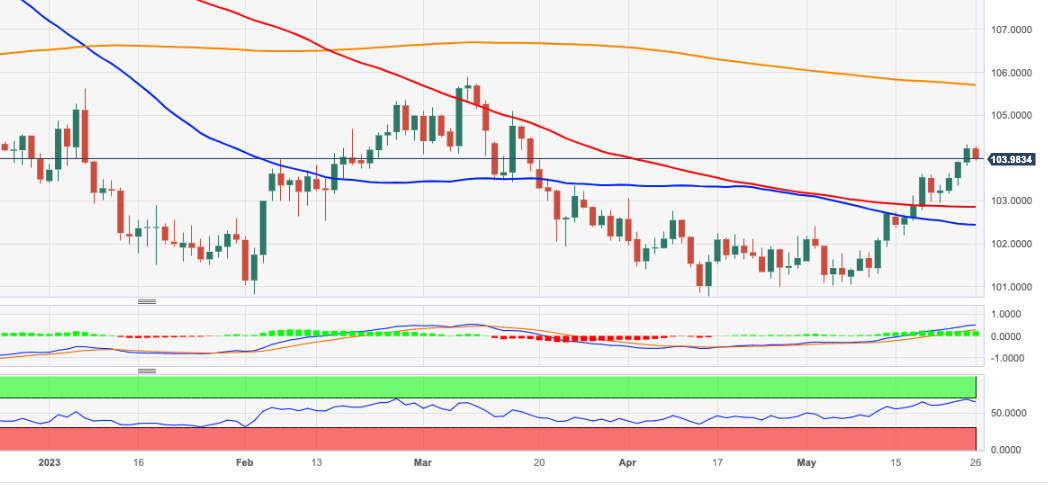
UK rate pricing is heading into recession-inducing Subsequently, Sterling is set to suffer, Kit Juckes, Chief Global FX Strategist at Société Générale, reports.
Sterling’s last hurrah?
“Jeremy Hunt, the UKL’s Chancellor told Sky News that ‘It’s not a trade-off between tackling inflation and recession, in the end the only path to sustainable growth is to bring down inflation’ as he expressed support for tighter monetary policy even if the economy suffers.”
“If the K does raise rates by another 1%, as is priced by markets, and all that talk of long and variable lags between monetary policy implementation and when it takes effect on the economy are ignored, yet again, recession seems certain. How high will Sterling climb from here before it starts falling? Given how much is priced into the curve, this is surely the last leg of the GBP rally.”
- EUR/JPY extends the upside past the 150.00 hurdle.
- Extra gains could see the 2023 peak near 151.60 revisited.
EUR/JPY climbs for the third session in a row and briefly surpasses the key 150.00 barrier on Friday.
While the likeliness of further consolidation appears a plausible near-term scenario, a convincing breakout of the key round level at 150.00 could encourage the cross to dispute the 2023 top at 151.61 (May 2) in the not-so-distant future.
So far, further upside looks favoured while the cross trades above the 200-day SMA, today at 143.62.
EUR/JPY daily chart
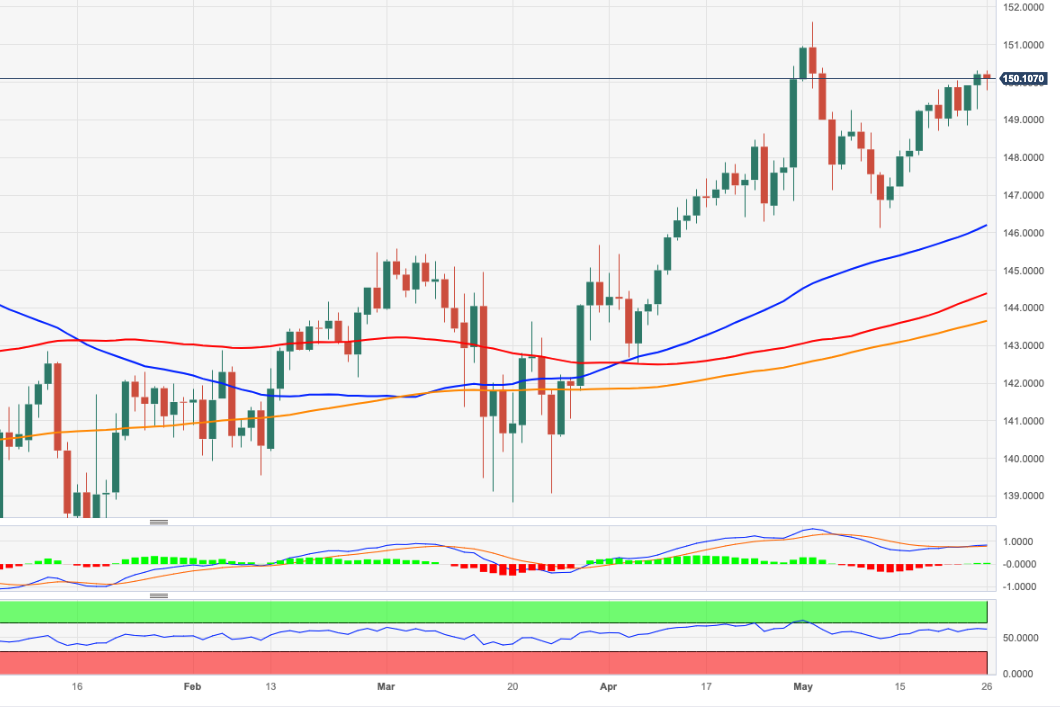
- USD/CAD pulls back from a nearly one-month high and is pressured by a combination of factors.
- A pickup in Oil prices undermines the Loonie and weighs on the pair amid a modest USD slide.
- Hawkish Fed expectations should help limit the downside ahead of the US Core PCE Price Index.
The USD/CAD pair retreats from a nearly one-month high, around the 1.3655 region touched earlier this Friday and remains on the defensive through the mid-European session. The pair languishes near the lower of the daily trading range and is pressured by a combination of factors, though manages to hold its neck above the 1.3600 round-figure mark.
Crude Oil prices gain some positive traction and recover a part of the previous day's slump, which, in turn, is seen underpinning the commodity-linked Loonie. The US Dollar (USD), on the other hand, pulls back from over a two-month high set on Thursday amid a modest downtick in the US Treasury bond yields and further contributes to a mildly offered tone surrounding the USD/CAD pair. That said, the uncertainty over OPEC’s plans for future production cuts, along with worries that a global economic slowdown will dent fuel demand, keep a lid on any meaningful upside for Oil prices.
Apart from this, expectations that the Federal Reserve (Fed) will keep interest rates higher for longer favour the USD bulls and should help limit the downside for the USD/CAD pair, at least for the time being. In fact, the markets started pricing in the possibility of another 25 bps lift-off at the June FOMC meeting following the recent hawkish comments by a slew of US central bank officials. Furthermore, Thursday's better-than-expected US macro data pointed to a resilient US economy and should allow the Fed to stick to its hawkish stance to combat stubbornly high inflationary pressures.
Hence, the market focus will remain glued to the release of the US Core PCE Price Index - the Fed's preferred inflation gauge - due later during the early North American session. Friday's US economic docket also features Durable Goods Orders, which, along with the US bond yields and the US debt ceiling crisis, will drive the USD demand. Apart from this, Oil price dynamics might provide some impetus to the USD/CAD pair. Nevertheless, spot prices remain on track to register strong weekly gains, though bulls might wait for a move beyond the 1.3665-1.3670 area before placing fresh bets.
Technical levels to watch
Since the beginning of May, the SEK has depreciated significantly again. The weakness of the Krona may become too much for the Riksbank and may act, economists at Commerzbank report.
Rate hikes should be the Riksbank's first choice against currency weakness
“Rate hikes should be the Riksbank's first choice against currency weakness, as intervening in the currency market (in this case in favor of its own currency) would be a ‘leaning against the wind’ strategy with questionable chances of success. Therefore, it will be particularly interesting to see whether the Riksbank's last rate hike really comes at the end of June or not.”
“As long as the US debt crisis continues to unsettle the markets, even strong words from the Riksbank will have little effect and the SEK will remain under pressure for the time being.”
See – EUR/SEK: Krona’s near-term outlook remains grim – ING
Economists at Société Générale analyze USD/JPY technical outlook.
Defending 138/137.20 an lead to continuation in up move
“USD/JPY broke out above the upper end of its range since December and has achieved the earlier highlighted target of 140.30 representing projections. An initial pullback is not ruled out however the 200-DMA near 138/137.20 should be an important support zone. Defending this can lead to continuation in up move.”
“Beyond 140.30, next potential hurdles are located at the upper limit of a multi-month channel near 141.60 and 142.50/142.80.”
- GBP/USD stages a goodish recovery from its lowest level since April amid modest USD weakness.
- The British Pound draws additional support from the better-then-expected UK Retail Sales figures.
- The divergent BoE-Fed expectations could cap the upside ahead of the key US Core PCE Price Index.
The GBP/USD pair gains some positive traction on Friday and snaps a three-day losing streak to the 1.2300 neighbourhood, or its lowest level since early April touched the previous day. Spot prices stick to intraday gains through the first half of the European session and currently trade around the 1.2360 region, up over 0.30% for the day.
A modest pullback in the US Treasury bond yields prompts traders to lighten their US Dollar (USD) bullish bets, especially after the recent move up to over a two-month high, which, in turn, lends support to the GBP/USD pair. The British Pound (GBP), meanwhile, gets an additional lift following the better-than-expected release of the UK Retail Sales figures, which rose 0.5% in April as compared to the 0.3% expected and the 1.2% decline registered in the previous month.
The upside for the GBP/USD pair, however, seems limited amid expectations that fewer rate increases by the Bank of England (BoE) will be needed in the coming months to bring down inflation. The bets were reaffirmed by the fact that the UK CPI decelerated sharply from the 10.1% YoY rate in March to 8.7% in April. Furthermore, speculations that the Federal Reserve (Fed) will keep interest rates higher for longer favour the USD bulls and might cap the major.
In fact, the markets started pricing in the possibility of another 25 bps lift-off at the June FOMC policy meeting in the wake of the recent hawkish comments by several Fed officials. Adding to this, the upbeat US macro data released on Thursday could allow the Fed to stick to its hawkish stance. This should act as a tailwind for the US bond yields, which supports prospects for the emergence of some USD dip-buying and contribute to keeping a lid on the GBP/USD pair.
Traders might also refrain from placing aggressive bets and prefer to wait on the sidelines ahead of the release of the US Core PCE Price Index - the Fed's preferred inflation gauge - later during the early North American session. Friday's US economic docket also features the release of Durable Goods Orders, which, along with the US bond yields and the US debt ceiling talks, will influence the USD and provide some meaningful impetus to the GBP/USD pair.
Technical levels to watch
- US Dollar stabilizes after big rally, awaits next market-moving event..
- US debt-ceiling talks continue into Friday, Biden mentions possible spending freeze and denies default..
- US Dollar Index holds just above 104 and awaits US macroeconomic data for a sense of direction.
The US Dollar (USD) is in wait-and-see mode early on Friday as traders await more economic data out of the US to assess which way to take. The US debt ceiling keeps making headlines, with more details being released about a possible deal, although an agreement this week looks almost close to impossible. US President Joe Biden gave more details about the talks and reiterated that there will be no default on his watch.
On the macroeconomic data front, a big slew of important data is about to hit the markets. At 12:30 GMT, the Fed’s preferred inflation metric is being published – the Personal Consumption Expenditure (PCE) inflation numbers, both core and overall for monthly and yearly performances. These numbers have the potential to shift market expectations for the next Federal Reserve interest rate decision in June, thus being an important market-mover for US Dollar traders.
Personal Spending and Income figures, together with Durable Goods Orders and Inventories data, will be hitting the wires at that same time. To close off the batch of macroeconomic data for the US, the University of Michigan is set to issue its May Final reading for Consumer Sentiment and Inflation Expectations. These numbers could help round-up moves on US Dollar, Treasury yields and other assets.
Daily digest: US Dollar to be data-driven this Friday
- US President Joe Biden commented after the last debt-ceiling meeting that a proposal is on the table for a spending freeze for two years, and reiterated again there will be no default. Meanwhile GOP debt negotiators gave ground on defence spending demands.
- Negotiator Garret Graves said that finding a debt-limit deal this Friday will be hard.
- US Credit Default Swaps (CDS) eases a touch to 163.875 after peaking at 165.83 on Thursday. The peak was last week on Monday at 177.62 when concerns for a default were at the highest.
- Fitch places Fannie Mae and Freddie Mac ratings on watch.
- US Treasury Cash balance dropped to $49.5 billion on Wednesday.
- US equity futures are mixed to unchanged at the start of this Friday, while the Chinese Hang Seng Index closed nearly 2% lower.
- The CME Group FedWatch Tool shows that markets are pricing in a 82% chance of rate hike for July and even June is now at a 41% chance for a hike. The data coming out this Friday could lock in that rate hike for July and see a more than 50% chance for the June rate hike.
- The benchmark 10-year US Treasury bond yield trades at 3.79% and are holding at that level after briefly hitting 3.82%, awaiting further guidance from the data later this Friday.
US Dollar Index technical analysis: USD bulls pause their attack
The US Dollar Index (DXY) has taken out both the 55-day and the 100-day Simple Moving Averages (SMA), respectively, at 102.43 and 102.85 on the upside. The US Dollar safe-haven status keeps seeing bids for the DXY, with 104 having been broken early on Thursday and now eases a touch as a debt-ceiling deal takes some shape.
On the upside, 105.73 (200-day SMA) still acts as long-term price target to hit, as the next upside key level for the US Dollar Index is at 104.00 (psychological, static level), and acts as an intermediary element to cross the open space.
On the downside, 102.85 (100-day SMA) aligns as the first support level to confirm a change of trend. In the case that breaks down, watch how the DXY reacts at the 55-day SMA at 102.48 in order to assess any further downturn or upturn.
US Dollar FAQs
What is the US Dollar?
The US Dollar (USD) is the official currency of the United States of America, and the 'de facto' currency of a significant number of other countries where it is found in circulation alongside local notes. It is the most heavily traded currency in the world, accounting for over 88% of all global foreign exchange turnover, or an average of $6.6 trillion in transactions per day, according to data from 2022.
Following the second world war, the USD took over from the British Pound as the world's reserve currency. For most of its history, the US Dollar was backed by Gold, until the Bretton Woods Agreement in 1971 when the Gold Standard went away.
How do the decisions of the Federal Reserve impact the US Dollar?
The most important single factor impacting on the value of the US Dollar is monetary policy, which is shaped by the Federal Reserve (Fed). The Fed has two mandates: to achieve price stability (control inflation) and foster full employment. Its primary tool to achieve these two goals is by adjusting interest rates.
When prices are rising too quickly and inflation is above the Fed's 2% target, the Fed will raise rates, which helps the USD value. When inflation falls below 2% or the Unemployment Rate is too high, the Fed may lower interest rates, which weighs on the Greenback.
What is Quantitative Easing and how does it influence the US Dollar?
In extreme situations, the Federal Reserve can also print more Dollars and enact quantitative easing (QE). QE is the process by which the Fed substantially increases the flow of credit in a stuck financial system.
It is a non-standard policy measure used when credit has dried up because banks will not lend to each other (out of the fear of counterparty default). It is a last resort when simply lowering interest rates is unlikely to achieve the necessary result. It was the Fed's weapon of choice to combat the credit crunch that occurred during the Great Financial Crisis in 2008. It involves the Fed printing more Dollars and using them to buy US government bonds predominantly from financial institutions. QE usually leads to a weaker US Dollar.
What is Quantitative Tightening and how does it influence the US Dollar?
Quantitative tightening (QT) is the reverse process whereby the Federal Reserve stops buying bonds from financial institutions and does not reinvest the principal from the bonds it holds maturing in new purchases. It is usually positive for the US Dollar.
The Australian Dollar was one of the biggest losers this week. Economists at Commerzbank discuss AUD/USD outlook for the next week.
Aussie under pressure
“Next week's data will likely determine whether AUD/USD will remain below the 0.66 level for the time being, or whether it will be able to return to its range. This is because in addition to the monthly inflation data, the housing market and private sector credit growth data are likely to influence the RBA's overall picture.”
“The Chinese PMIs will also play an important role. After all, China's economic momentum has a significant impact on the outlook for the Australian economy via expected commodity demand and may have contributed to the recent AUD weakness.”
Economist at UOB Group Ho Woei Chen, CFA, reviews the latest BoK monetary policy meeting.
Key Takeaways
“In line with consensus and our expectation, Bank of Korea (BOK) extended its interest rate pause… keeping the benchmark 7-day repo rate at 3.50% for the third consecutive meeting. However, BOK’s tone turned out to be more hawkish than expected.”
“The central bank also updated its economic forecasts today as it sees higher core inflation and slower growth in 2023.”
“For now, we think BOK’s hands are tied but it should start to tone down its relatively more hawkish rhetoric as US’ Fed rate peaks and provide early signals for interest rate cuts that are likely to materialize nearly next year as inflationary pressure eases sufficiently. We maintain our call for the BOK to start cutting interest rate in 1Q24.”
Today, it is all about the release of the US Core PCE deflator. Unless we see a soft figure, the Dollar is set to stay bid, economists at ING report.
USD Index to rally toward the 105.88 high on a weekly close above the 104.00/20 area
“Today is all about the April US Core PCE deflator. Expectations are for another firm 0.3% month-on-month / 4.6% year-on-year figure which will feed into the narrative that core inflation is not falling as quickly as the Fed would like. Unless this surprises on the downside, expect the Dollar to stay bid.”
“A DXY close above the 104.00/104.20 area opens up a run at the 105.88 high next week.”
See – US Core PCE Preview: Forecasts from four major banks, inflation to stay elevated in April
The continuation of the upside momentum in USD/CNH could challenge the 7.1200 level in the next weeks, comment UOB Group’s Economist Lee Sue Ann and Markets Strategist Quek Ser Leang.
Key Quotes
24-hour view: “We highlighted yesterday that USD could break above 7.0960 but it might not be able to hold above this level. USD rose to a high of 7.0945 in NY trade before rising briefly above 7.0960 in early Asian trade. Conditions are deeply overbought and USD is unlikely to advance much further. Today, we expect USD to trade in a range, likely between 7.0700 and 7.1000.”
Next 1-3 weeks: “We turned positive USD two weeks ago. As USD rose, in our latest narrative two days ago (24 May, spot at 7.0780), we highlighted that USD ‘is likely to break above 7.0960’. We added, ‘a breach of this level will shift the focus to 7.1200’. While USD rose above 7.0960 in early Asian trade today, conditions are deeply overbought and 7.1200 may not come into view so soon. Overall, only a break of the ‘strong support’ level at 7.0500 (level previously at 7.0280) would indicate the USD is not advancing further.”
Considering advanced prints from CME Group for natural gas futures markets, open interest resumed the downtrend and shrank by nearly 6K contracts on Thursday. On the other hand, volume rose by around 93.1K contracts after four daily drops in a row.
Natural Gas: No changes to the consolidative theme
Prices of natural gas remained choppy on Thursday and traded on the back foot amidst diminishing open interest and rising volume. That said, while a rebound seems likely in the very near term, the broader consolidation scenario remains unchanged for the time being.
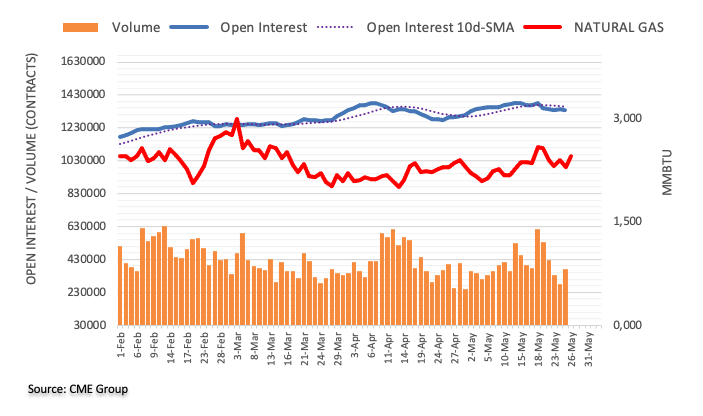
European Central Bank (ECB) Chief Economist, Philip Lane, said on Friday, “food inflation will reverse later this year.”
Additional quotes
“Energy price fall will feed into core prices but timeframe is uncertain.”
“There are some upside risks to wage growth.”
“Real wage growth correction has to be a gradual process.”
“Uncertainty in models high.“
“No sense of certainty in terminal rate.”
Market reaction
At the time of writing, EUR/USD is trading modestly flat at 1.0730, awaiting the US PCE inflation data for fresh trading impetus.
- AUD/USD bounces off a multi-day low touched on Friday amid a modest USD pullback.
- Economic woes and US debt ceiling concerns cap the upside for the risk-sensitive Aussie.
- Investors now look to the US Core PCE Price Index before placing fresh directional bets.
The AUD/USD pair stages a modest recovery from sub-0.6500 levels, or its lowest since November 2022 touched this Friday and sticks to its intraday gains through the first half of the European session. The pair is currently placed around the 0.6525-0.6530 region, up over 0.20% for the day, and for now, seems to have snapped a three-day losing streak.
The US Dollar (USD) bulls opt to take some profits off the table following the recent rally to over a two-month high and turn out to be a key factor lending some support to the AUD/USD pair. The downside for the USD, meanwhile, seems cushioned amid growing acceptance that the Federal Reserve (Fed) will keep interest rates higher for longer to combat sticky inflation. Apart from this, the prevalent cautious mood could benefit the Greenback's relative safe-haven status and contribute to capping the upside for the risk-sensitive Aussie.
Against the backdrop of the recent hawkish remarks by several Fed officials, Thursday's better-than-expected US macro data reaffirms market expectations that the US central bank will continue to tighten its monetary policy. In fact, the markets have started pricing in the possibility of another 25 bps lift-off at the June FOMC meeting. This, in turn, pushed the yield on the rate-sensitive two-year US government bond to a two-and-half-month high on Thursday and supports prospects for the emergence of some dip-buying around the USD.
The market sentiment, meanwhile, remains fragile amid worries about a global economic slowdown and the US debt ceiling impasse. It is worth mentioning that both Democrats and Republican negotiators flagged little progress towards reaching a deal to raise the borrowing limit ahead of the early-June deadline when the federal government could run out of money. Moreover, Fitch placed its top-level "AAA" rating of the US on negative watch, while credit rating agency DBRS Morningstar put the US on review for a downgrade on Thursday.
Apart from this, speculations that the Reserve Bank of Australia (RBA) might refrain from hiking in June, bolstered by softer domestic data, suggests that the path of least resistance for the AUD/USD pair is to the downside. Hence, any subsequent move up might still be seen as a selling opportunity and runs the risk of fizzling out rather quickly. Traders now look to the US economic docket, highlighting the release of the Core PCE Price Index - the Fed's preferred inflation gauge - and Durable Goods Orders, later during the early North American session.
Technical levels to watch
Inflation rises in Japan. Economists at Commerzbank discuss BoJ's policy outlook and its implications for the Yen.
Prices in Japan are rising
“Prices in Japan are rising. As a result, some analysts expect another increase in the 10-year Japanese government bond yield target as early as this summer, effectively pushing up long-term interest rates in Japan. However, USD/JPY levels around 140 suggest that this is (still) a minority view.”
“As long as the BoJ continues to signal a wait-and-see approach to gain more certainty about the sustainability of inflation dynamics, high inflation will erode the Yen's purchasing power. As a result, we see limited upside potential for the Yen in the near term.”
ECB policymaker, Boris Vujčić, said on Friday, “inflation momentum is still persistent.”
“It is questionable if we will be able to get to 2% in the next two years.”
Market reaction
At the time of writing, EUR/USD is treading water at around 1.0730, modestly flat on the day.
USD/BRL is back above 5.00. Economists at Société Générale analyze the pair’s technical outlook.
Downtrend could resume on a break under 4.93
“USD/BRL broke below the consolidation since last August however the downward momentum has not regained. The pair has formed an interim support near April low of 4.89 resulting in an initial bounce towards the 50-DMA. Recent pivot high at 5.10 is a short-term resistance. This must be overcome to affirm an extended rebound.”
“In case the pair fails to defend low formed this week at 4.93, the downtrend could resume.”
Economists at ING discuss EUR/USD outlook.
1.05/1.07 to prove the base for a push towards 1.15 in the third quarter
“There were reports in the market yesterday of some upside interest in EUR/USD going through the FX options market. We can see why. 1.0700 is a decent support area for EUR/USD and we do see the outside risk of a break to 1.0500. However, the eurozone terms of trade story is so much better than it was last summer and that is why our medium-term models identify EUR/USD as very under-valued.”
“Our view is that 1.05/1.07 proves the base for a push towards 1.15 in the third quarter, once clearer signs of US disinflation and slowing activity become a lot clearer.”
“Expect EUR/USD to stay soft near 1.0700/0720 and perhaps take a decisive turn on the release of the US inflation data.”
See – US Core PCE Preview: Forecasts from four major banks, inflation to stay elevated in April
- USD/JPY retreats from the YTD peak amid a modest USD pullback from over a two-month high.
- A softer risk tone benefits the safe-haven JPY and further contributes to the intraday downfall.
- The Fed-BoJ policy divergence should help limit losses ahead of the US Core PCE Price Index.
The USD/JPY pair comes under some selling pressure on the last day of the week and extends its steady intraday slide through the first half of the European session. Spot prices drop to mid-139.00s in the last hour, reversing the previous day's positive move to the highest level since November 2022.
The US Dollar (USD) pulls back from over a two-month high touched on Thursday and turns out to be a key factor dragging the USD/JPY pair lower. The Japanese Yen (JPY), on the other hand, attracts some heaven flows amid growing worries of a global economic slowdown and US debt ceiling woes. This further contributes to the offered tone surrounding the major, though any meaningful corrective decline still seems elusive.
A more dovish stance adopted by the Bank of Japan (BoJ), along with the softer domestic data, could act as a headwind for the JPY and lend some support to the USD/JPY pair. In fact, BoJ Governor Kazuo Ueda had reiterated recently that the central bank will continue easing with yield curve control. Furthermore, the Tokyo CPI released this Friday showed that inflation in Japan’s capital city eased more than expected in May.
The Federal Reserve (Fed), on the other hand, is expected to keep interest rates higher for longer to combat stick inflation. In fact, the markets have started pricing in the possibility of another 25 bps lift-off at the June FOMC policy meeting and the bets were lifted by the recent comments by a slew of Fed officials. Adding to this, Thursday's upbeat US macro data could allow the US central bank to stick to its hawkish stance.
This has been pushing the US Treasury bond yields higher recently, widening the US-Japan rate differential and supporting prospects for the emergence of some dip-buying around the USD/JPY pair. The USD bulls, however, seem reluctant to place aggressive bets and await the release of the Core PCE Price Index - the Fed's preferred inflation gauge - later during the early North American session for a fresh impetus.
Technical levels to watch
- EUR/USD attempts a mild bounce from recent lows near 1.0700.
- There seems to be dome renewed optimism around the US debt ceiling.
- Markets’ attention will be on the US PCE/Core PCE in April.
The single currency manages to regain some composure and encourages EUR/USD to put some distance from Thursday’s multi-week lows near the 1.0700 region.
EUR/USD looks at US docket, debt ceiling
EUR/USD trades with humble gains in the wake of the opening bell in Euroland at the end of the week against the backdrop of some selling pressure in the dollar and fresh optimism around the US debt ceiling.
On the latter, market participants seem to favour the risk complex on Friday after Republican lawmakers and President Biden appeared to be getting closer to a deal to reduce spending and raise the debt ceiling before a potential default that could have a devastating effect on the economy and global markets. Indeed, negotiators are looking at a deal that would limit spending on most things while simultaneously raising the government's $31.4 trillion debt ceiling for two years.
In the euro, Consumer Confidence in France held steady at 83 in May, while the same gauge is due later in Italy.
In the US, the publication of inflation figures gauged by the PCE and Core PCE will be in the centre of the debate later in the NA session. In addition, Trade Balance results, Personal Income/Spending, Durable Goods Orders and the final print of the Michigan Consumer Sentiment for the current month area all due.
What to look for around EUR
EUR/USD’s sell-off seems to have run out of steam just ahead of the key 1.0700 zone so far this week.
The movement of the euro's value is expected to closely mirror the behaviour of the US Dollar and will likely be impacted by any differences in approach between the Fed and the ECB with regards to their plans for adjusting interest rates.
Moving forward, hawkish ECB-speak continue to favour further rate hikes, although this view appears in contrast to some loss of momentum in economic fundamentals in the region.
Key events in the euro area this week: Germany Final Q1 GDP Growth Rate, GfK Consumer Confidence (Thursday) – Italy, France Consumer Confidence (Friday).
Eminent issues on the back boiler: Continuation of the ECB hiking cycle in June and July (and September?). Impact of the Russia-Ukraine war on the growth prospects and inflation outlook in the region. Risks of inflation becoming entrenched.
EUR/USD levels to watch
So far, the pair is gaining 0.15% at 1.0741 and a break above 1.0880 (55-day SMA) would target 1.1000 (round level) en route to 1.1095 (2023 high April 26). On the other hand, immediate contention aligns at 1.0707 (monthly low May 25) seconded by 1.0516 (low March 15) and finally 1.0481 (2023 low January 6).
THB has reversed all of the gains at the start of the year. But economists at Commerzbank believe that the USD/THB pair could return to the low 33.00 level by the end of the year.
Great expectations for THB tempered
“The Tourism Authority of Thailand (TAT) is projecting 25mn foreign tourist arrivals in 2023. This will be around 63% of the pre-pandemic level of 40mn in 2019. Nevertheless, it will still represent a notable rebound from 11.2mn in 2022. Even though optimism may be tempered, the influx of foreign tourism and tourism revenue should be a supportive factor for THB.”
“This year’s high of just above 35.40 for USD/THB should provide the immediate barrier near term.”
“If the global risk backdrop holds up and there are no adverse shocks, we could see USD/THB return to the low 33.00 level by year-end.”
Further gains in USD/JPY seems the most likely scenario for the time being, according to UOB Group’s Economist Lee Sue Ann and Markets Strategist Quek Ser Leang.
Key Quotes
24-hour view: “Yesterday, we highlighted that USD could break above the major resistance at 139.60. However, we were of the view that ‘the resistance at 140.00 could be out of reach today’. USD rose as expected, held below 140.00 until late NY when it popped to a high of 140.23. Conditions are clearly overbought but there is room for USD to rise to 140.50 before the risk of a pullback increases. 141.00 is highly unlikely to come into view today. Support is at 139.65, followed by 139.35.”
Next 1-3 weeks: “We turned positive in USD two weeks ago on 15 May when USD was trading at 135.80. As USD rose, in our latest narrative form yesterday, we stated, USD is likely to strengthen further and that resistance levels are at 139.60 and 140.00. USD cracked both resistance levels as it soared to a high of 140.23. While the USD strength appears overdone, both in terms of time and price, the rally is not showing signs of easing just yet. We will continue to hold a positive view even though the next resistance at 141.00 may not come into view so soon. Overall, only a breach of 138.55 (‘strong support’ level was at 138.10 yesterday) would indicate that the current strong upward pressure has eased.”
Open interest in crude oil futures markets rose for the fourth session in a row on Thursday, this time by around 38.5K contracts according to preliminary readings from CME Group. Volume followed suit and went up for the third straight day, now by more than 84K contracts.
WTI: Next on the downside comes $70.00
Thursday’s strong pullback in prices of WTI was on the back of increasing open interest and volume. That said, further losses now look likely and the commodity is expected to face the next support of note a the $70.00 mark per barrel so far.
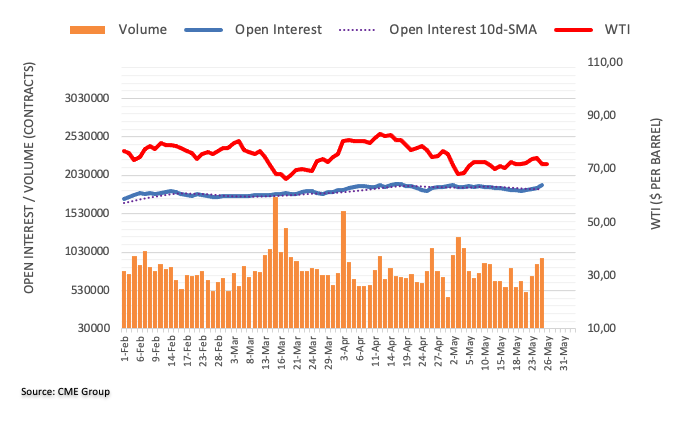
- Gold price defends 100-day SMA and rebounds from over a two-month low touched on Friday.
- A modest US Dollar profit-taking slide is seen as a key factor lending support to the XAU/USD.
- Hawkish Federal Reserve expectations might cap the upside ahead of the US PCE Price Index.
Gold price attracts some buyers in the vicinity of the 100-day Simple Moving Average (SMA) and stages a modest recovery from the $1,937-$1,936 area, or over a two-month low touched the previous day. The XAU/USD climbs back above the $1,950 level during the early European session and for now, seems to have snapped a two-day losing streak.
Modest US Dollar weakness benefits Gold price
The US Dollar (USD) bulls opt to take some profits off the table following the recent runup to over a two-month high, which, in turn, is seen as a key factor benefitting the Gold price. Any meaningful upside, however, still seems elusive, at least for the time being, amid expectations that the Federal Reserve (Fed) will keep interest rates higher for longer to combat sticky inflation, which could act as a tailwind for the Greenback. In fact, the markets have started pricing in the possibility of another 25 basis points (bps) at the next Federal Open Market Committee (FOMC) policy meeting in June.
Hawkish Federal Reserve expectations to act as a headwind
The bets were lifted by the recent hawkish remarks by several Fed officials and Thursday's better-than-expected economic data from the United States (US). The US Bureau of Economic Analysis (BEA) released the revised estimate of the Gross Domestic Product (GDP) report, which showed that the economy expanded at an annualized pace of 1.3% during the January-March quarter as compared to the 1.1% estimated originally. Adding to this, an unexpected drop in the Initial Weekly Jobless Claims pointed to signs of strength in the US labour market and should allow the Fed to continue raising rates.
Focus remains glued to the US PCE Price Index
Hawkish Fed expectations, meanwhile, push the yield on the rate-sensitive two-year US government bond to a two-and-half-month high and support prospects for the emergence of some US dip-buying. This, in turn, might hold back traders from placing aggressive bullish bets around the non-yielding Gold price ahead of the release of the US Personal Consumption Expenditures (PCE) Price Index, due later during the North American session. The Fed's preferred inflation gauge will drive expectations about future rate hikes and influence the USD, providing some impetus to the XAU/USD.
Economic woes, US debt ceiling concerns continue to lend support
In the meantime, a generally softer tone around the equity markets - amid worries about a global economic slowdown and the US debt ceiling - could lend some support to the safe-haven Gold price and help limit deeper losses. In fact, Democrats and Republican negotiators flagged little progress towards reaching a deal to raise the government's $31.4 trillion borrowing limit. Adding to this, Fitch placed its top-level "AAA" rating of the US on negative watch, while credit rating agency DBRS Morningstar put the US on review for a downgrade on Thursday, tempering investors' appetite for riskier assets.
Gold price technical outlook
From a technical perspective, any subsequent move up is likely to confront stiff resistance near the $1,970-$1,980 strong horizontal support breakpoint. A sustained strength beyond might trigger a short-covering rally and lift the Gold price to the $2,000 psychological mark. A further move up, however, might still be seen as a selling opportunity and remain capped near the $2,010-$2,012 supply zone.
On the flip side, bearish traders might now wait for a sustained break below the 100-day SMA, currently pegged near the $1,935 region, before placing fresh bets. This will set the stage for an extension of the recent retracement slide from the all-time high touched earlier this month and drag Gold price to the $1,900 round-figure mark
Key levels to watch
In the view of UOB Group’s Economist Lee Sue Ann and Markets Strategist Quek Ser Leang, a deeper drop could see AUD/USD revisit the mid-0.6400s in the short term.
Key Quotes
24-hour view: “When AUD was trading at 0.6540 in early Asian trade yesterday, we highlighted that ‘as long as AUD stays below 0.6580 (minor resistance is at 0.6560), the oversold weakness could extend to 0.6515, possibly testing the major support at 0.6500’. Our view was correct even though AUD edged a couple of pips below 0.6500 (low of 0.6498). Today, further AUD weakness is not ruled out but in view of the severely oversold conditions, AUD is unlikely to threaten 0.6450 (minor support is at 0.6475). Resistance is at 0.6525, followed by 0.6545.”
Next 1-3 weeks: “After AUD fell sharply to 0.6530 on Wednesday, we highlighted yesterday (25 May, spot at 0.6540) that ‘the boost in momentum suggests AUD could weaken further to 0.6500’ We added, ‘At this stage, it is premature to expect a break of 0.6450’. While our view for AUD to weaken was correct, we did not quite expect 0.6500 to come into view so quickly (AUD dropped to 0.6498 in NY trade). The weakness in AUD that started two weeks ago has yet to stabilize. In other words, AUD could weaken further to 0.6450. On the upside, a breach of 0.6590 (‘strong resistance’ level was at 0.6615 yesterday) would suggest the weakness in AUD has stabilized.”
Economists at ING discuss EUR/GBP and GBP/USD outlooks following the release of UK Retail sales data.
The case builds for a June hike
“This morning has just seen UK April Retail Sales surprise on the upside. This will firm up the case for a 25 bps Bank of England hike on 22 June. And it will also delay any adjustment to the very hawkish expectations currently built into money markets, where the Bank Rate is priced up at 5.50% early next year.”
“Today's data make the case for EUR/GBP to retest 0.8650 and for GBP/USD to hold above this 1.2275/2350 band (assuming US inflation data does not surprise on the upside).”
See – US Core PCE Preview: Forecasts from four major banks, inflation to stay elevated in April
- Silver price has fit above $23.00 amid a sheer decline in the USD Index.
- White House officials and Speaker McCarthy-led team are vigorously involved in negotiations for raising the US debt-ceiling.
- Silver price has shown a decent recovery and has climbed back above the 50% Fibo retracement at $23.00.
Silver price (XAG/USD) has shifted comfortably above the critical resistance of $23.00 in the early European session. The white metal is extending its upside as the US Dollar Index (DXY) is looking vulnerable above 104.00.
The USD Index has sensed selling pressure as investors are expecting that the White House and Republican leaders will reach a bipartisan, which would support the United States Treasury in avoiding a default. White House officials and House of Representatives Kevin McCarthy-led team are vigorously involved in negotiations. The deviation in proposed budget spending by the White House to Republican leaders has narrowed to $70 billion from the original proposal of $1 trillion.
Meanwhile, signs of a pause in the policy-tightening spell by the Federal Reserve (Fed) are also fueling strength into the Silver price.
Silver price has shown a decent recovery and has climbed back above the 50% Fibonacci retracement (plotted March 08 low at $19.92 to April 14 high at $26.08) at $23.00 on a four-hour scale. The white metal has to pass through plenty of filters for a bullish reversal. The asset is still auctioning in a Falling Channel chart pattern.
The declining 20-period Exponential Moving Average (EMA) at $23.15 is acting as a barricade for the Silver price bulls.
The Relative Strength Index (RSI) (14) is making efforts for shifting into the 40.00-60.00 range.
A confident break above May 25 high at $23.14 will send the major toward May 18 low at $23.48 followed by May 19 high at 24.00.
On the flip side, a downside move below May 26 low at $22.68 will strengthen the US Dollar bulls and will drag the asset toward 61.8% Fibo retracement at $22.28 and the major support at $22.00.
Silver four-hour chart
-638206814172286253.png)
Esther Reichelt, FX Analyst at Commerzbank, has not seen a situation where EUR/USD has clearly reacted to a news flow about the debt crisis.
What is driving the Dollar?
“I find it impossible to say whether and in what form the US debt crisis is priced into the EUR/USD exchange rate.”
“The absolute calm in the options market suggests to me that it is monetary policy considerations rather than the ongoing US debt ceiling negotiations that are driving EUR/USD.”
“If the recent USD strength is primarily due to the upward revision of interest rate expectations, it also means that the USD rally is likely to end soon. Otherwise, one would have to assume that the Fed could raise rates much further than currently expected. And not even the hawkish FOMC members are signaling that at the moment.”
- USD/CAD renews intraday low, prints the first daily loss in three around monthly top.
- Key resistance line prods Loonie pair bulls but oscillators, previous run-up suggest the quote’s further advances.
- Convergence of 50-DMA, three-week-long rising trend line challenges bears.
USD/CAD retreats from the previous monthly high, refreshing intraday low near 1.3625 at the latest, as Loonie buyers return after a two-day recess.
In doing so, the quote portrays a U-turn from a downward-sloping resistance line from March 28, close to 1.3650 by the press time.
The pullback moves, however, appear less impressive as the quote keeps the mid-week breakout of the previous key resistance line stretched from early March amid bullish MACD signals and an upbeat RSI (14) line, not overbought.
Hence, the USD/CAD pair’s pullback remains elusive beyond the resistance-turned-support line of around 1.3560.
Even if the quote breaks the 1.3560 support, a convergence of the 50-DMA and a three-week-long rising trend line, close to 1.3525 at the latest, could challenge the USD/CAD pair sellers before giving them control.
In that case, the 61.8% Fibonacci retracement of February-March upside, near 1.3490, can prod the pair’s downward trajectory targeting an upward-sloping support line from February, around 1.3380.
Alternatively, a daily closing beyond the immediate resistance line surrounding 1.3650 needs validation from the previous monthly high of nearly 1.3670 to recall the Loonie pair buyers.
Following that, the yearly high marked in March around 1.3860 will gain the market’s attention.
USD/CAD: Daily chart
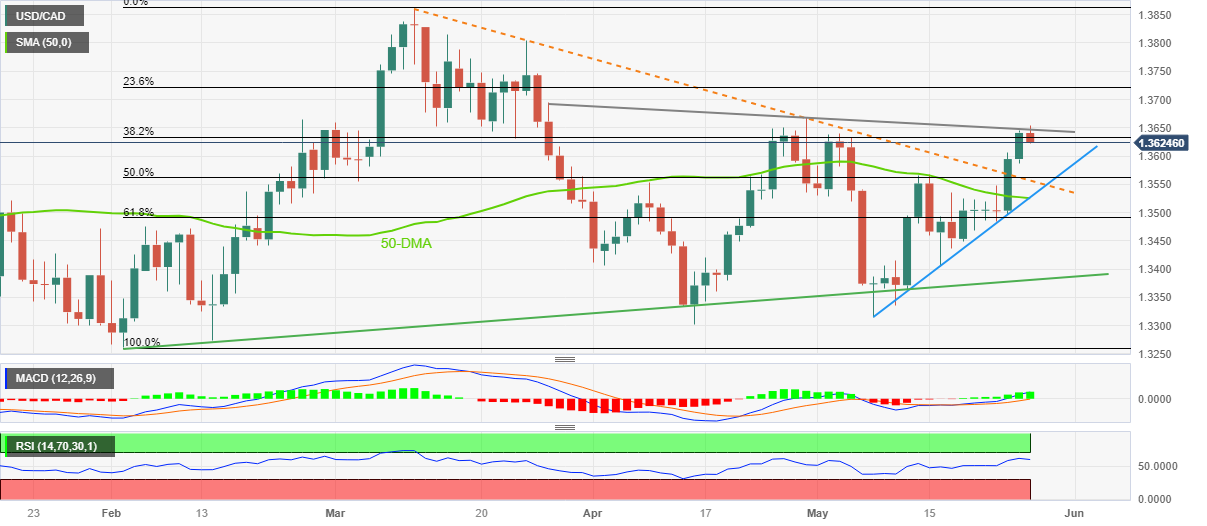
Trend: Bullish
The Fed’s preferred inflation gauge, the Core Personal Consumption Expenditure (Core PCE), will be released by the US Bureau of Economic Analysis on Friday, May 26 at 12:30 GMT and as we get closer to the release time, here are the forecasts of economists and researchers of four major banks.
Core PCE is expected to stay at 4.6% year-on-year while rising 0.3% in April (MoM). The headline is seen increasing by 0.4% in April, and a slowdown in the annual rate from 4.2% to 3.9%.
TDS
“We expect core PCE inflation to tick a tenth higher to 0.4% MoM in April, matching the core CPI's MoM gain though there's a non-negligible chance it prints 0.3% (our unrounded forecast is 0.37%). The YoY rate likely rose a tenth to 4.7%.”
NBF
“In April, the annual core PCE deflator may have remained unchanged at 4.6%.”
CIBC
“With the PCE price index weighting medical care services (a disinflationary force) higher than the CPI basket, but housing (an inflationary force) lower, the monthly seasonally adjusted increase in core PCE should be at least a tick weaker than ex food/energy CPI. However, that would leave the annual rate only one tick lower than in the previous month, at 4.5%.”
Citi
“Core PCE inflation should remain persistently strong in April, with expectations for a 0.38% MoM increase based on elements of CPI and PPI inflation. While this is a similar increase to 0.41% MoM core PCI, the key core non-shelter services price components may rise by a stronger 0.42% MoM in PCE compared to 0.11% in CPI which should highlight the divergence between CPI and PCE inflation. Our forecasts would imply core PCE inflation rising slightly to 4.7% YoY, although this will also be sensitive to any revisions to PCE data in the second release of Q1 GDP.”
FX option expiries for May 26 NY cut at 10:00 Eastern Time, via DTCC, can be found below.
- EUR/USD: EUR amounts
- 1.0650 1.6b
- 1.0665 1.3b
- 1.0700 749m
- 1.0720 850m
- 1.0785 918m
- 1.0800 2.0b
- 1.0865 844m
- 1.0880 845m
- 1.0900 1.6b
- 1.0940 1.5b
- USD/JPY: USD amounts
- 136.50 370m
- 138.50 350m
- 139.00 530m
- 140.00 965m
- AUD/USD: AUD amounts
- 0.6560 393m
- 0.6600 333m
- 0.6665 372m
- USD/CAD: USD amounts
- 1.3375 815m
- 1.3450 389m
- 1.3565 361m
- 1.3775 421m
- NZD/USD: NZD amounts
- 0.6100 325m
- GBP/JPY has recovered sharply and has climbed to near 172.50 after the release of mixed UK Retail Sales.
- Monthly UK Retail Sales have expanded sharply, portraying resilience in the households’ demand.
- BoJ Ueda is considering options for tweaking YCC.
The GBP/JPY pair has slipped below the immediate support of 172.30 in the early European session. The cross has faced immense pressure after the release of the mixed United Kingdom Retail Sales data (April).
Monthly Retail Sales expanded by 0.5% vs. 0.3% as expected and against a contraction of 1.2% reported earlier. While annual Retail Sales missed estimates and contracted by 3.0% against the consensus of a 2.8% contraction. Monthly Retail Sales excluding volatile fuel factors have expanded by 0.5% while the street was anticipating an expansion of 0.3%.
Solid expansion in UK monthly Retail Sales indicates that households’ demand is resilient, which will keep pressure on the Bank of England (BoE). On Thursday, BoE interest rate-setter Jonathan Haskel said, if we do see evidence of more inflation persistence, we will tighten policy.
UK Finance Minister is confident that inflation will be halved by the year-end as promised by UK Prime Minister Rishi Sunak. He further added the administration wants to cut taxes to provide relief to households from stubborn inflation and for that inflation needs to bring down otherwise it could have catastrophic effects.
On the Japanese Yen front, discussions about a tweak in Yield Curve Control (YCC) by Bank of Japan (BoJ) Kazuo Ueda have put the Japanese Yen under the spotlight. BoJ Ueda cited that “Shortening the duration of bond yields it targets to the five-year zone from the current 10-year zone could be among options."
IDR has been the best performer among Asian currencies this year. It is up by 4.6% vs USD year-to-date. Economists at Commerzbank expect the USD/INR pair to hover around the 14,600-15,000 range near term.
BI will be averse to excessive strength in the currency
“The pullback in commodity prices has not hurt IDR’s prospects. Instead, the current account balance improvement has been a major supportive factor. The current account balance has been in surplus since the second half of 2021, and it rose to 1.2% of GDP in Q1 2023. It should stay in surplus territory for the rest of the year, aided partly by lower imports.”
“We suspect Bank Indonesia will also be averse to excessive strength in the currency. We look for consolidation in USD/IDR between the 14,600-15,000 range near term.”
CME Group’s flash data for gold futures markets noted traders extended the downtrend for yet another session on Thursday, this time by nearly 8K contracts. Volume, instead, went up for the third straight session, now by around 61.4K contracts.
Gold appears initially supported around $1930
Gold prices extended the weekly decline on Thursday amidst shrinking open interest, which is indicative that a deeper retracement looks out of favour in the very near term. In the meantime, the yellow metal is expected to remain bolstered by the $1930 region per ounce troy.
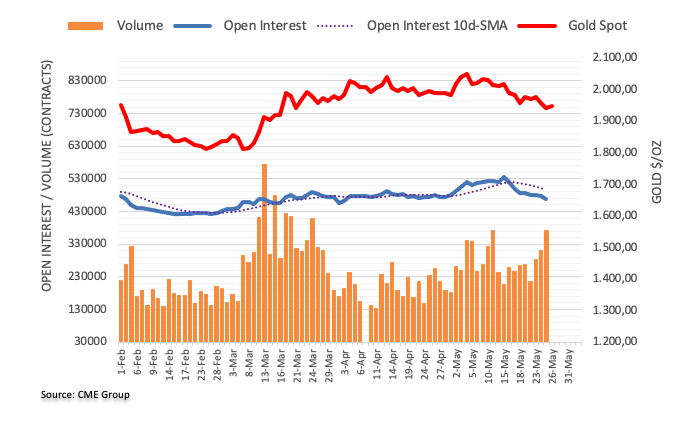
- GBP/USD grinds near intraday high as UK Retail Sales MoM improves in April.
- US Dollar’s pullback from key resistance line adds strength to Cable pair’s run-up.
- Multiple US statistics scheduled to entertain intraday traders of the Pound Sterling.
- US debt ceiling updates, central bank commentary appears crucial for fresh impulse.
GBP/USD retreats after refreshing intraday top, around 1.2335 by the press time, as it cheers firmer UK Retail Sales growth, as well as the US Dollar’s retreat, heading into Friday’s London open. In doing so, the Pound Sterling recovers from a seven-week low while printing the first daily loss in five.
UK Retail Sales improves on MoM prints lesser-than-forecast number on YoY. That said, the Core Retail Sales, namely the Retail Sales ex Fuel, rose on both monthly and yearly basis.
Also read: UK Retail Sales rise 0.5% MoM in April vs. 0.3% expected
With the recently firmer British data, the Bank of England (BoE) policymaker Jonathan Haskel’s hawkish comments gain acceptance as he said on Thursday, “Further increases in bank rates cannot be ruled out.”
Apart from the mostly upbeat UK data, the US Dollar Index (DXY) pullback from a 2.5-month high, to 104.17 at the latest, also allow the Cable pair to remain firmer. The greenback’s retreat could be linked to the mixed feelings about the US policymakers’ ability to avoid the “catastrophic’ default. It should be noted that the latest headlines suggest that the US President Joe Biden and House Speaker Kevin McCarthy appear near two-year deal on us debt ceiling as default looms.
While portraying the mood, US stock futures print mild losses while the US Dollar Index retreat from a two-month high and the yields dribble near the highest levels since March. All of it portrays mixed sentiment and lure the GBP/USD buyers.
Looking forward, US Durable Goods Orders for April and the Core Personal Consumption Expenditure (PCE) Price Index for the said month, known as the Fed’s preferred inflation gauge, will be crucial to watch. Above all, US debt ceiling negotiations should be traced for clear directions.
Technical analysis
Despite the latest corrective bounce, the GBP/USD pair remains below a two-week-old resistance line, around 1.2370 by the press time, keeps bears hopeful to revisit the 100-DMA support of around 1.2285.
UOB Group’s Economist Lee Sue Ann and Markets Strategist Quek Ser Leang suggest GBP/USD still faces further downside in the near term.
Key Quotes
24-hour view: “Yesterday, when GBP was trading at 1.2370, we expected it to drop below 1.2350. However, we indicated that ‘the next major support at 1.2300 is unlikely to come into view today’. Our expectations were correct as GBP broke below 1.2350 and dropped to a low of 1.2308. While conditions are severely oversold, the weakness in GBP has yet to stabilize. Today, as long as GBP stays below 1.2375 (minor resistance is at 1.2345), it is likely to break below 1.2300. The chance of GBP reaching the next support at 1.2255 today is not high.”
Next 1-3 weeks: “We indicated yesterday that ‘the risk for GBP is still on the downside’. We added, ‘a clear break below 1.2350 will shift the focus to 1.2300’. In line with our expectations, GBP cracked 1.2350 and dropped to 1.2308. The weak phase in GBP started two weeks ago is still intact. In view of the oversold conditions, any further decline is likely to be at a slower pace and it remains to be seen if the next major support at 1.2175 will come into view this time around. It is worth noting that there is a shorter-term support at 1.2250. On the upside, a breach of 1.2415 (‘strong resistance’ level was at 1.2470 yesterday) would suggest the GBP weakness has stabilized.”
- NZD/USD has turned sideways around 0.6060 posts a soft recovery ahead of US Durable Goods Orders.
- Fed policymakers are anticipated to capitalize on tight credit conditions to weigh pressure on inflation rather than hiking interest rates further.
- RBNZ Silk advised holding rates ahead and remaining data-specific.
The NZD/USD pair is displaying a back-and-forth action after a soft recovery around 0.6070 in the early London session. The Kiwi asset is expected to extend recovery as the US Dollar Index (DXY) has shifted into the bearish trajectory amid bets favoring a pause in the rate-hike spell by the Federal Reserve (Fed).
S&P500 futures have trimmed some losses added in Asia, portraying a minor recovery in the risk appetite of the market participants. A decline in the US Dollar Index (DXY) has improved the appeal for US equities. However, the overall market mood is expected to remain cautious as the $31.4 trillion US borrowing cap limit has not increased yet.
The USD index has come under pressure as the Federal Reserve (Fed) policymakers are anticipated to capitalize on tight credit conditions to weigh pressure on inflation rather than hiking interest rates further.
For further guidance, US Durable Goods Orders data will be keenly watched. April’s Durable Goods Orders are seen contracting by 1.0% vs. an expansion by 3.2%. A contraction in the economic data indicates poor demand, which would have a ripple effect on US Consumer Price Index (CPI).
Investors should note that the US economy is facing issues of persistence in core inflation more than the headline price index. A contraction in durable goods demand would release some heat from core inflation and would be a more relieving factor for the Fed.
On the New Zealand Dollar front, Reserve Bank of New Zealand´s Assistant Governor Karen Silk noted that Cyclone Gabrielle was less inflationary than first feared and stated that rates need to stay on hold for an extended period. She said that they must be watchful of over-tightening policy and that the RBNZ can hold now and sees what develops.
Investors should note that RBNZ Governor Adrian Orr raised its Official Cash Rate (OCR) by 25 basis points (bps) to 5.5% this week.
- The UK Retail Sales came in at 0.5% MoM in April, beating estimates.
- Core Retail Sales for the UK jumped 0.8% MoM in April.
- GBP/USD holds the bounce below 1.2350 on mixed UK data.
The UK Retail Sales rose 0.5% over the month in April vs. 0.3% expected and -1.2% previous. The Core Retail Sales, stripping the auto motor fuel sales, increased 0.8% MoM vs. 0.3% expected and -1.4% previous.
The annual UK Retail Sales declined 3.0% in April versus -2.8% expected and March’s -3.9% figure while the Core Retail Sales decreased 2.6% in the reported month versus -2.8% expectations and -4.0% previous.
Main points (via ONS)
Non-food stores sales volumes rose by 1.0% in April 2023, following a fall of 1.8% in March when poor weather conditions throughout most of March affected sales.
Food stores sales volumes rose by 0.7% in April 2023, following a fall of 0.8% in March 2023; sales volumes were 2.7% below their pre-coronavirus (COVID-19) February 2020 levels.
Non-store retailing (mainly online retailers) sales volumes rose by 0.2% in April 2023, following a fall of 1.4% in March 2023.
Despite falling fuel prices, automotive fuel sales volumes fell by 2.2% in April 2023, following a rise of 0.1% in March 2023.
FX implications
GBP/USD is sustaining its minor recovery at around 1.2335 after mixed UK Retail Sales data. The spot was last seen trading up 0.13% on the day.
- Core Personal Consumption Expenditures Price Index is expected to rise by 0.3% MoM in April.
- Markets see a strong probability of the Federal Reserve leaving its policy rate unchanged in June.
- US Dollar could gather strength if PCE data confirms sticky core inflation.
The Core Personal Consumption Expenditures (PCE) Price Index data from the United States, the Federal Reserve’s (Fed) preferred inflation measure, will be published by the Bureau of Economic Analysis (BEA) on Friday, May 26 at 12:30 GMT.
What to expect of the Federal Reserve in the next PCE inflation report?
Personal Consumption Expenditures Price Index, excluding food and energy, is expected to rise 0.3% on a monthly basis in April, matching the increase recorded in March.
The annualized Core PCE Price Index for April is forecast to stay unchanged at 4.6%. Moreover, the headline Personal Consumption Expenditures Price Index is expected to rise 0.4% MoM in April, while the annual figure is seen increasing 3.9%, lower than the previous print of 4.2%.
The increase in the monthly figures is mainly expected on the back of potentially robust Personal Income and Personal Spending data, which are both forecast to rise at a health pace of 0.4% in April.
Although the US Federal Reserve (Fed) watches the headline number, officials have said repeatedly that core PCE usually provides a better long-term indicator of where inflation is headed because it strips out prices that can be volatile over shorter time periods.
Commenting on inflation developments earlier in the week, “core measures of inflation have not changed much in recent months,” said St. Louis Federal Reserve President James Bullard. “If inflation is not controlled, the Fed will have to do a lot more, should err on the side of doing more,” Bullard added. On a similar note, Minneapolis Federal Reserve President Neel Kashkari told CNBC that services inflation seemed “pretty darn entrenched”
Previewing the potential impact of PCE inflation data on markets, “if there is a big miss in the data then you would expect the USD to weaken on expectations that the Fed will need to be less aggressive in hiking rates,” said Giles Coghlan, Chief Market Analyst for HYCM Group. “If the data comes in high, and surprises markets, investors will know that keeps the pressure on the Fed to raise interest rates. Typically, if inflation comes in high, you would expect US 10-year yields to rise, gold to fall, the USD to rise and the S&P500 to fall.”
When will be the Personal Consumption Expenditures Price Index report and how could it affect EUR/USD?
The PCE Inflation report is scheduled for release at 12:30 GMT, on May 26. Following the dovish tilt in the policy outlook in May, Federal Reserve (Fed) officials have been pushing back against market expectations for a rate cut later this year. Although the CME Group FedWatch Tool shows that markets are fairly certain that the Fed will leave its policy rate unchanged in June, rising US Treasury bond yields and the renewed US Dollar (USD) strength suggest that markets are re-assessing the possibility of the Fed refraining from lowering the policy rate in 2023. The FedWatch Tool’s probability of a rate cut in September dropped below 20% this week from nearly 50% earlier this month.
Hence, the USD should be able to hold its ground against its major in case monthly PCE inflation comes in near the market expectation of 0.3%. On the other hand, a reading close to 0% should confirm a pause in rate hikes in June and weigh on the USD by feeding into rate cut expectations.
FXStreet Analyst Eren Sengezer offers a brief technical outlook for EUR/USD and explains:
“EUR/USD closed below the 100-day Simple Moving Average (SMA) in the last three days and the 20-day SMA is about to make a bearish cross with the 50-day SMA. Additionally, the Relative Strength Index (RSI) indicator on the daily chart stays well below 40, confirming the bearish bias.”
Eren also highlights the important technical levels for EUR/USD: “On the downside, 1.0680 (static level) aligns as first technical support. A daily close below that level could bring in additional sellers and open the door for an extended slide toward the next static support at 1.0550 and 1.0500 (200-day SMA, psychological level).”
“In case EUR/USD rises above 1.0800 (100-day SMA) and stabilizes there, market participants could see that as a bullish development. In that scenario, the next hurdle is located at 1.0900 (20-day SMA, 50-day SMA) ahead of 1.1000 (psychological level).”
PCE inflation related content
- Gold Price Forecast: XAU/USD eyes US PCE inflation and a weekly close below 100 DMA
- EUR/USD climbs to near 1.0740 as ECB to raise rates further despite German recession
- US Dollar soars, strong economic data outweighs debt concerns
About the Core Personal Consumption Expenditures Price Index
The Core Personal Consumption Expenditures released by the US Bureau of Economic Analysis is the average amount of money that consumers spend in a month. "Core" excludes seasonally volatile products such as food and energy in order to capture an accurate calculation of the expenditure. It is a significant indicator of inflation. A high reading is bullish for the USD, while a low reading is bearish.
- WTI crude oil consolidates the biggest daily loss in three weeks.
- Mixed sentiment about US debt ceiling deal, Oil demand-supply concerns prod energy traders.
- Cautious mood ahead of the key data/events also restricts immediate WTI moves.
- US data, OPEC+ meeting eyed for directions, US debt ceiling updates are key.
WTI crude oil prints mild gains around $72.00 as it pares the previous day’s losses, the biggest in three weeks, heading into Friday’s European session. In doing so, the black gold struggles to justify a retreat in the US Dollar price amid mixed sentiment. Also troubling the Oil benchmark traders are mixed concerns about the demand-supply matrix of the WTI crude oil.
That said, the market sentiment dribbles as US policymakers’ inability to clinch a deal on the US debt ceiling extension contrasts with the chatters suggesting a $70.0 billion gap left to be filled by the negotiators to get the much-awaited deal. Recently, US House Speaker Kevin McCarthy announced no agreement on the debt deal, as well as the continuation of talks by saying, “It’s hard. But we’re working and we’re going to continue to work until we get this done.”
It’s worth noting that the unimpressive tone of the Federal Reserve (Fed) officials, despite upbeat US data, prods the US Dollar bulls ahead of another round of key statistics, also allowing the Oil sellers to take a breather.
Elsewhere, Russian Deputy Prime Minister Alexander Novak said on Thursday, “I do not see new steps at the June 4th OPEC+ meeting.” Russia’s Novak also added that he sees Brent above $80/bbl by year-end, $77 at the latest.
Against this backdrop, US stock futures print mild losses while the US Dollar Index retreat from a two-month high and the yields dribble near the highest levels since March. All of it portrays mixed sentiment and challenge the Oil price.
Looking ahead, the key data including the US Durable Goods Orders for April and the Core Personal Consumption Expenditure (PCE) Price Index for the said month, known as the Fed’s preferred inflation gauge, can direct intraday traders. However, major attention will be given to the next week’s OPEC+ meeting and US debt ceiling updates.
Technical analysis
WTI crude oil grinds higher within a two-month-old rising support line and the 50-DMA, around $71.65 and $74.60 in that order.
- The index gives away some loses following recent peaks.
- Policy makers move closer to a deal in the debt ceiling.
- US inflation tracked by the PCE takes centre stage later on Friday.
The USD Index (DXY), which measures the greenback vs. a basket of its main rival currencies, recedes from recent multi-week peaks near the 104.30 region.
USD Index focuses on PCE, debt ceiling talks
The index has so far traded on the defensive for the first time this week, coming under some selling pressure after hitting new multi-week tops around 104.30 on May 25.
Following recent meetings, debt ceiling negotiators appear to have opened the door to a potential agreement that includes raising the debt limit and setting a two-year spending cap for the federal government.
In the meantime, investors’ attention will exclusively be on the release of April’s inflation figures measured by the PCE/Core PCE along with Personal Income/Spending, Durable Goods Orders, Trade Balance and the final Michigan Consumer Sentiment for the month of May.
What to look for around USD
The index now faces some downside pressure after the rally seems to have met initial resistance around 104.30 so far this week.
In the meantime, diminishing bets that the Fed will probably pause its normalization process in June appear underpinned by the steady resilience of key US fundamentals (employment and prices mainly) amidst the ongoing rally in US yields and the DXY.
Favouring a pause by the Fed, instead, appears the extra tightening of credit conditions in response to uncertainty surrounding the US banking sector.
Key events in the US this week: PCE/Core PCE, Durable Goods Orders, Flash Goods Trade Balance, Personal Income/Spending, Final Michigan Consumer Sentiment (Friday).
Eminent issues on the back boiler: Persistent debate over a soft/hard landing of the US economy. Terminal Interest rate near the peak vs. speculation of rate cuts in late 2023/early 2024. Fed’s pivot. Geopolitical effervescence vs. Russia and China. US-China trade conflict.
USD Index relevant levels
Now, the index is down 0.13% at 104.07 and faces the next support at the 100-day SMA at 102.85 seconded by the 55-day SMA at 102.43 and finally 101.01 (weekly low April 26). On the flip side, the surpass of 104.31 (monthly high May 25) seconded by 105.69 (200-day SMA) and then 105.88 (2023 high March 8).
- EUR/USD has jumped to near 1.0740 as the USD Index has extended correction.
- Tight credit conditions by US regional banks are effectively weighing on US inflationary pressures.
- The ECB is anticipated ECB to raise interest rates further despite the German recession.
The EUR/USD pair has climbed above the critical resistance of 1.0740 in the early European session after a firmer recovery from near the round-level support of 1.0700. The major currency pair is anticipated to extend further as the US Dollar Index (DXY) has extended its correction further to near 104.08.
S&P500 futures are holding losses generated in Asia as the overall market mood is quite cautious due to the US debt-ceiling issues. Despite narrowing the budget's spending proposal to $70 billion from the original offering of $1 trillion, the White House is failing to get approval for raising the $31 trillion US borrowing cap limit from Republican leaders.
Meanwhile, soaring expectations for a pause in the policy-tightening spell by the Federal Reserve (Fed) are weighing heavily on the USD Index. As tight credit conditions by US regional banks are effectively weighing on inflationary pressures, the Fed believes that more rate hikes for June monetary policy meeting are less certain.
On the Eurozone front, the German economy has fallen into recession after reporting a contraction in Q1 real Gross Domestic Product (GDP) by 0.3%. Investors should note that reporting a contraction for two consecutive quarters is considered a recession and the German economy also reported a contraction in Q4 of the prior year by 0.5%. This could force the European Central Bank (ECB) President Christine Lagarde to focus first on the economic outlook and later on inflationary pressures.
On the contrary, ECB policymaker Klaas Knot said that the ECB needs to raise the policy rate at least two more times, as reported by Reuters. He further argued that rates should stay put for a significant period of time following these increases.
EUR/USD risks further declines while below the 1.0820 level for the time being, note UOB Group’s Economist Lee Sue Ann and Markets Strategist Quek Ser Leng.
Key Quotes
24-hour view: “After EUR fell to a low of 1.0746 on Wednesday, we indicated yesterday that ‘the price actions have resulted in an increase in downward momentum even though EUR is unlikely to threaten the next major support at 1.0700 today’. In line with our expectations, EUR continued to weaken yesterday but did not break the major support at 1.0700 (low has been 1.0706). While severely oversold, EUR could dip below 1.0700 today but it is unlikely to threaten the next support at 1.0650. On the upside, a breach of 1.0760 (minor resistance is at 1.0740) would indicate that EUR is not ready to head below 1.0700.”
Next 1-3 weeks: “We have expected EUR to weaken since more than 2 weeks ago. As EUR slumped, in our latest narrative from yesterday (25 May, spot at 1.0750), we stated, ‘As long as 1.0820 is not breached, there is room for EUR to weaken further to 1.0700’. In London trade, EUR dropped to a low of 1.0706. While we do not rule out a break of 1.0700, the selloff over the past 2 weeks appears to be overextended, both in terms of time and price. To put it another way, while we see room for EUR to weaken further, it remains to be seen if it has enough momentum to break clearly below the next support at 1.0650. All in all, the weak phase in EUR is intact as long as it stays below 1.0790 (‘strong resistance’ level was at 1.0820 yesterday).”
- USD/ZAR retreats from all-time high to pare the biggest daily gains in a year amid overbought RSI.
- 18-month-old rising trend channel keeps South African Rand sellers hopeful.
- Previous resistance from March restricts immediate downside ahead of 10-DMA.
USD/ZAR takes offers to refresh intraday low as it steps back from the all-time high marked the previous day. In doing so, the South African Rand (ZAR) pair drops 0.25% intraday to 19.75 heading into Friday’s European session.
That said, the USD/ZAR pair marked the biggest daily gains in a year the previous day as it crossed an upward-sloping resistance line from March, now immediate support near 19.70. However, the overbought RSI (14) allowed South African Rand traders to lick their wounds within a 1.5-year-old rising trend channel bullish formation.
Hence, a two-month-old resistance-turned-support line, around 19.70 restricts the immediate downside of the USD/ZAR pair ahead of highlighting the tops marked earlier in the month around 19.52 and 19.51.
In a case where the South African Rand recovers beyond 19.51, the 10-DMA and an upward-sloping trend line from October 2022, close to 19.33 and 18.80 in that order, could challenge the pair sellers.
On the flip side, the 20.00 psychological magnet lures the USD/ZAR buyers ahead of the stated channel’s top line surrounding 20.12.
Overall, the South African Rand remains on the bear’s radar despite the latest pullback.
USD/ZAR: Daily chart
-26052023-638206751313336365.png)
Trend: Pullback expected
- AUD/USD renews intraday top as it reverses from the yearly low, snaps three-day downtrend.
- Australia Retail Sales’ growth stagnates in April versus 0.4% prior.
- US Dollar bulls step back from key resistance line amid mixed concerns about debt ceiling, unimpressive Fed talks.
- US Durable Goods Orders, Fed’s preferred inflation gauge eyed, US default updates are critical.
AUD/USD prints the first daily gain in four as it rebounds from the yearly low to 0.6515 heading into Friday’s European session. In doing so, the Aussie pair pays little heed to the downbeat Australian data while cheering the US Dollar’s pullback.
Australia's Retail Sales growth dropped to 0.0% in April versus 0.2% market forecasts and 0.4% prior.
It should be noted that the US Dollar Index (DXY) retreats from a 2.5-month high to 104.17 by the press time as US policymakers’ inability to clinch a deal on the US debt ceiling extension contrasts with the chatters suggesting a $70.0 billion gap left to be filled by the negotiators to get the much-awaited deal. Recently, US House Speaker Kevin McCarthy announced no agreement on the debt deal, as well as the continuation of talks by saying, “It’s hard. But we’re working and we’re going to continue to work until we get this done.”
An impressive tone of the Federal Reserve (Fed) officials, despite upbeat US data, prods the US Dollar bulls ahead of another round of key statistics.
On a different page, China’s FX intervention and slightly positive mood in the Asia-Pacific region, despite doubts about the Reserve Bank of Australia’s (RBA) hawkish moves, also underpin the AUD/USD pair’s corrective bounce.
That said, the second estimation of the US Annualized Gross Domestic Product (GDP) for Q1 2023 was revised up to 1.3% versus 1.0% first forecasts. Further, the Chicago Fed National Activity Index for April improved to 0.07 from -0.37 prior and -0.02 market estimations. On the same line, Kansad Fed Manufacturing Activity improved to -2 for May compared to -21 previous readings and analysts’ estimations of -11. It’s worth noting that the US Pending Home Sales for April improved on YoY but eased on MoM whereas Core Personal Consumption Expenditures also rose to 5.0% during the preliminary readings versus 4.9% prior.
Following the data, Richmond Fed President Thomas Barkin said, “Fed is in a test and learn situation to determine how slowing demand lowers inflation.” On the different front, Boston Federal Reserve President Susan Collins said on Thursday that the Fed "may be at or near" the time to pause interest rate increases, as reported by Reuters.
Against this backdrop, the US stock futures print mild losses while the Asia-Pacific equities edge higher. Further, the US Treasury bond yields retreat from the multi-day top.
Looking ahead, market sentiment dwindles and allows traders to brace for the key data including the US Durable Goods Orders for April and the Core Personal Consumption Expenditure (PCE) Price Index for the said month, known as the Fed’s preferred inflation gauge.
Technical analysis
A downward-sloping support line from December 2022, close to 0.6495 at the latest, puts a floor under the AUD/USD prices amid an oversold RSI (14). The pair’s recovery, however, remains elusive unless crossing March’s low of around 0.6565.
- GBP/USD has rebounded firmly from 1.2320 amid hopes of a pause in the policy-tightening spell by the Fed.
- The deviation in proposed budget spending by the White House to Republican leaders has narrowed to $70 billion from original proposal of $1 trillion.
- A rebound in retail demand could fuel inflationary pressures and create more troubles for the BoE.
The GBP/USD pair has shown a recovery move after building a base around 1.2320 in the Tokyo session. The Cable is expected to extend recovery further as the US Dollar Index (DXY) has dropped further below 104.10 amid hopes of a pause in the policy-tightening spell by the Federal Reserve (Fed).
S&P500 futures have posted decent losses in early Asia as investors are getting cautious due to unresolved US borrowing cap issues. The deviation in proposed budget spending by the White House to Republican leaders has narrowed to $70 billion from the original proposal of $1 trillion. Meanwhile, House of Representatives Kevin McCarthy cited that his team is working on reaching a bipartisan.
However, US Treasury Secretary Janet Yellen is consistently warning that the Federal government will be out of funds by June 01 and could make default in some obligated payments.
The USD Index is looking to extend its downside journey towards 104.00 as a pause in a rate-hiking spell by the Fed would trim interest rate divergence with other central banks. Richmond Fed Bank President Thomas Barkin said on Thursday that the US labor market remains tight and added noted that some businesses are still saying that they need to raise prices, per Reuters. However, he added that higher interest rates and tight credit conditions by US regional banks have impacted heavily on demand.
On the Pound Sterling front, investors are awaiting the release of the United Kingdom Retail Sales data (April). As per the preliminary report, monthly Retail Sales are seen expanding by 0.3% against a contraction of 0.9% reported last month. While annual Retail Sales are expected to contract by 2.8% vs. a contraction of 3.1%. A rebound in retail demand could fuel inflationary pressures and create more troubles for the Bank of England (BoE).
Here is what you need to know on Friday, May 26:
The US Dollar (USD) stays relatively quiet against its rivals early Friday after having registered gains for four straight days this week. The US Bureau of Economic Analysis (BEA) will release the Personal Consumption Expenditures (PCE) Price Index data, the Federal Reserve's preferred gauge of inflation, for April alongside Personal Income and Personal Spending figures. The US economic docket will also feature Durable Goods Orders report and the University of Michigan’s Consumer Sentiment Index (final) for May.
The USD extended its weekly rally on the back of robust macroeconomic data releases during the American trading hours on Thursday and the US Dollar Index touched its highest level since mid-March above 104.00. The BEA announced that it revised the annualized Gross Domestic Product (GDP) growth for the first quarter to 1.3% from 1.1% in the first estimate. Additionally, weekly Initial Jobless Claims for the week ending May 20 came in at 229,000, compared to the market expectation of 245,000.
In the meantime, US House Speaker Kevin McCarthy said on Thursday that they are yet to reach an agreement on debt ceiling but noted that negotiators will continue to work to get a deal done. US stock index futures trade modestly lower on the day and the benchmark 10-year US Treasury bond yield consolidates its weekly gains at around 3.8%.
EUR/USD came within a touching distance of 1.0700 but the risk-positive market atmosphere helped it erase a small portion of its daily losses in the late American session on Thursday. Early Friday, the pair continues to inch higher toward 1.0750.
GBP/USD lost nearly 50 pips on Thursday but managed to hold above 1.2300. In the European morning, GBP/USD clings to small daily gains while trading below 1.2350. The UK's Office for National Statistics (ONS) will release Retail Sales numbers for April.
The data from Australia showed in the Asian session that Retail Sales remained unchanged in April, against the market expectation for a growth of 0.2%. AUD/USD largely ignored this report and stabilized above 0.6500 early Friday after having lost more than 100 pips so far this week.
USD/JPY renewed its highest level since November above 140.00 on Thursday but retreated below that level in the Asian trading hours on Friday. The data from Japan revealed that the Tokyo Consumer Price Index rose 3.2% on a yearly basis in May. This reading came in much lower than analysts' forecast of 3.9% and followed the 3.5% increase recorded in April.
Rising US Treasury bond yields continued to weigh heavily on Gold price on Thursday and XAU/USD dropped below $1,940 for the first time since mid-March. The pair stages a recovery early Friday and trades near $1,950.
Bitcoin registered small gains on Thursday but failed to gather bullish momentum. Early Friday, BTC/USD fluctuates in a tight channel near $26,500. Following Wednesday's sharp decline, Ethereum seems to have stabilized at around $1,800 in the second half of the week.
- USD/CNH takes offers to refresh intraday low while reversing from the highest levels since December 2022.
- China’s state banks allegedly selling US Dollar in onshore FX markets to defend Yuan.
- Market’s consolidation ahead of the US data, events join fears of more PBOC intervention to weigh on USD/CNH price.
USD/CNH renews its intraday low near 7.0740 early Friday in Europe amid concerns surrounding China’s Forex market intervention. Adding strength to the pullback move is the US Dollar’s retreat from a multi-day high as traders brace for the key data/events.
Reuters quotes anonymous sources to state in its latest piece that China's state banks are seen selling dollars in the onshore FX market. “Such dollar selling appeared to slow the pace of yuan declines, one of the five sources said, as big banks have not forcefully capped the currency at any particular levels.” adds the news. The piece also states that big banks emerged to offer dollars as "The offshore Yuan (CNY) was close to the 7.1 per dollar this morning," per the second source.
On the other hand, the US Dollar Index (DXY) retreats from a 2.5-month high to 104.17 by the press time as US policymakers’ inability to clinch a deal on the US debt ceiling extension contrasts with the chatters suggesting a $70.0 billion gap left to be filled by the negotiators to get the much-awaited deal. Recently, US House Speaker Kevin McCarthy announced no agreement on the debt deal, as well as the continuation of talks by saying, “It’s hard. But we’re working and we’re going to continue to work until we get this done.”
Also allowing the greenback buyers to take a breather are repeated warning signs from the US Treasury Department about witnessing harsh economic results of a debt payment default. On the same line could be mixed comments from the Fed policymakers as Richmond Fed President Thomas Barkin said on Thursday, “Fed is in a test and learn situation to determine how slowing demand lowers inflation.” Further, Boston Federal Reserve President Susan Collins said on Thursday that the Fed "may be at or near" the time to pause interest rate increases, as reported by Reuters.
However, upbeat US data underpins hawkish Fed bets and weigh on the market sentiment. On Thursday, the second estimation of the US Annualized Gross Domestic Product (GDP) for Q1 2023 was revised up to 1.3% versus 1.0% first forecasts. Further, the Chicago Fed National Activity Index for April improved to 0.07 from -0.37 prior and -0.02 market estimations. On the same line, Kansad Fed Manufacturing Activity improved to -2 for May compared to -21 previous readings and analysts’ estimations of -11. It’s worth noting that the US Pending Home Sales for April improved on YoY but eased on MoM whereas Core Personal Consumption Expenditures also rose to 5.0% during the preliminary readings versus 4.9% prior.
Amid these plays, market sentiment dwindles and allows traders to brace for the key data including the US Durable Goods Orders for April and the Core Personal Consumption Expenditure (PCE) Price Index for the said month, known as the Fed’s preferred inflation gauge.
Technical analysis
Although the overbought RSI (14) line challenges USD/CNH buyers, the pair remains off the bear’s desk unless posting a daily close below the latest 2022 peak of around 7.0155.
- USD/INR is oscillating in a narrow range below 83.00 as investors turn cautious due to unresolved US debt-ceiling issues.
- The RBI is expected to hold interest rates ahead as India’s inflation is decelerating.
- USD/INR is marching towards the horizontal resistance of the Ascending Triangle pattern.
The USD/INR pair is displaying a back-and-forth action below the critical resistance of 82.80 in the Asian session. The asset is expected to remain on the tenterhooks as the market mood is quite cautious due to unending negotiations over raising the current $31.4 trillion US borrowing cap limit.
The US Dollar Index (DXY) is declining towards the immediate cushion of 104.00 after a perpendicular rally as the focus has shifted to the US Durable Goods Orders data.
On the Indian Rupee front, investors are shifting their focus to the interest rate decision by the Reserve Bank of India (RBI), which is scheduled in the first week of June. Analysts at Commerzbank believe inflation in India is also showing signs of peaking, with headline inflation dipping back to the 2-6% target range in April. This provides RBI scope to stay on hold for the foreseeable future. At the same time, it is too early to discuss rate cuts by RBI.
USD/INR is marching towards the horizontal resistance of the Ascending Triangle chart pattern forming on the daily scale. The horizontal resistance of the aforementioned chart pattern is plotted from 03 November 2022 high at 83.18. While the upward-sloping trendline is plotted from 11 November 2022 low at 80.38.
Upward-sloping 10-period Exponential Moving Average (EMA) at 82.62 is providing a cushion to the US Dollar bulls.
The Relative Strength Index (RSI) (14) is oscillating in the bullish range of 60.00-80.00, which indicates that the upside momentum is already active.
For an upside move, a decisive break above May 23 high at 82.97 will drive the asset toward 03 November 2022 high at 83.18 followed by all-time high at 83.42.
In an alternate scenario, a downside move below May 24 low at 82.57 will further drag the asset toward 29 September 2022 high at 82.22. A slippage below the latter will further drag the asst toward the round-level support at 82.00.
USD/INR daily chart
-638206711313326490.png)
- Gold Price portrays corrective bounce on the way to posting three-week downtrend.
- Cautious mood amid looming US debt ceiling expiry, key US data allow US Dollar to retreat, underpin XAU/USD’s bounce.
- Upbeat US statistics, hawkish Fed concerns join hopes of no US default, despite all drama, to keep Gold bears hopeful.
Gold Price (XAU/USD) pares weekly losses at the lowest levels in two months as markets await the key US data, as well as the debt ceiling deal. The precious metal’s latest rebound could be linked to the US Dollar’s retreat from a multi-day top as the latest headlines suggest that the policymakers still have sizeable differences to cut to avoid the US default. Even so, upwardly revised US Real GDP and activity data underpin hawkish hopes surrounding the Federal Reserve, despite mixed comments from the Officials of late, which in turn exert downside pressure on the XAU/USD.
Moving on, US debt ceiling negotiations will be crucial to gauge the market moves as the early June deadline looms. Further, the US Durable Goods Orders for April and the Core Personal Consumption Expenditure (PCE) Price Index for the said month, known as the Fed’s preferred inflation gauge, should also be watched carefully for clear directions.
Also read: Gold Price Forecast: XAU/USD eyes US PCE inflation and a weekly close below 100 DMA
Gold Price: Key levels to watch
As per the out Technical Confluence Indicator, the Gold Price grinds within a short-term trading range around the multi-day low.
That said, the $1,943 appears the key support for the XAU/USD bear’s re-entry as it comprises a slew of technical indicators namely the Pivot Point one-month S1, previous high on four-hour (4H) and the middle band of the Bollinger on the 15-minute timeframe.
Following that, the lower band of the Bollinger on the one-day and four-hour timeframes, around $1,938, can act as the last defense of the Gold buyers.
It should be noted that a convergence of the Fibonacci 23.6% on one-day and Pivot Point one-week S1 restricts the immediate downside of the XAU/USD near $1,945.
Meanwhile, the quote’s recovery moves need validation from the previous monthly low of around $1,951.
In a case where the Gold Price remains firmer past $1,951, the odds of witnessing a run-up towards the $1,967 hurdle encompassing the 100-HMA, 5-DMA and previous daily high can’t be ruled out.
Given the XAU/USD run-up past $1,967, the Fibonacci 23.6% on one-week around $1,971 can try to defend the castle with one hand.
Here is how it looks on the tool
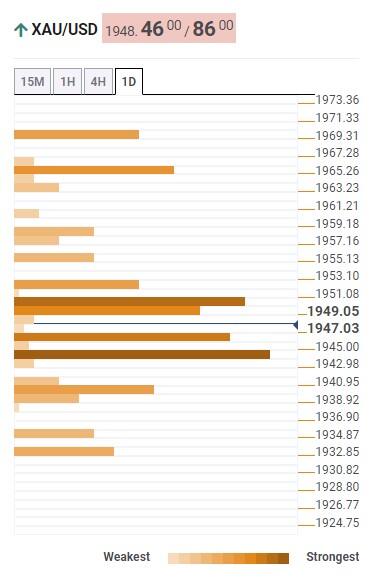
About Technical Confluences Detector
The TCD (Technical Confluences Detector) is a tool to locate and point out those price levels where there is a congestion of indicators, moving averages, Fibonacci levels, Pivot Points, etc. If you are a short-term trader, you will find entry points for counter-trend strategies and hunt a few points at a time. If you are a medium-to-long-term trader, this tool will allow you to know in advance the price levels where a medium-to-long-term trend may stop and rest, where to unwind positions, or where to increase your position size
- USD/JPY has shifted comfortably below 140.00 amid an extended correction in the USD index.
- FOMC minutes dictated that several Federal Reserve policymakers cited that more interest rates are less certain.
- Bank of Japan has remained room open for shortening the duration of bond yield targets to a 5-year zone from the current 10-year as a part of YCC.
- USD/JPY has added significant gains after delivering a breakout of the Ascending Triangle pattern.
The USD/JPY pair has shifted its auction below the crucial support of 140.00 in the Asian session. The asset turned delicate following the footprints of the US Dollar Index (DXY). The USD Index has extended its correction to near 104.11 after failing to hold a fresh two-month high at 104.31. The correction in the USD/JPY pair seems higher in proportion than the correction in the USD index, which also indicates that the Japanese Yen has also gained some strength.
S&P500 futures have extended losses in the Asian session, portraying an extension in the risk-aversion theme. US equities were significantly bought on Thursday led by a solid recovery in technology and financial stocks. Meanwhile, investors are getting anxious as negotiations among White House officials and Republican leaders seem never-ending due to which the United States economy is approaching a default situation swiftly.
Fears of a default by the US economy are fueling gains in US Treasury yields. The yields offered on 10-year US government bonds have climbed above 3.83%.
On Friday, a power-pack action is expected from the USD Index amid the release of the US Durables Goods Orders data (April). The economic data is seen contracting by 1.0% against an expansion of 3.2% reported earlier.
Federal Reserve policymakers support no rate hike in June
Plenty of economic indicators in the United States economy are appealing for a pause in the policy-tightening spell by the Federal Reserve (Fed) in its June monetary policy meeting. US labor market conditions have started releasing heat, Consumer Price Index (CPI) is consistently decelerating, and firms are anticipating a bleak economic outlook. On Thursday, Reuters reported that weekly Federal Reserve emergency lending to banks fell to its lowest level since the banking sector ran into trouble in March. This indicates that firms are deploying their retained earnings to cater to their working capital requirements to avoid higher interest rates or are operating at a lower capacity.
Investors should note that minutes from May’s Federal Open Market Committee (FOMC) dictate that several Federal Reserve policymakers cited that more interest rates are less certain due to tight credit conditions by US regional banks.
Expectations of a hold in the rate-hiking spell for June got more solid after dovish commentary from Boston Federal Reserve Bank President Susan Collins said on Thursday that the Federal Reserve "may be at or near" the time to pause interest rate increases, as reported by Reuters. She further added, "While inflation is still too high, there are some promising signs of moderation,"
Bank of Japan could tweak Yield Control Curve ahead
Bank of Japan (BoJ) Governor Kazuo Ueda said on Thursday that they could tweak the Yield Curve Control (YCC) strategy if the balance between the benefit and the cost of the policy were to shift. The Bank of Japan has remained room open for shortening the duration of bond yield targets to a 5-year zone from the current 10-year as a part of YCC.
Meanwhile, the Japanese Yen has got some strength after the release of decelerated Tokyo CPI (May) data. Headline inflation has softened to 3.2% from the prior release of 3.5% while the street was anticipating acceleration to 3.9%. Core CPI that excludes oil and food prices landed lower at 3.9% vs. the estimates of 4.3% but remained higher than the former release of 3.8%.
USD/JPY technical outlook
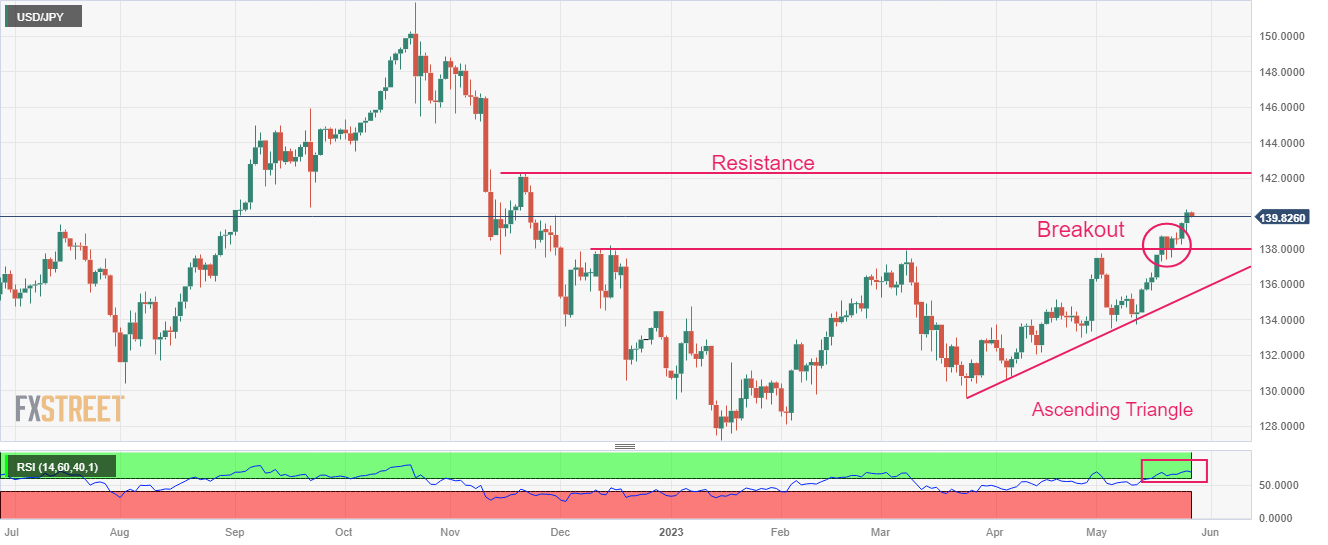
USD/JPY has added significant gains after delivering a breakout of the Ascending Triangle chart pattern formed on the daily scale. The asset is aggressively marching towards the horizontal resistance plotted from 11 November 2022 high at 142.25.
The Relative Strength Index (RSI) (14) is oscillating in the bullish range of 60.00-80.00, which indicates that the upside momentum is active.
- EUR/USD picks up bids to rebound from two-month low, snaps three-day losing streak.
- Ascending trend line from November 2022, 200-day EMA challenges Euro bears amid downbeat RSI (14).
- Buyers need validation from 100-day EMA, three-week-old resistance line guards immediate recovery.
EUR/USD consolidated weekly losses at the lowest levels since late March, mildly bid near 1.0735 during early Friday morning in Europe.
In doing so, the major currency pair prints the first daily gains in four while bouncing off a six-month-long rising trend line.
That said, the recently oversold RSI (14) line adds strength to the EUR/USD pair’s corrective bounce. However, bearish MACD signals and a downward-sloping resistance line from early May, close to 1.0765 at the latest, challenge the Euro pair buyers.
Even if the EUR/USD buyers manage to cross the 1.0765 hurdle, the 100-day Exponential Moving Average (EMA) of around 1.0780 can act as the last defense of the EUR/USD bears before directing it to the mid-month peak surrounding 1.0900.
It should be noted that the EUR/USD remains bearish unless crossing the 1.1000 psychological magnet.
On the flip side, the aforementioned support line and the 200-day EMA, respectively near 1.0710 and 1.0685, restrict the short-term EUR/USD downside.
Following that a slump towards the yearly low marked in March around 1.0515 can’t be ruled out.
Overall, EUR/USD remains on the bear’s radar despite the latest corrective bounce.
EUR/USD: Daily chart
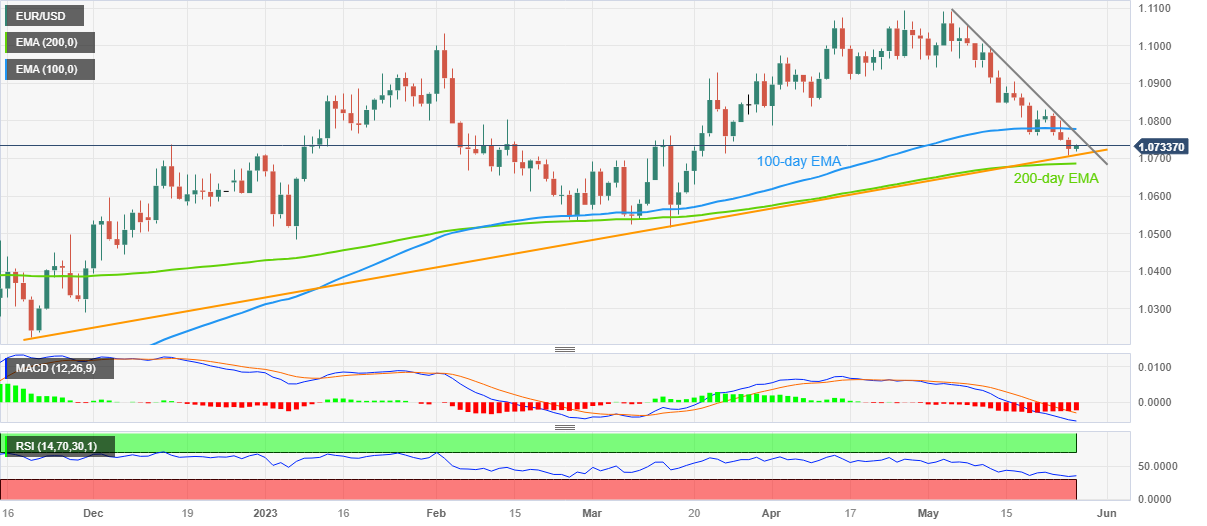
Trend: Bearish
- Market sentiment turns dicey as US policymakers remain hopeful of avoiding default but are yet to offer the much-awaited deal.
- S&P500 Futures print mild losses, yields grind near multi-day high amid sluggish markets.
- Upbeat US data underpins hawkish Fed bias and also prod risk appetite.
- Anxiety ahead of US data dump, looming US default deadline also pushback optimists.
Risk profile remains downbeat during early Friday as concerns about US debt limit expiration flash mixed signals. Adding to the market jitters can be the cautious mood ahead of the Federal Reserve’s (Fed) preferred inflation gauge and the US Durable Goods Orders for April.
While portraying the mood, S&P500 Futures print mild losses around 4,150, fading the previous day’s corrective bounce, whereas the US 10-year and two-year Treasury bond yields seesaw near the highest levels since early March, close to 3.82% and 4.54% in that order. It’s worth noting that the US Dollar Index (DXY) retreats from a 2.5-month high to 104.17 by the press time whereas the Gold price portrays a corrective bounce near $1,947 at the latest.
US policymakers’ inability to clinch a deal on the US debt ceiling extension contrasts with the chatters suggesting a $70.0 billion gap left to be filled by the negotiators to get the much-awaited deal. Recently, US House Speaker Kevin McCarthy announced no agreement on the debt deal, as well as the continuation of talks by saying, “It’s hard. But we’re working and we’re going to continue to work until we get this done.”
It should be noted that the US Treasury Department keeps flagging recession woes if the policymakers fail to reach a deal on the US debt ceiling extension before June.
Elsewhere, upbeat US data underpins hawkish Fed bets and weigh on the market sentiment. On Thursday, the second estimation of the US Annualized Gross Domestic Product (GDP) for Q1 2023 was revised up to 1.3% versus 1.0% first forecasts. Further, the Chicago Fed National Activity Index for April improved to 0.07 from -0.37 prior and -0.02 market estimations. On the same line, Kansad Fed Manufacturing Activity improved to -2 for May compared to -21 previous readings and analysts’ estimations of -11. It’s worth noting that the US Pending Home Sales for April improved on YoY but eased on MoM whereas Core Personal Consumption Expenditures also rose to 5.0% during the preliminary readings versus 4.9% prior.
Even so, mixed comments from the Fed policymakers prod the hawkish bias about the US central bank and defend the risk profile. In his latest speech, Richmond Fed President Thomas Barkin said, “Fed is in a test and learn situation to determine how slowing demand lowers inflation.” On the different front, Boston Federal Reserve President Susan Collins said on Thursday that the Fed "may be at or near" the time to pause interest rate increases, as reported by Reuters.
Looking forward, US debt ceiling negotiations will be crucial to gauge the market moves while the US Durable Goods Orders for April and the Core Personal Consumption Expenditure (PCE) Price Index for the said month, known as the Fed’s preferred inflation gauge, can also entertain the traders.
Also read: Forex Today: US Dollar remains firm and antipodeans fall off a cliff
| Raw materials | Closed | Change, % |
|---|---|---|
| Silver | 22.726 | -1.44 |
| Gold | 1940.61 | -0.91 |
| Palladium | 1417.73 | 0.27 |
- USD/CHF renews intraday low while reversing from six-week high.
- U-turn from resistance line of rising wedge bearish pattern tease sellers despite upbeat oscillators.
- 50-DMA adds strength to 0.9000 support confluence, a break of which could welcome Swiss Franc buyers.
USD/CHF takes offers to refresh the intraday low near 0.9040 as it prints the first daily loss in four during early Friday. In doing so, the Swiss Franc pair retreats from the resistance line of a three-week-old rising wedge bearish chart formation.
It’s worth noting, however, that the MACD indicator flashes bullish signals and the RSI (14) line is also above the 50.0 level, which in turn suggests the USD/CHF pair’s bullish momentum strength and keeps the bear’s off the table.
Also challenging the USD/CHF sellers is the 0.9000 support confluence comprising the 50-DMA and bottom line of the aforementioned wedge.
In a case where the USD/CHF price manages to provide a daily close below the 0.9000 mark, it becomes theoretically vulnerable to renewing the yearly low by dropping to the 0.8750 mark.
That said, the multiple levels around 0.8860-50 and the monthly low of bear 0.8820 may prod the sellers.
Meanwhile, the current place of the stated rising wedge’s top line, near 0.9075, precedes the 0.9100 round figure and April 10 peak of around 0.9115 to challenge the USD/CHF buyers.
Following that, a run-up towards the 61.8% Fibonacci retracement level of March-May downside near 0.9205 can’t be ruled out.
USD/CHF: Daily chart
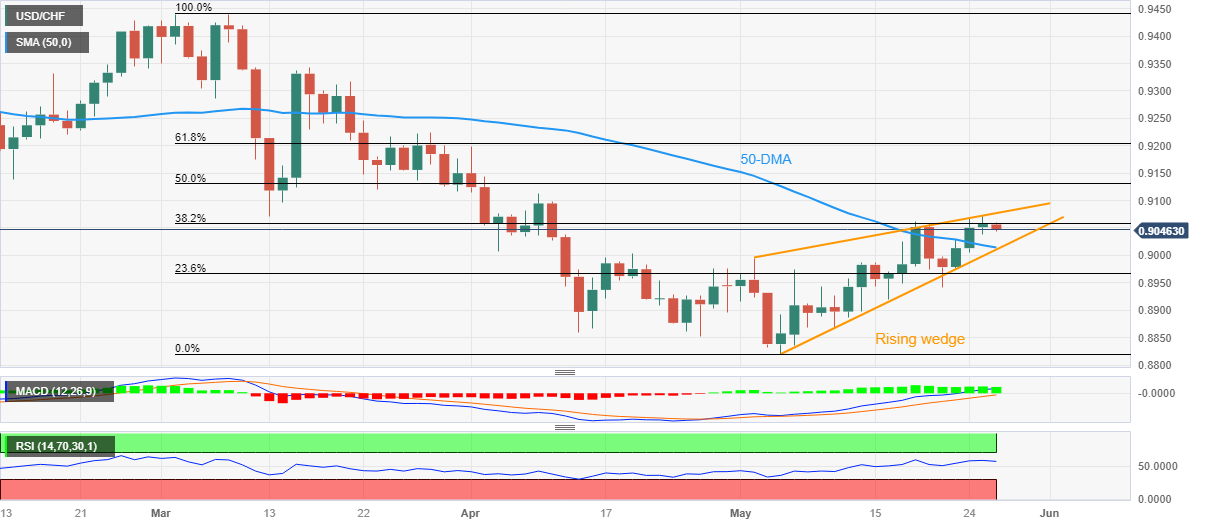
Trend: Pullback expected
Japan Finance Minister Shunichi Suzuki said on Friday, “FX rates should be set by the market based on fundamentals.”
Additional takeaways
Japan remains world's largest net creditor nation for 32 years in row as of 2022.
Closely watching FX moves.
Closely watching US debt ceiling talks.
Won't comment in detail on assumption US may default on its debt.
There are concerns about impact on global economy if US defaulted on its debt.
Related reads
- USD/JPY reverses pullback from yearly top near 140.00 on mixed Tokyo inflation, upbeat yields
- BoJ’s Ueda: Targeting 5-year JGBs from 10-year JGBs is among options if needed
- AUD/NZD takes offers to refresh intraday low as Aussie Retail Sales eased in April.
- RBNZ Officials flash mixed signals after failing to impress markets with 0.25% rate hike.
- Cautious markets also exert downside pressure on exotic pair price.
AUD/NZD drops to 1.0710 as it bears the burden of downbeat Australia Retail Sales, as well as mixed comments from the Reserve Bank of New Zealand (RBNZ) officials on early Friday. Also weighing on the exotic pair is the market’s risk-off mood amid looming US default fears.
Australia's Retail Sales growth dropped to 0.0% in April versus 0.2% market forecasts and 0.4% prior.
Earlier in the day, RBNZ Assistant Governor Karen Silk noted that Cyclone Gabrielle was less inflationary than first feared and stated that rates need to stay on hold for an extended period. Previously, RBNZ Deputy Governor Christian Hawkesby announced the easing of the Loan-to-Value Ratio (LVR) restrictions. Furthermore, New Zealand’s Consumer Confidence gauge slightly fell to 79.2 in May from April's 79.3, per the ANZ-Roy Morgan survey for May.
It should be noted that the RBNZ’s failure to impress the markets with 0.25% rate hike, mainly due to the unchanged peak rate forecasts, raised fears of the Reserve Bank of Australia’s (RBA) policy pivot and weigh on the Australian Dollar (AUD) in the last two days.
That said, the looming fears of the US default also allow the US Dollar to dominate. Recently, US House Speaker Kevin McCarthy announced no agreement on the debt deal, as well as the continuation of talks by saying, “It’s hard. But we’re working and we’re going to continue to work until we get this done.”
Against this backdrop, S&P500 Futures print mild losses whereas the US 10-year and two-year Treasury bond yields seesaw near the early March highs of around 3.82% and 4.54% in that order.
Looking ahead, a light calendar in the Asia-Pacific zone makes AUD/NZD vulnerable to risk catalysts.
Technical analysis
Despite repeated failure to provide a daily close beyond the 50-DMA hurdle surrounding 1.0730, the AUD/NZD pair remains on the bull’s radar as it crossed a three-week-old resistance line earlier in the week, now immediate support near 1.0690.
Bank of Japan (BoJ) Governor Kazuo Ueda is delivering some comments on the central bank’s monetary policy outlook on Friday.
Key quotes
“Falling raw material costs likely to slow inflation in coming months.”
“BoJ must avoid tightening monetary policy prematurely to ensure Japan sustainably achieves its 2% target.”
The BoJ could make tweaks to YCC "if the balance between the benefit and cost of the policy shifts."
"If the BoJ were to modify YCC in the future, there are various ways of doing so.”
“Shortening the duration of bond yields it targets to the five-year zone from the current 10-year zone could be among options."
"But I won't comment on whether we would definitely do so, how likely this could happen, or under what conditions the BoJ would see this option as desirable.”
Market reaction
USD/JPY is off the yearly highs of 140.23, consolidating at around 139.85, as of writing. The pair is down 0.14% on the day.
- NZD/USD daily bears are in the market below key levels.
- NZD/USD has broken structure and bears now eye lower lows.
NZD/USD bears are in the market and breaking structures with eyes on lower lows for the days ahead as the following analysis will illustrate. The bulls are gathered, however, and a correction could be on the cards in the meanwhile.
NZD/USD daily charts
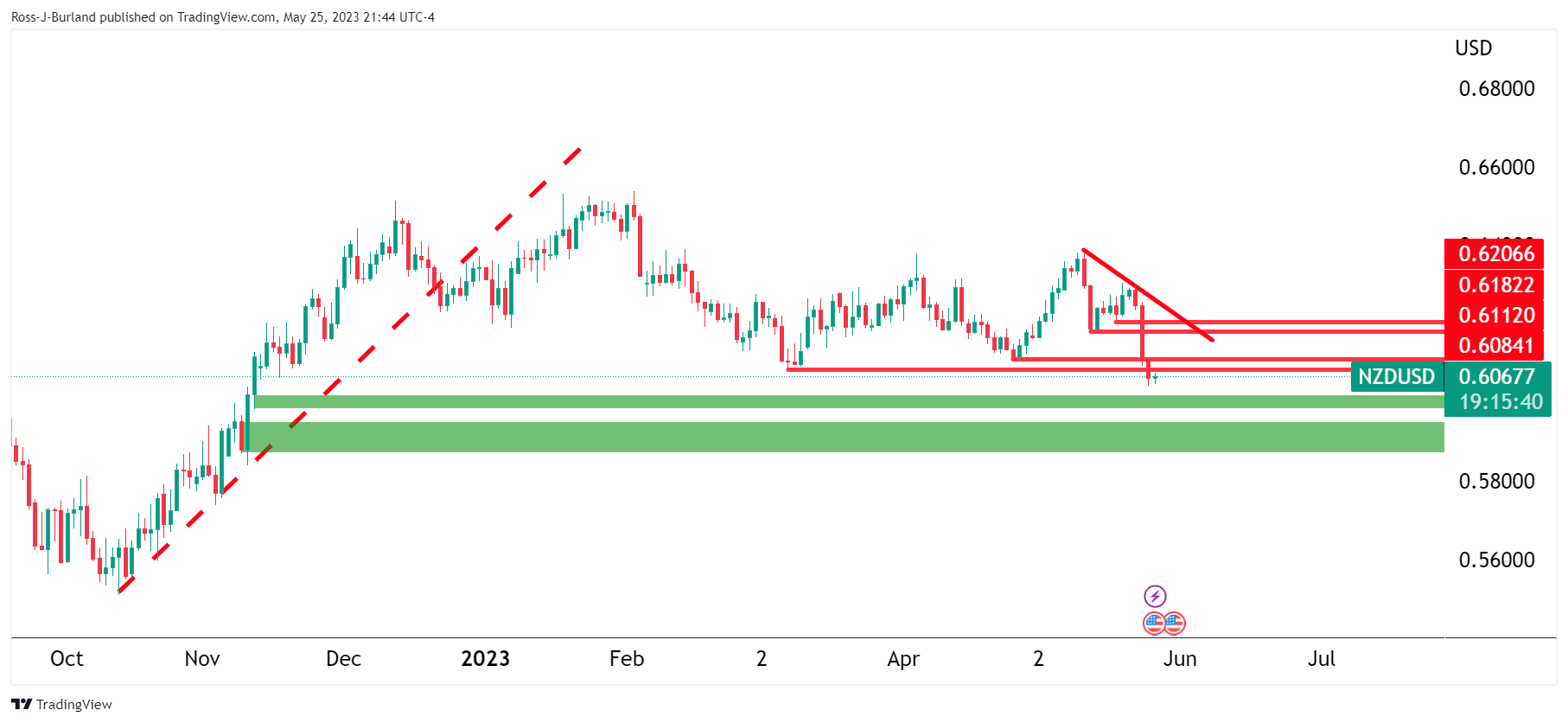
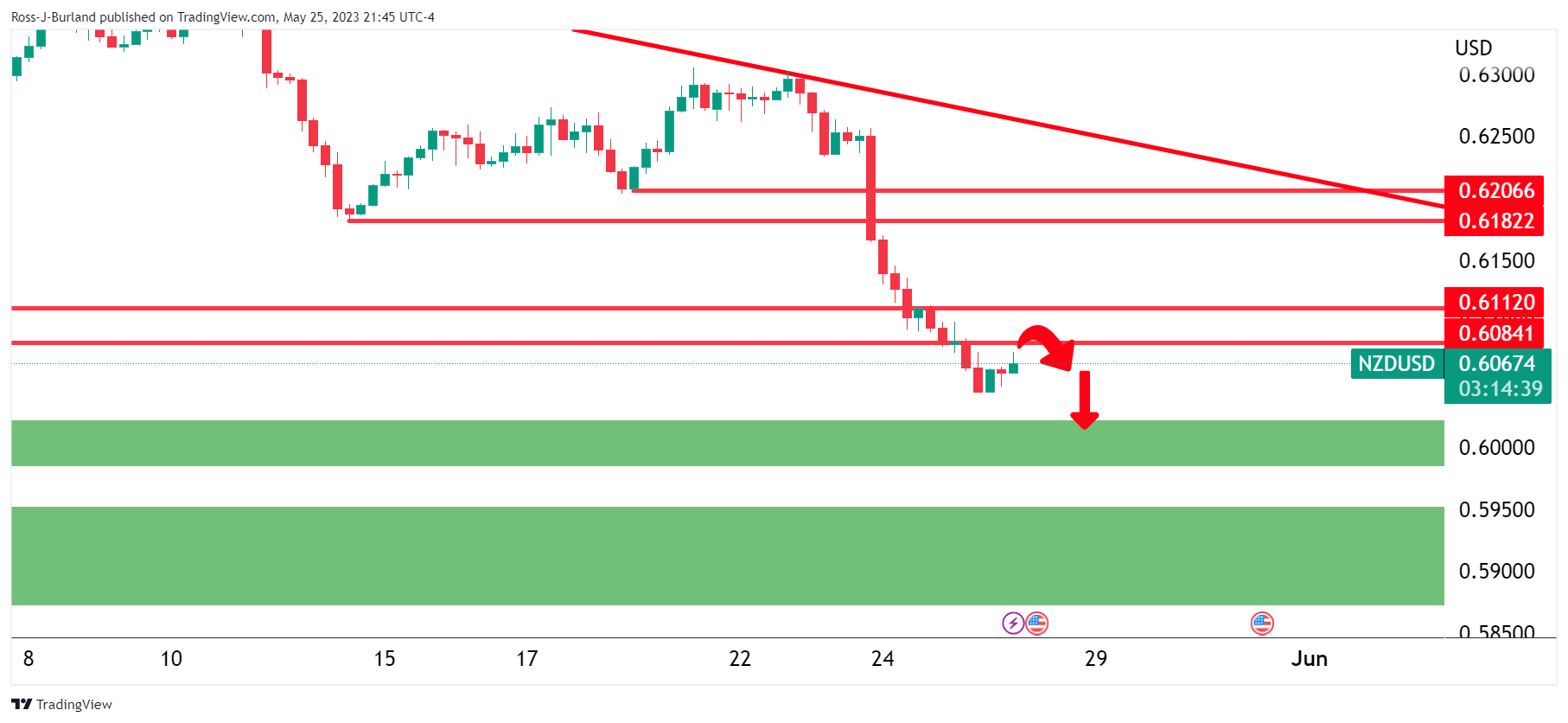
We have the price coming up towards the 0.6080s which could prove to be a tough resistance area. 0.6112 would prove to be key after there. If bulls commit, then a move toward 0.6180s could be on the cards.
- AUD/USD has not shown any move despite the release of stagnant Australian Retail Sales data.
- Weak Australian households’ demand would impact Australian inflation ahead.
- Fed Collins cited that while inflation is still too high, there are some promising signs of moderation.
The AUD/USD pair as the Australian Bureau of Statistics has reported stagnant monthly Retail Sales data (April). The street was anticipating an expansion by 0.2% while previously it expanded by 0.4%. A decline in households demand is expected to strengthen the odds of a neutral interest rate policy stance by the Reserve Bank of Australia (RBA) for June’s monetary policy meeting.
In May’s monetary policy meeting, RBA Governor Philip Low hiked interest rates surprisingly by 25 basis points (bps) to 3.85%. RBA believed that the current monetary policy is not restrictive enough to tame sticky inflation.
S&P500 futures have posted some losses in early Asia, portraying anxiety among investors inspired by continuous delay in US debt-ceiling negotiations. Republican delegates are not agreeing on higher spending in the budget if the White House wants to raise the current $31.4 trillion US borrowing cap.
The US Dollar Index (DXY) has extended its correction after analyzing signs of exhaustion in the upside momentum. The USD Index has faced barricades in extending its upside above 104.31. It seems that investors have started shifting focus on expectations over Federal Reserve’s (Fed) June policy meeting.
Boston Fed Bank President Susan Collins said on Thursday that the Fed "may be at or near" the time to pause interest rate increases, as reported by Reuters. She further added, "While inflation is still too high, there are some promising signs of moderation,"
- AUD/JPY justifies its risk barometer status at weekly low, prints four-day downtrend.
- Australia Retail Sales for April eased below forecast and prior, Tokyo inflation came in mixed.
- Market sentiment worsens amid US default fears, propel yields.
- Mixed signals from BoJ, Japan’s economic optimism versus RBA’s hesitance also weigh on cross currency price.
AUD/JPY fades bounce off the intraday low after Australia Retail Sales growth stagnated in April, per the data released early Friday. In doing so, the cross-currency pair drops for the fourth consecutive day while poking the 90.90 level by the press time. Apart from the downbeat Aussie data, challenges to the risk profile and mixed Japan inflation numbers, as well as promising signals from Tokyo, also weigh on the risk barometer pair.
Australia's Retail Sales growth dropped to 0.0% in April versus 0.2% market forecasts and 0.4% prior. It should be noted that the RBNZ’s failure to impress the markets with 0.25% rate hike, mainly due to the unchanged peak rate forecasts, raised fears of the Reserve Bank of Australia’s (RBA) policy pivot and weigh on the Australian Dollar (AUD) in the last two days.
Earlier in the day, Tokyo Consumer Price Index (CPI) eased to 3.2% YoY from 3.5% previous readings and 3.9% market forecasts. On the same line is the Tokyo CPI ex Fresh Food while the Tokyo CPI ex Food, Energy edged higher but stays below the market forecasts for the said month.
Talking about the risk, the looming fears of the US default also allow the US Dollar to dominate. Recently, US House Speaker Kevin McCarthy announced no agreement on the debt deal, as well as the continuation of talks by saying, “It’s hard. But we’re working and we’re going to continue to work until we get this done.”
It should be noted that the recent hawkish concerns about the Bank of Japan’s (BoJ) next move, backed by Governor Kazuo Ueda’s latest comments and economic optimism in the nation, also exert downside pressure on the AUD/JPY price.
On Thursday, Bank of Japan (BoJ) Governor Kazuo Ueda said that they could tweak the Yield Curve Control (YCC) strategy if the balance between the benefit and the cost of the policy were to shift, as reported by Reuters. Further, the Japanese Cabinet Office released the monthly assessment report on Thursday and raised the overall economic view for the first time since July 2022 in May. The government report also noted that the economy is 'recovering moderately'.
Amid these plays, S&P500 Futures print mild losses whereas the US 10-year and two-year Treasury bond yields seesaw near the early March highs of around 3.82% and 4.54% in that order. Hence, the risk profile is sour and keeps the AUD/JPY bears hopeful.
Technical analysis
A daily closing below a three-week-old ascending support line, now resistance around 91.15, directs AUD/JPY price toward the 100-DMA of 90.40.
The Retail Sales released by the Australian Bureau of Statistics arrived as follows:
- 0% (forecast 0.3%, previous 0.4%).
AUD/USD has been pressured on the 5-minute chart as follows:

About the Retail Sales
The Retail Sales released by the Australian Bureau of Statistics is a survey of goods sold by retailers is based on a sampling of retail stores of different types and sizes and it''s considered as an indicator of the pace of the Australian economy. It shows the performance of the retail sector over the short and mid-term. Positive economic growth anticipates bullish trends for the AUD, while a low reading is seen as negative or bearish.
In recent trade today, the People’s Bank of China (PBOC) set the yuan at 7.0760 vs. the last close of 7.0795.
About the fix
China maintains strict control of the yuan’s rate on the mainland.
The onshore yuan (CNY) differs from the offshore one (CNH) in trading restrictions, this last one is not as tightly controlled.
Each morning, the People’s Bank of China (PBOC) sets a so-called daily midpoint fix, based on the yuan’s previous day's closing level and quotations taken from the inter-bank dealer.
- USD/CAD seesaws at the highest level in a month amid three-day winning streak.
- Risk-off mood weighs on Oil price, allows US Dollar to remain firmer despite latest pullback.
- Upbeat US data, looming concerns about US default keeps Loonie traders on their toes.
- US Durable Goods Orders, Fed’s preferred inflation gauge eyed for clear directions.
USD/CAD bulls take a breather after refreshing the monthly high, retreating to 1.3645 during the mid-Asian session on Friday. In doing so, the Loonie pair takes clues from the latest retreat in the US Dollar price while also justifying the downbeat Oil prices and sour sentiment.
While the US Dollar’s pullback could be linked to a cautious mood ahead of the key data, fears surrounding the US default and upbeat US Q1 GDP, as well as other activity numbers, keep the Loonie pair buyers hopeful. Additionally, mixed feeling about the Oil price adds trading filters to the USD/CAD price.
That said, the US Dollar Index (DXY) retreated from the highest levels since March 13 to 104.17 by the press time as traders await the US Durable Goods Orders for April and the Core Personal Consumption Expenditure (PCE) Price Index for the said month, known as the Fed’s preferred inflation gauge.
On Thursday, the second estimation of the US Annualized Gross Domestic Product (GDP) for Q1 2023 was revised up to 1.3% versus 1.0% first forecasts. Further, the Chicago Fed National Activity Index for April improved to 0.07 from -0.37 prior and -0.02 market estimations. On the same line, Kansad Fed Manufacturing Activity improved to -2 for May compared to -21 previous readings and analysts’ estimations of -11. It’s worth noting that the US Pending Home Sales for April improved on YoY but eased on MoM whereas Core Personal Consumption Expenditures also rose to 5.0% during the preliminary readings versus 4.9% prior.
However, hawkish Fed bets and the US debt ceiling expiration concerns allow the US Dollar to dominate. Recently, US House Speaker Kevin McCarthy announced no agreement on the debt deal, as well as the continuation of talks by saying, “It’s hard. But we’re working and we’re going to continue to work until we get this done.”
On the other hand, WTI crude oil remains indecisive around $71.85 as it struggles to cheer the US Dollar’s retreat amid hopes of witnessing the $80.00 price, suggested by Russian Deputy Prime Minister Alexander Novak on Thursday.
While portraying the mood, S&P500 Futures print mild losses while the Yields grind higher amid the market’s indecision, which in turn prod the USD/CAD bulls ahead of the key US data and looming debt payment default.
Technical analysis
USD/CAD bulls need validation from the previous monthly high of around 1.3665-70 to keep the reins. That said, the overbought RSI conditions suggest a pullback towards the previous resistance line stretched from March, around 1.3540 at the latest.
- GBP/JPY bulls are in the market and eye breakout.
- Bears need to see the structures broken on the downside.
GBPJPY has been riding trendline support in the upper end of a box as the following will illustrate:
GBP/JPY H1 chart
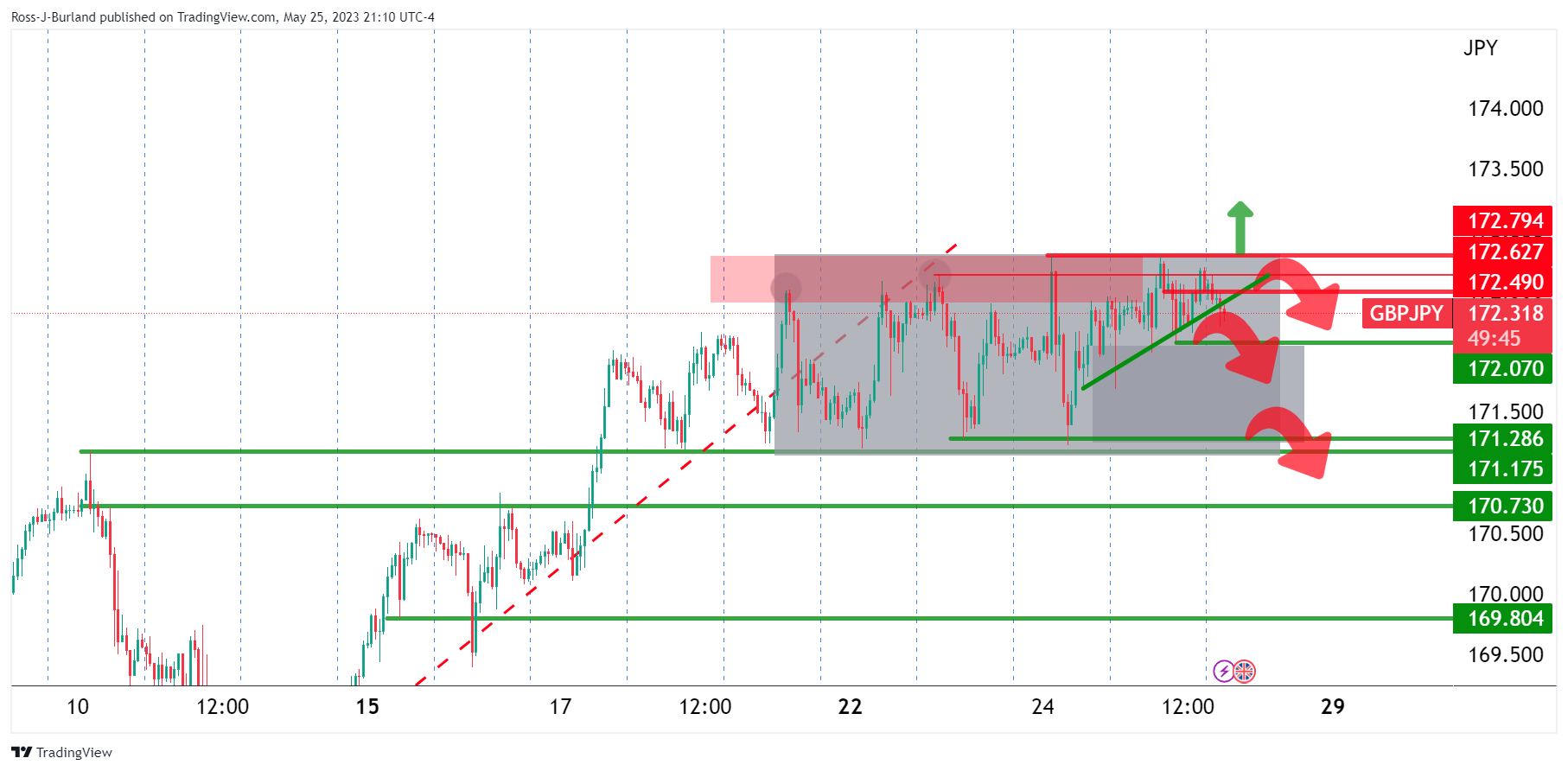
A break of 172.00 needs to occur with 171.20s next in line as a potential target. On the flip side, the price could easily break higher and out of the resistance marked at 172.80.
GBP/JPY daily charts
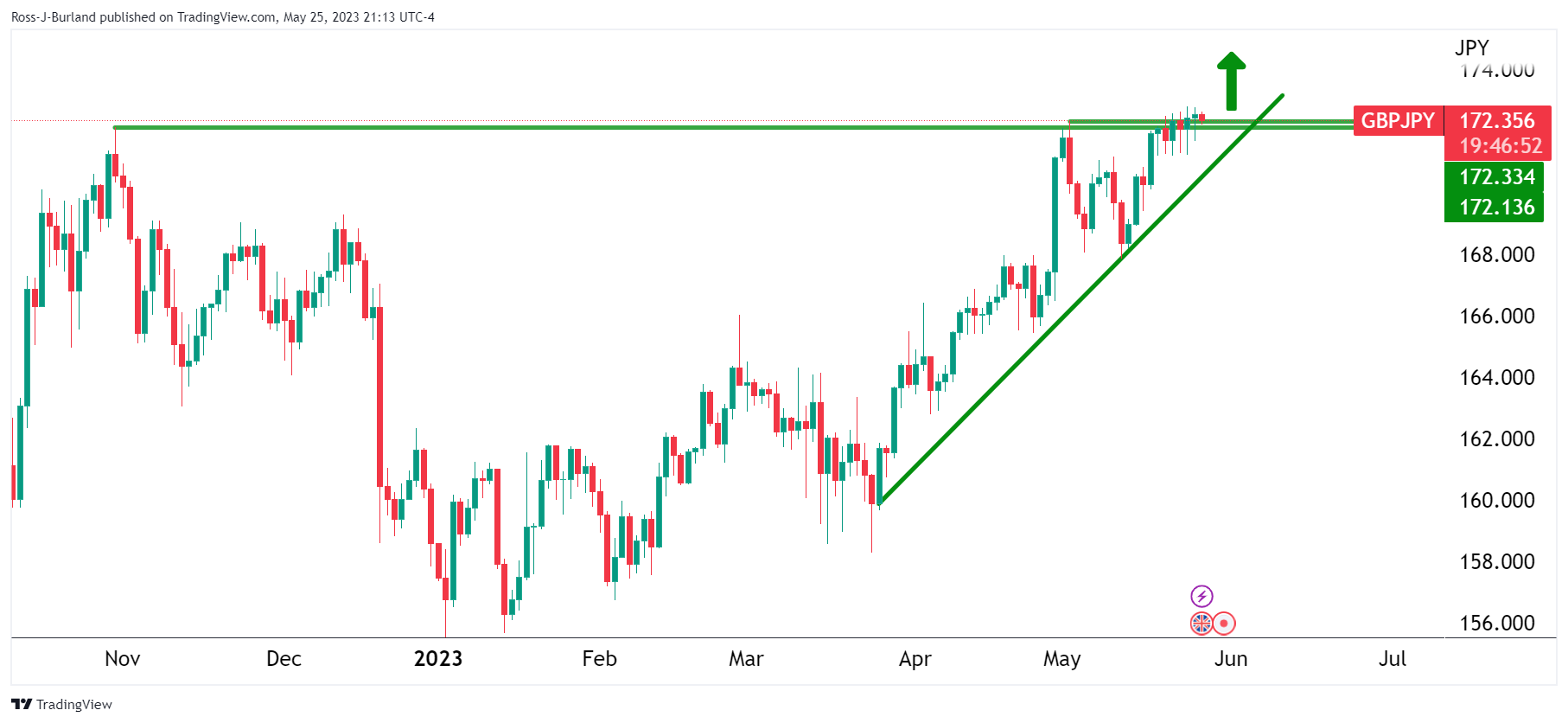
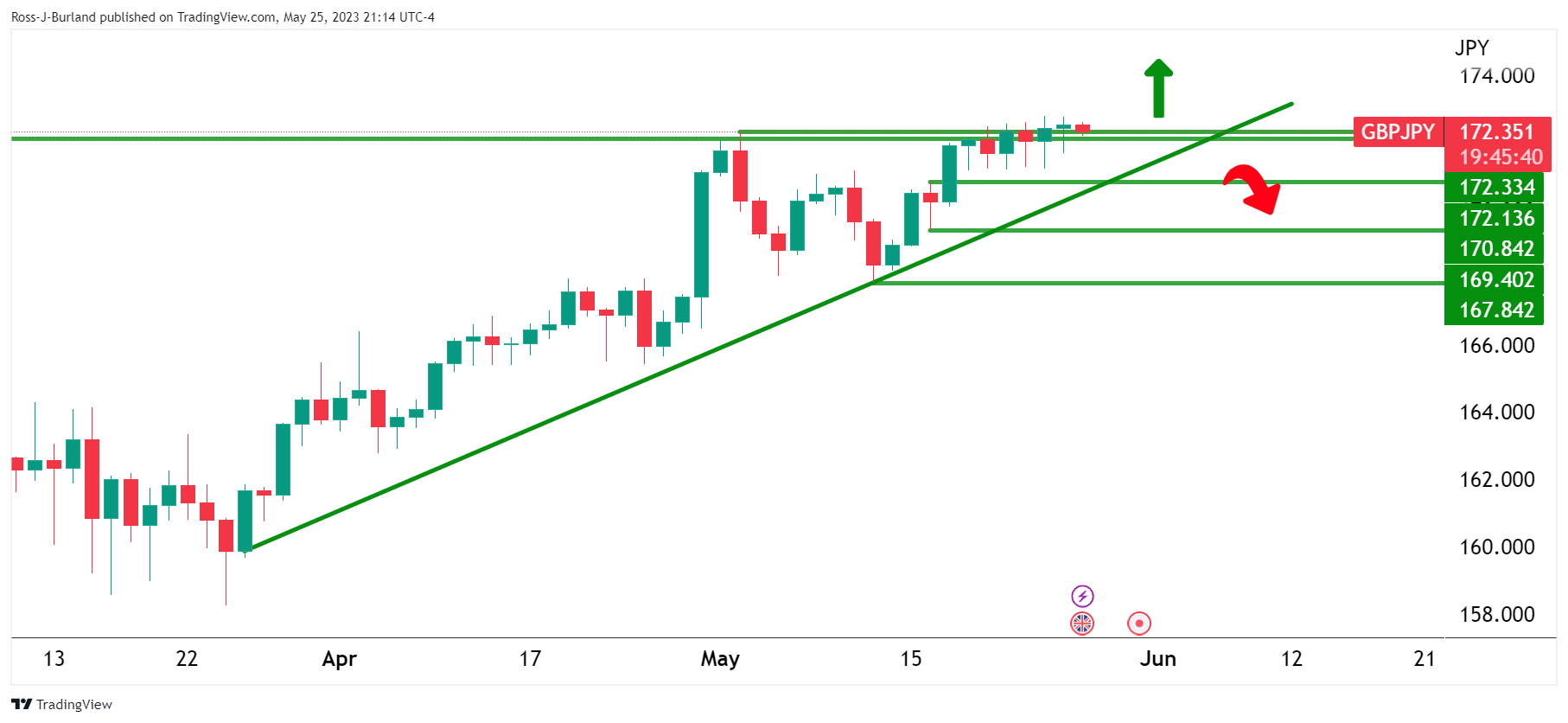
GBP/JPY monthly chart
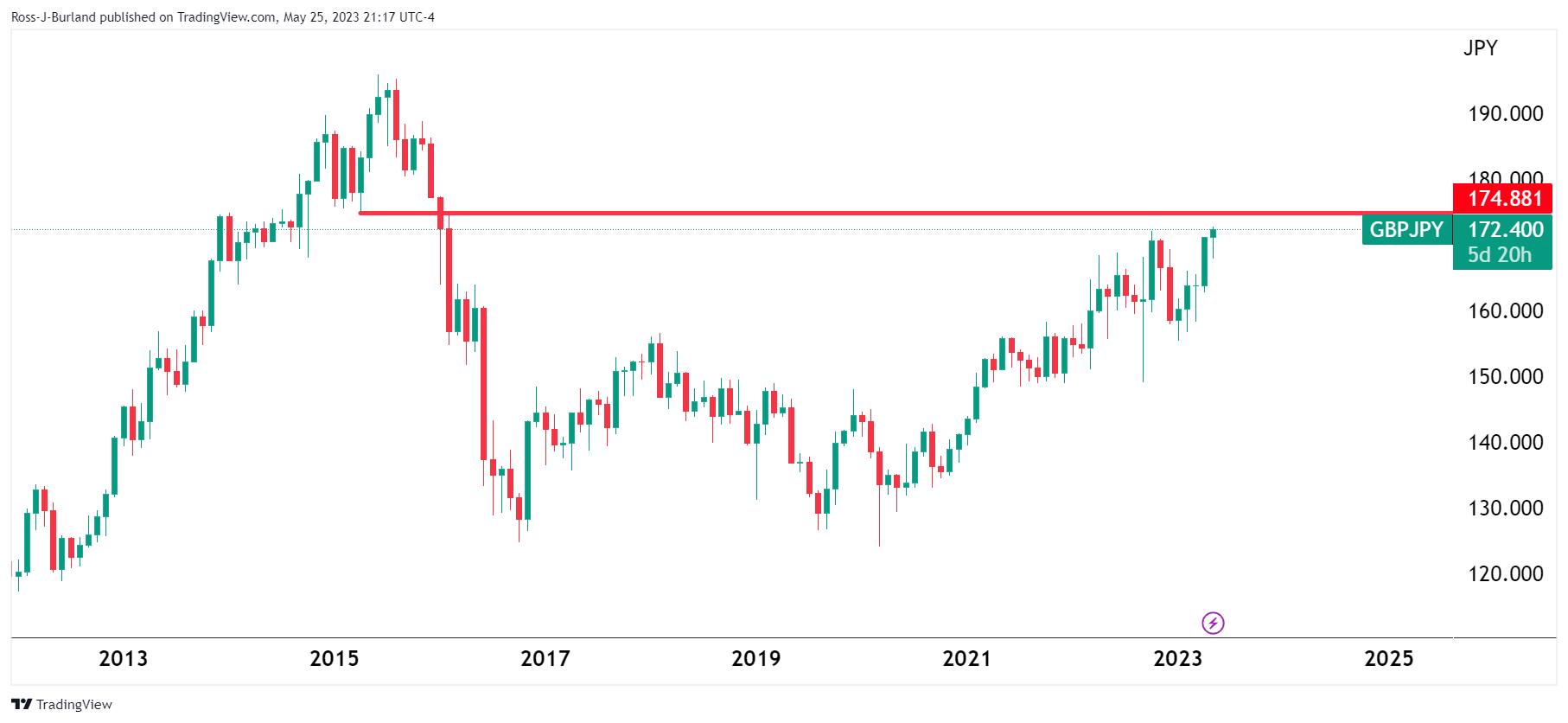
GBP/JPY is on the approach to higher highs as per the monthly chart outlook with 174.80s and 175.00 eyed.
- EUR/GBP has shifted its auction comfortably above 0.8700 ahead of UK Retail Sales.
- ECB Knot believes that the central bank needs to raise the policy rate at least two more times.
- The German economy has entered into recession after posting two consecutive GDP contractions quarterly.
The EUR/GBP pair has comfortably shifted above the round-level resistance of 0.8700 in the Asian session. The asset has gained significant strength as the European Central Bank (ECB) is expected to announce more interest rate hikes ahead to tame stubborn Eurozone inflation.
On Thursday, European Central Bank (ECB) policymaker Klaas Knot said that the ECB needs to raise the policy rate at least two more times, as reported by Reuters. He further argued that rates should stay put for a significant period of time following these increases.
Investors should note that ECB President Christine Lagarde has already announced that more than one interest rate hike is appropriate for stick inflationary pressures.
Considering Eurozone’s economic prospects, higher interest rates by the ECB have pushed the German economy into recession. On a quarterly basis, German Gross Domestic Product (GDP) contracted by 0.3% in the first quarter of CY2023. Investors should be aware that the nation also posted a contraction in Q4 last year of 0.5%. A consecutive quarterly contraction in GDP figures indicates that the economy is in a recession phase.
German Finance Minister Christian Lindner said on Thursday that comparing Germany with other highly developed economies, the economy was losing potential for growth, as reported by Reuters.
On the Pound Sterling front, investors are awaiting the release of the United Kingdom’s Retail Sales data (April). Monthly Retail Sales are seen expanding by 0.3% against a contraction of 0.9% reported last month. While annual Retail Sales are expected to contract by 2.8% vs. a contraction of 3.1%. A rebound in retail demand could fuel inflationary pressures and create more troubles for the Bank of England (BoE).
- GBP/USD stays bearish at the lowest levels in seven weeks, down for the fourth consecutive day.
- UK Retail Sales growth is expected to improve in April, suggesting hardships for Cable bears amid nearly oversold RSI.
- Two-week-old falling support line, 100-DMA restrict immediate downside of the Pound Sterling.
- Recovery remains elusive below 50-DMA, 1.2370 can tame corrective bounce.
GBP/USD remains on the back foot at a two-month bottom as sellers prod a short-term support line ahead of the key UK Retail Sales data on early Friday. In doing so, the Pound Sterling struggles to extend the three-day losing streak around 1.2320-15 by the press time.
That said, the UK Retail Sales for April, expected 0.3% MoM versus -0.9% prior, can join the aforementioned two-week-old support line and nearly oversold RSI (14) line to challenge the Cable pair sellers.
However, a downward-sloping resistance line from May 10, close to 1.2370 at the latest, could challenge the GBP/USD pair’s further recovery.
Even if the Cable pair remains firmer past 1.2370, the 50-DMA hurdle of around 1.2435 may act as the last defense of the bears before giving control to the bulls.
On the flip side, a clear break of the immediate support line near 1.2300 could aim for the 100-DMA support of 1.2285.
Following that, a horizontal area comprising levels marked since March 13 and the 61.8% Fibonacci retracement of its March-May upside, respectively around 1.2190-85 and 1.2140 in that order, could challenge the GBP/USD bears.
GBP/USD: Daily chart
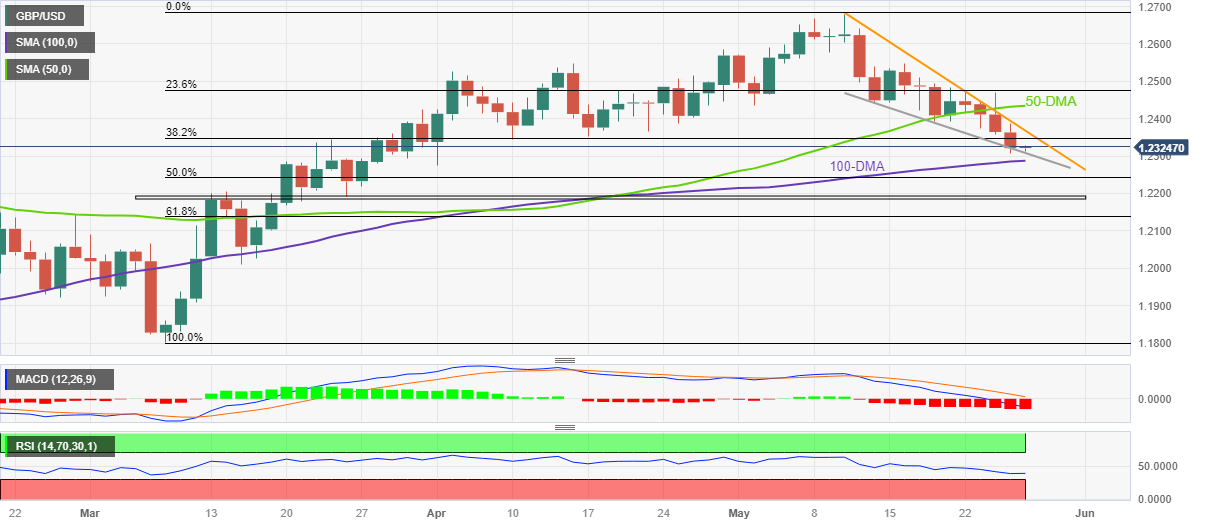
Trend: Limited downside expected
- Gold price has dropped after struggling above $1,940.00 as the US Dollar Index is possessing immense strength.
- Fed Collins cited that the Fed "may be at or near" the time to pause interest rate increases.
- Gold price has turned imbalance after a breakdown of the consolidation formed in a range of $1,952-1,985.
Gold price (XAU/USD) has extended its downside further below the immediate support of $1,940.00 in the Asian session. Earlier, the precious metal displayed a vertical downfall after slipping below the $1,952.00 cushion as the United States economy is approaching a default situation amid divergence in views over the budget among the White House and Republican delegates.
S&P500 futures have posted decent losses in the Asian session after a positive Thursday. Market sentiment is turning negative as investors are worried that the US treasury could announce a default in less than one week if negotiations between US President Joe Biden and House of Representatives Kevin McCarthy keep going like this.
The US Dollar Index (DXY) has rebounded firmly to near 104.28 after a mild correction. The USD Index is having immense strength despite expectations of a pause in the policy-tightening spell by the Federal Reserve (Fed) in June. Boston Fed Bank President Susan Collins said on Thursday that the Fed "may be at or near" the time to pause interest rate increases, as reported by Reuters. She further added, "While inflation is still too high, there are some promising signs of moderation,"
On Friday, US Durable Goods Orders data will be keenly watched. According to the consensus, Aril Durable Goods Orders data is seen contracting by 1.0% against an expansion of 3.2%. A decline in durable goods orders would weigh heavily on the core Consumer Price Index (CPI) which has shown severe persistence.
Gold technical analysis
Gold price has turned imbalance after a breakdown of the consolidation formed in a range of $1,952-1,985 on the daily scale. The precious metal has shifted into bearish territory and is expected to find support near May 13 high at $1,914.67.
The 10-period Exponential Moving Average (EMA) at $1,968.43 is acting as a barricade for the Gold bulls.
The Relative Strength Index (RSI) (14) has slipped below 40.00, showing no signs of divergence and an absence of evidence of oversold situation supports weakness ahead.
Gold daily chart
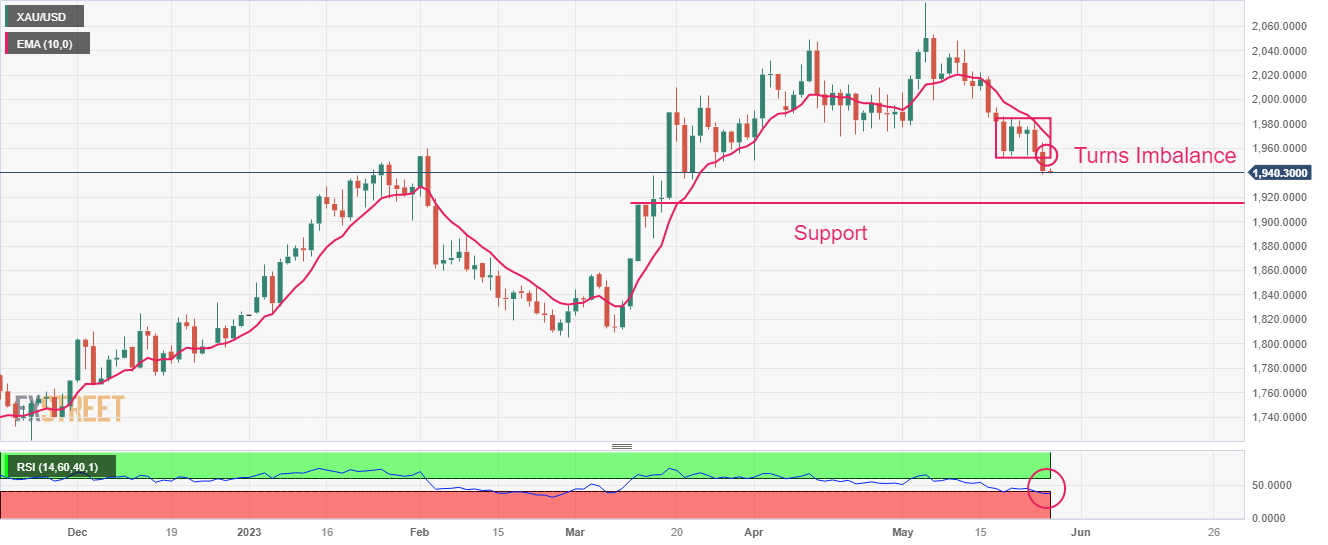
Retail Sales Overview
Early Friday, around 01:30 AM GMT, the market sees preliminary readings of Australia's seasonally adjusted Retail Sales for April month. Market consensus suggests an easing in the seasonally adjusted monthly print to 0.2% MoM, suggesting more headwinds for the pressure Reserve Bank of Australia (RBA), especially after the Reserve Bank of New Zealand’s dovish hike.
Given the less impact of the Reserve Bank of Australia's (RBA) latest hawkish surprise, as well as fresh talks of policy pivot in Australia and New Zealand, not to forget the mixed comments from the RBA officials, today’s Aussie Retail Sales data appears crucial for the AUD/USD traders.
How could it affect AUD/USD?
AUD/USD stays pressured at the lowest level in six months around 0.6500 as it braces for the downbeat Aussie data during early Friday. In doing so, the Aussie pair also bears the burden of the sour sentiment and the market’s cautious mood ahead of the key data/events.
That said, the recent chatters surrounding the Aussie recession, as well as receding monetary policy divergence between the RBA and the Fed, may seek validation from today’s Aussie Retail Sales data. Hence, recovery in the key statistics may allow the AUD/USD to lick its wounds at the yearly low.
It should be noted, however, that the Aussie data may have a knee-jerk reaction for the AUD/USD pair as traders are more interested in the US Durable Goods Orders for April and the Core Personal Consumption Expenditure (PCE) Price Index for the said month, known as the Fed’s preferred inflation gauge, not to forget the debt ceiling negotiations. Hence, even if the data posts any positive surprise, which is highly unlikely, the market reaction to the same will be short-lived.
Technically, a daily closing below the 0.6550 support confluence, now resistance, joins the bearish MACD signals to keep the AUD/USD sellers hopeful. That said, a downward-sloping trend line from late November 2022 and a 61.8% Fibonacci retracement level of the pair’s run-up from October 2022 to February 2023 constitute the 0.6550 key upside hurdle.
Key Notes
AUD/USD Price Analysis: Bears keep the reins near 0.6500 ahead of Aussie Retail Sales
AUD/USD Forecast: No respite for the Aussie in a risk-averse environment
About Australian Retail Sales
The Retail Sales released by the Australian Bureau of Statistics is a survey of goods sold by retailers based on a sampling of retail stores of different types and sizes and it's considered an indicator of the pace of the Australian economy. It shows the performance of the retail sector over the short and mid-term. Positive economic growth anticipates bullish trends for the AUD, while a low reading is seen as negative or bearish.
| Index | Change, points | Closed | Change, % |
|---|---|---|---|
| NIKKEI 225 | 118.45 | 30801.13 | 0.39 |
| Hang Seng | -369.01 | 18746.92 | -1.93 |
| KOSPI | -12.76 | 2554.69 | -0.5 |
| ASX 200 | -75.6 | 7138.2 | -1.05 |
| DAX | -48.33 | 15793.8 | -0.31 |
| CAC 40 | -24.19 | 7229.27 | -0.33 |
| Dow Jones | -35.27 | 32764.65 | -0.11 |
| S&P 500 | 36.04 | 4151.28 | 0.88 |
| NASDAQ Composite | 213.93 | 12698.09 | 1.71 |
- EUR/USD remains depressed at the lowest levels in two months after declining in the last three consecutive days.
- Germany’s negative revision to Q1 GDP supersedes hawkish ECB talks to weigh on Euro pair.
- Fears of US default, strong US statistics allow EUR/USD bears to keep the reins ahead of mid-ties US data.
EUR/USD bears occupy the driver’s seat around 1.0720 during Friday’s Asian session, near the two-month low marked the previous day. In doing so, the Euro pair justifies the broad US Dollar strength, as well as economic fears surrounding the Eurozone while keeping sellers hopeful after allowing them to dominate in the last three consecutive days.
On Thursday, the final reading of the German Gross Domestic Product (GDP) for Q1 2023 was revised down to -0.3% QoQ versus 0.0% estimated previously. Following the data, German Finance Minister Christian Lindner said on Thursday, “GDP data have shown surprisingly negative signals.”
Following that, European Central Bank (ECB) Governing Council member, Bostjan Vasle said in an interview with Slovenia’s Delo newspaper early Thursday that the central bank must continue raising interest rates further to bring inflation down to its target.
On the other hand, ECB Vice President Luis de Guindos said, “Downside inflation risks include banking tensions.”
Elsewhere, upbeat US data joins the fears of US default, as well as cautious mood ahead of a slew of the US statistics about Durable Goods Orders and inflation to underpin the latest run-up in the US Dollar and the yields. With this, the EUR/USD bears remain hopeful amid more positives for the US Dollar than those for the Euro.
Talking about data, the second estimation of the US Annualized Gross Domestic Product (GDP) for Q1 2023 was revised up to 1.3% versus 1.0% first forecasts. Further, the Chicago Fed National Activity Index for April improved to 0.07 from -0.37 prior and -0.02 market estimations. On the same line, Kansad Fed Manufacturing Activity improved to -2 for May compared to -21 previous readings and analysts’ estimations of -11. It’s worth noting that the US Pending Home Sales for April improved on YoY but eased on MoM whereas Core Personal Consumption Expenditures also rose to 5.0% during the preliminary readings versus 4.9% prior.
It should be noted that the looming fears of the US default also allow the US Dollar to dominate. Recently, US House Speaker Kevin McCarthy announced no agreement on the debt deal, as well as the continuation of talks by saying, “It’s hard. But we’re working and we’re going to continue to work until we get this done.”
Against this backdrop, the US Dollar Index (DXY) rose to the highest levels in 10 weeks, to 104.20 at the latest, whereas the US 10-year and two-year Treasury bond yields rose to the early March highs of around 3.82% and 4.54% in that order. That said, Wall Street closed mixed but S&P500 Futures is mildly offered at the latest.
Looking ahead, risk catalysts will be the key to determining short-term EUR/USD moves. Also important are the scheduled releases of the US Durable Goods Orders for April and the Core Personal Consumption Expenditure (PCE) Price Index for the said month, known as the Fed’s preferred inflation gauge.
Technical analysis
A daily closing below an eight-month-old ascending trend line, around 1.0800 by the press tie, keeps EUR/USD bears hopeful of poking the 200-day Exponential Moving Average (EMA) of around 1.0685 at the latest
| Pare | Closed | Change, % |
|---|---|---|
| AUDUSD | 0.65059 | -0.57 |
| EURJPY | 150.224 | 0.22 |
| EURUSD | 1.07263 | -0.24 |
| GBPJPY | 172.538 | 0.1 |
| GBPUSD | 1.23205 | -0.36 |
| NZDUSD | 0.60625 | -0.8 |
| USDCAD | 1.36397 | 0.33 |
| USDCHF | 0.9054 | 0.07 |
| USDJPY | 140.064 | 0.48 |
Comments from the Reserve Bank of New Zealand´s Assistant Governor Karen Silk have crossed. She noted that Cyclone Gabrielle was less inflationary than first feared and stated that rates need to stay on hold for an extended period. She said that they must be watchful of over-tightening policy and that the RBNZ can hold now and see what develops.
NZD/USD update
´´The Kiwi continues to tumble, and although it has lost further ground on most crosses overnight, a part of that reflects dollar strength, with the USD DXY up strongly as bond yields there rise on better data and (albeit slow) progress on debt ceiling negotiations,´´ analysts at ANZ Bank explained. It trades at 0.6055 currently.
- AUD/USD stays depressed at the lowest levels since November 2022 after falling in the last three consecutive days.
- Break of six-month-old descending trend line, 61.8% Fibonacci retracement joins bearish MACD signals to lure sellers.
- Oversold RSI, market’s consolidation amid US debt ceiling jitters prod Aussie pair sellers.
- Australia Retail Sales growth expected to ease in April, may allow bears to refresh yearly low.
AUD/USD renews the lowest level in six months as it takes offers to 0.6500 during early Friday in Asia. In doing so, the Aussie pair bears the burden of the broad US Dollar strength, as well as downbeat hopes about the Australian Retail Sales data for April, likely to ease to 0.2% MoM versus 0.4% prior.
Technically, a daily closing below the 0.6550 support confluence, now resistance, joins the bearish MACD signals to keep the AUD/USD sellers hopeful. That said, a downward-sloping trend line from late November 2022 and a 61.8% Fibonacci retracement level of the AUD/USD pair’s run-up from October 2022 to February 2023 constitute the 0.6550 key upside hurdle.
Even if the Aussie pair manage to cross the 0.6550 resistance confluence, a fortnight-old falling resistance line, close to 0.6615 by the press time, can prod the buyers before giving them control.
Above all, AUD/USD remains on the bear’s radar until it provides a daily close beyond the 100-DMA level of 0.6775.
Meanwhile, the 78.6% Fibonacci retracement level of around 0.6385 appears the key support for the AUD/USD bears to watch amid the oversold RSI (14). Also acting as a downside filter is the 0.6400 round figure.
AUD/USD: Daily chart
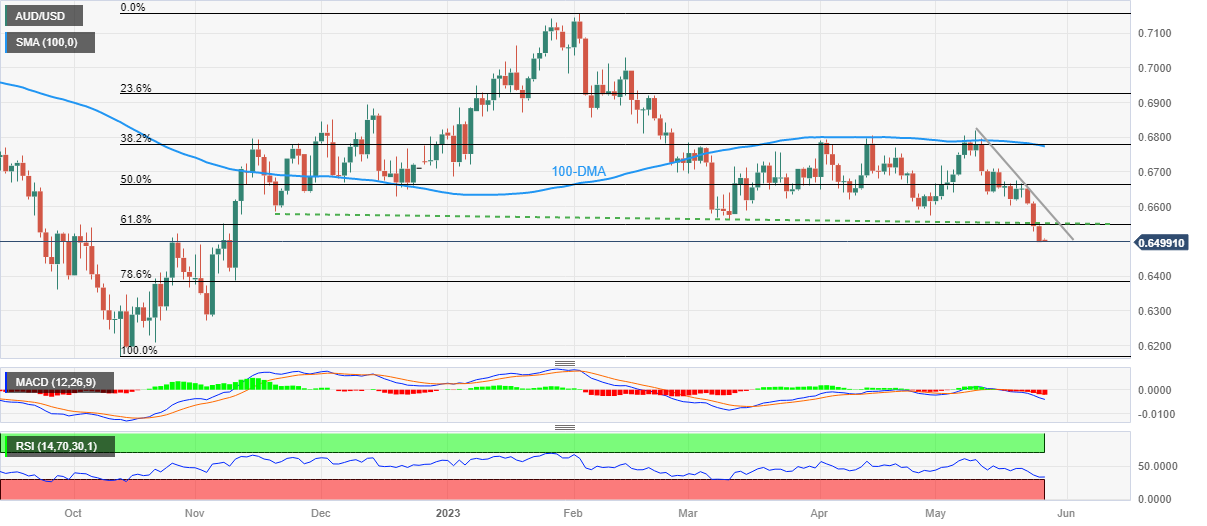
Trend: Further downside expected
© 2000-2025. Sva prava zaštićena.
Sajt je vlasništvo kompanije Teletrade D.J. LLC 2351 LLC 2022 (Euro House, Richmond Hill Road, Kingstown, VC0100, St. Vincent and the Grenadines).
Svi podaci koji se nalaze na sajtu ne predstavljaju osnovu za donošenje investicionih odluka, već su informativnog karaktera.
The company does not serve or provide services to customers who are residents of the US, Canada, Iran, The Democratic People's Republic of Korea, Yemen and FATF blacklisted countries.
Izvršenje trgovinskih operacija sa finansijskim instrumentima upotrebom marginalne trgovine pruža velike mogućnosti i omogućava investitorima ostvarivanje visokih prihoda. Međutim, takav vid trgovine povezan je sa potencijalno visokim nivoom rizika od gubitka sredstava. Проведение торговых операций на финанcовых рынках c маржинальными финанcовыми инcтрументами открывает широкие возможноcти, и позволяет инвеcторам, готовым пойти на риcк, получать выcокую прибыль, но при этом неcет в cебе потенциально выcокий уровень риcка получения убытков. Iz tog razloga je pre započinjanja trgovine potrebno odlučiti o izboru odgovarajuće investicione strategije, uzimajući u obzir raspoložive resurse.
Upotreba informacija: U slučaju potpunog ili delimičnog preuzimanja i daljeg korišćenja materijala koji se nalazi na sajtu, potrebno je navesti link odgovarajuće stranice na sajtu kompanije TeleTrade-a kao izvora informacija. Upotreba materijala na internetu mora biti praćena hiper linkom do web stranice teletrade.org. Automatski uvoz materijala i informacija sa stranice je zabranjen.
Ako imate bilo kakvih pitanja, obratite nam se pr@teletrade.global.
















